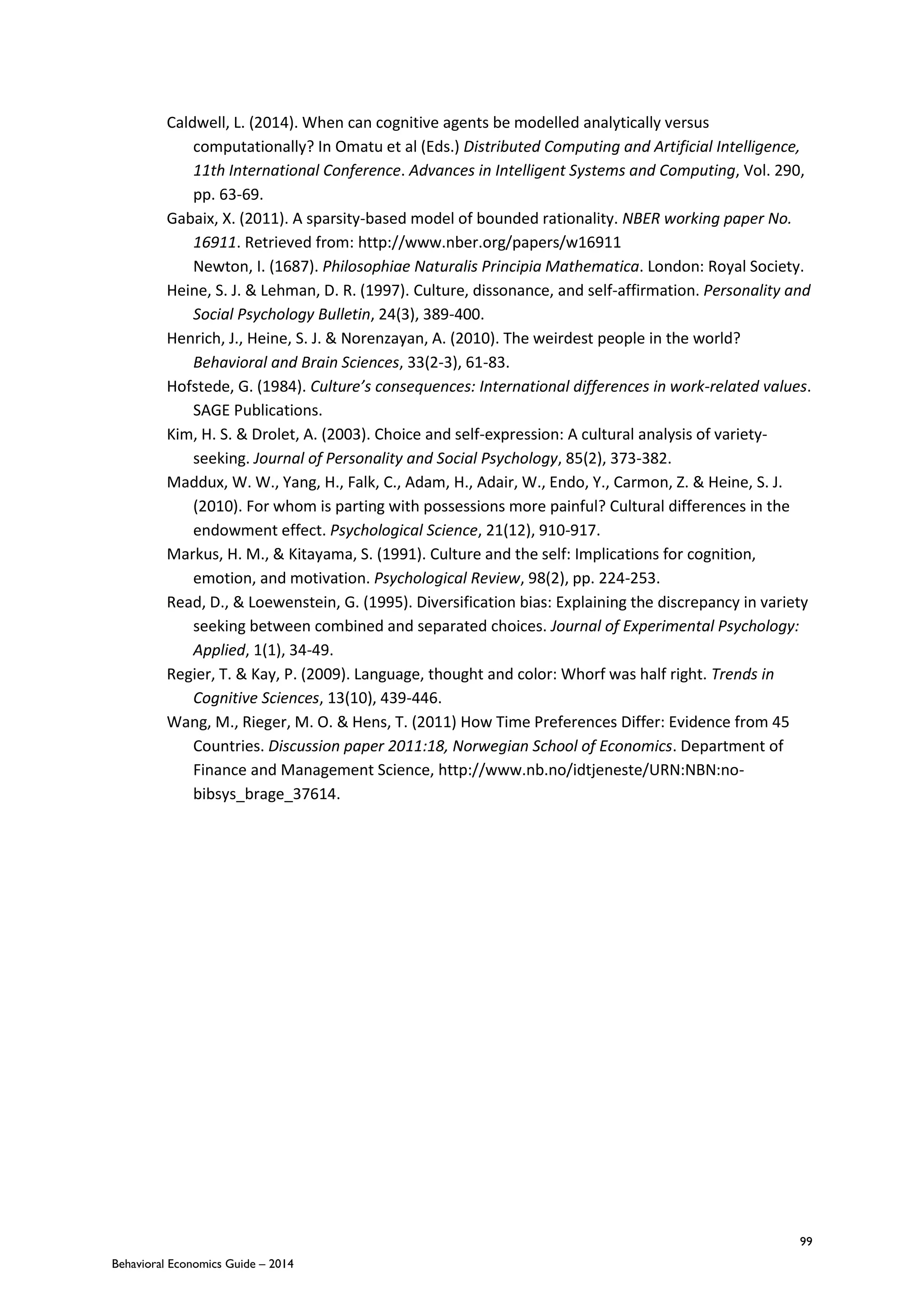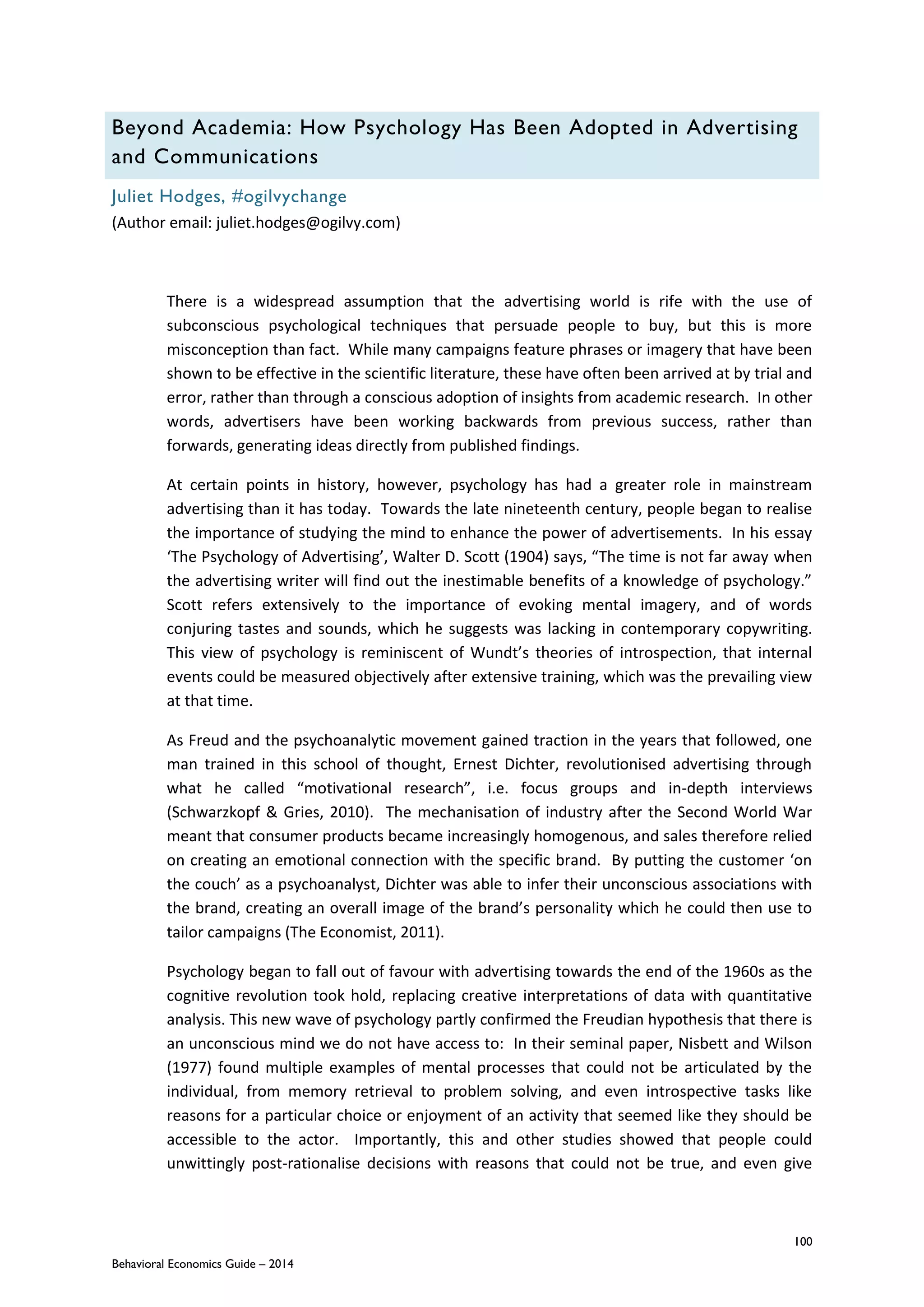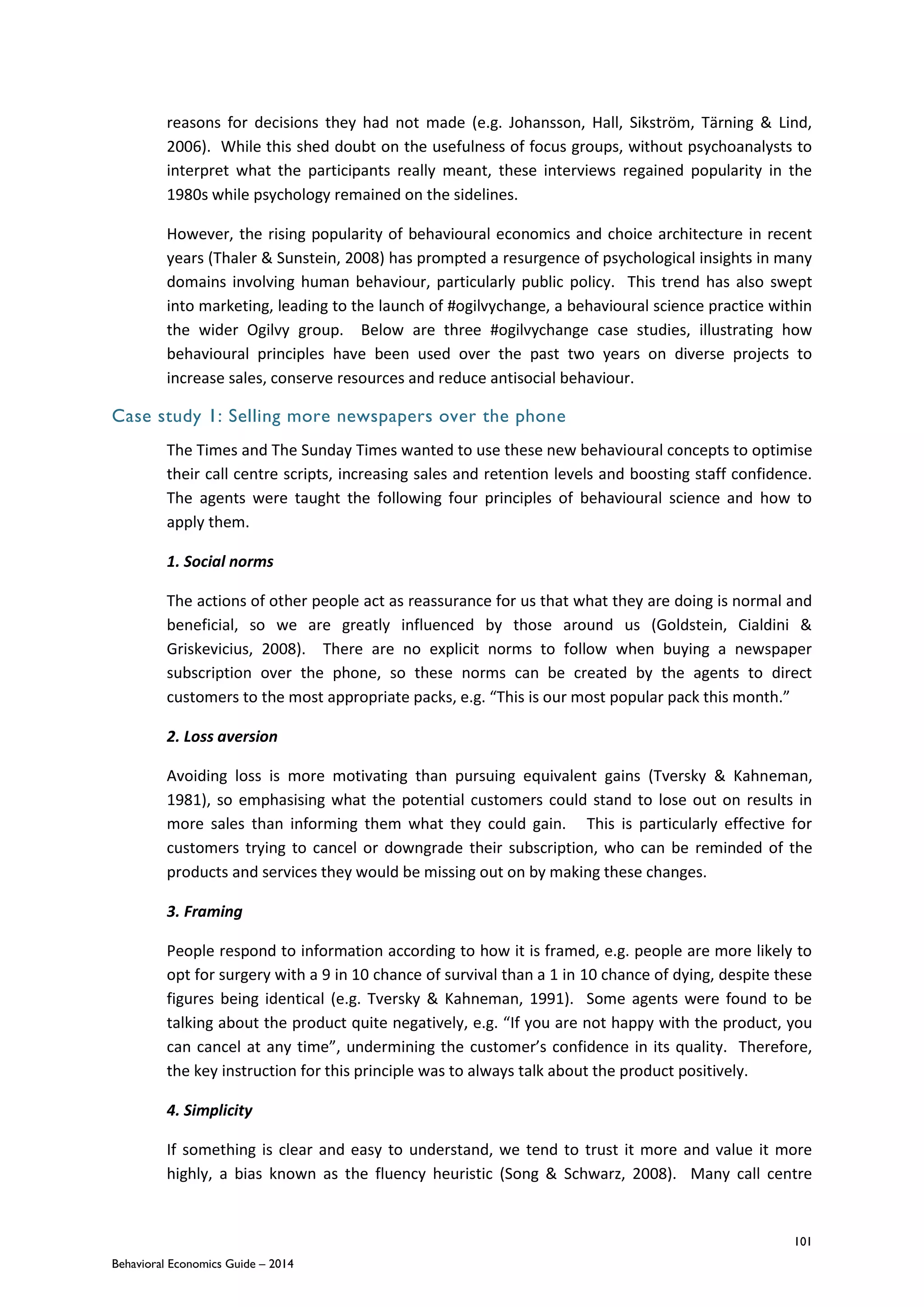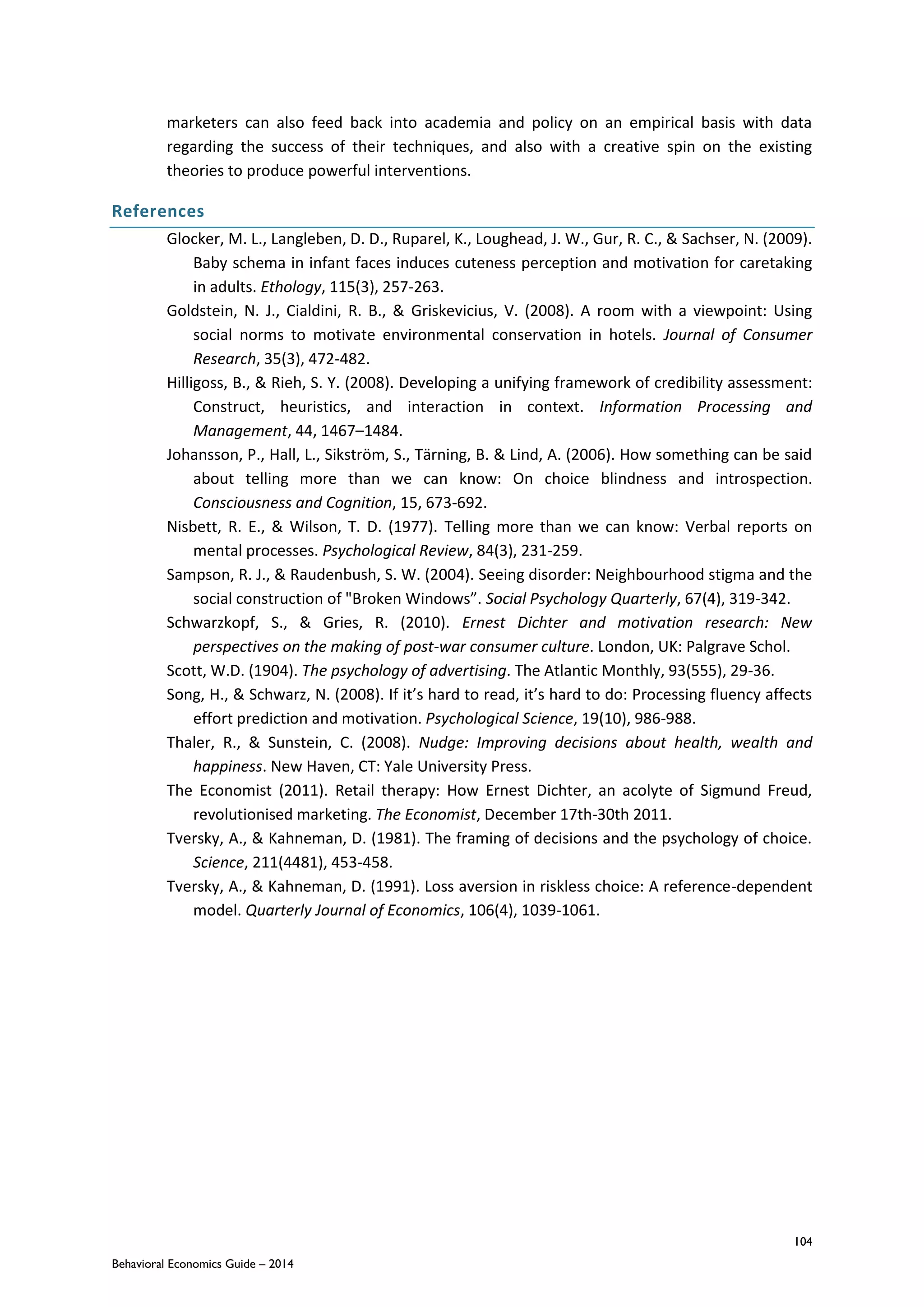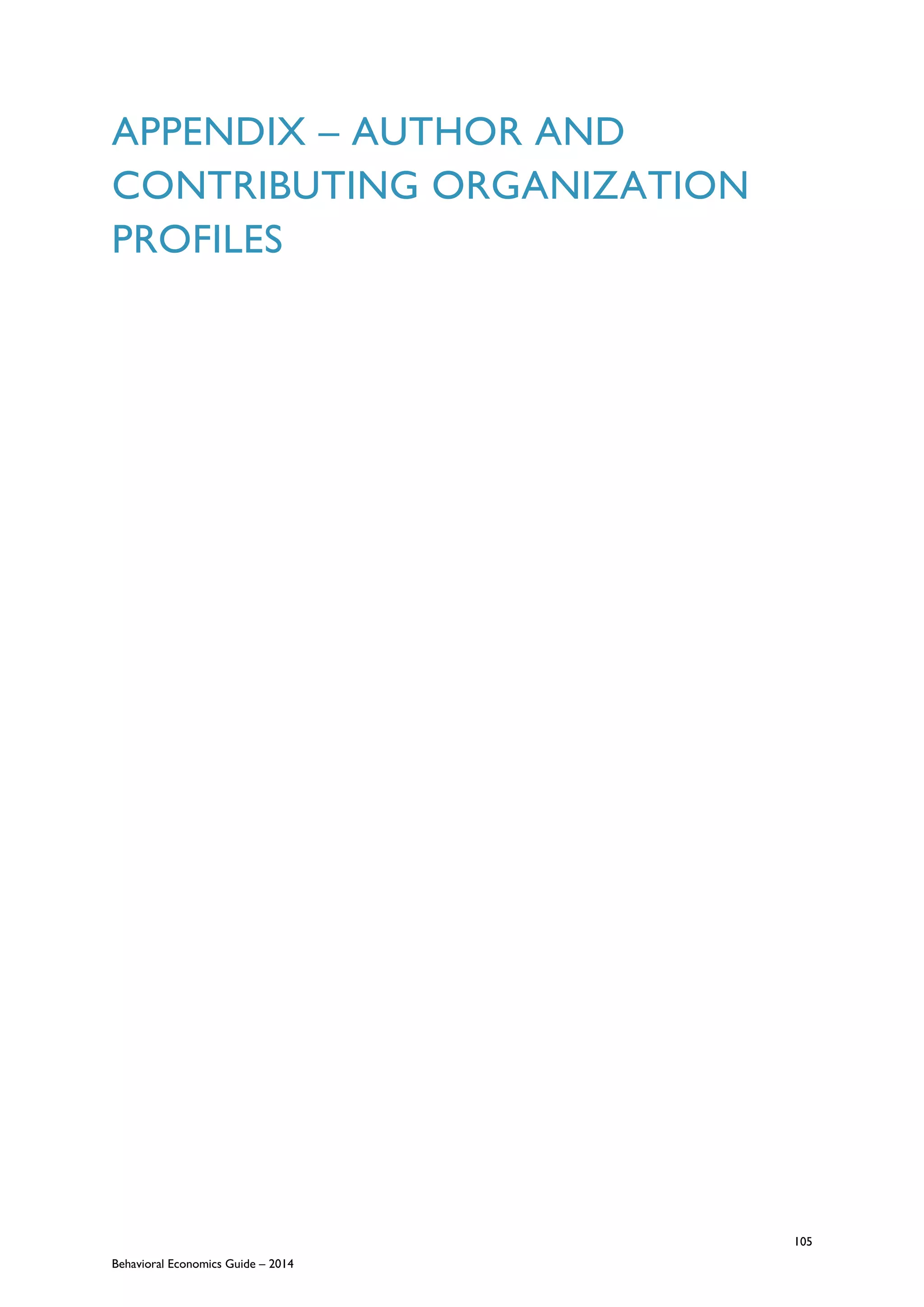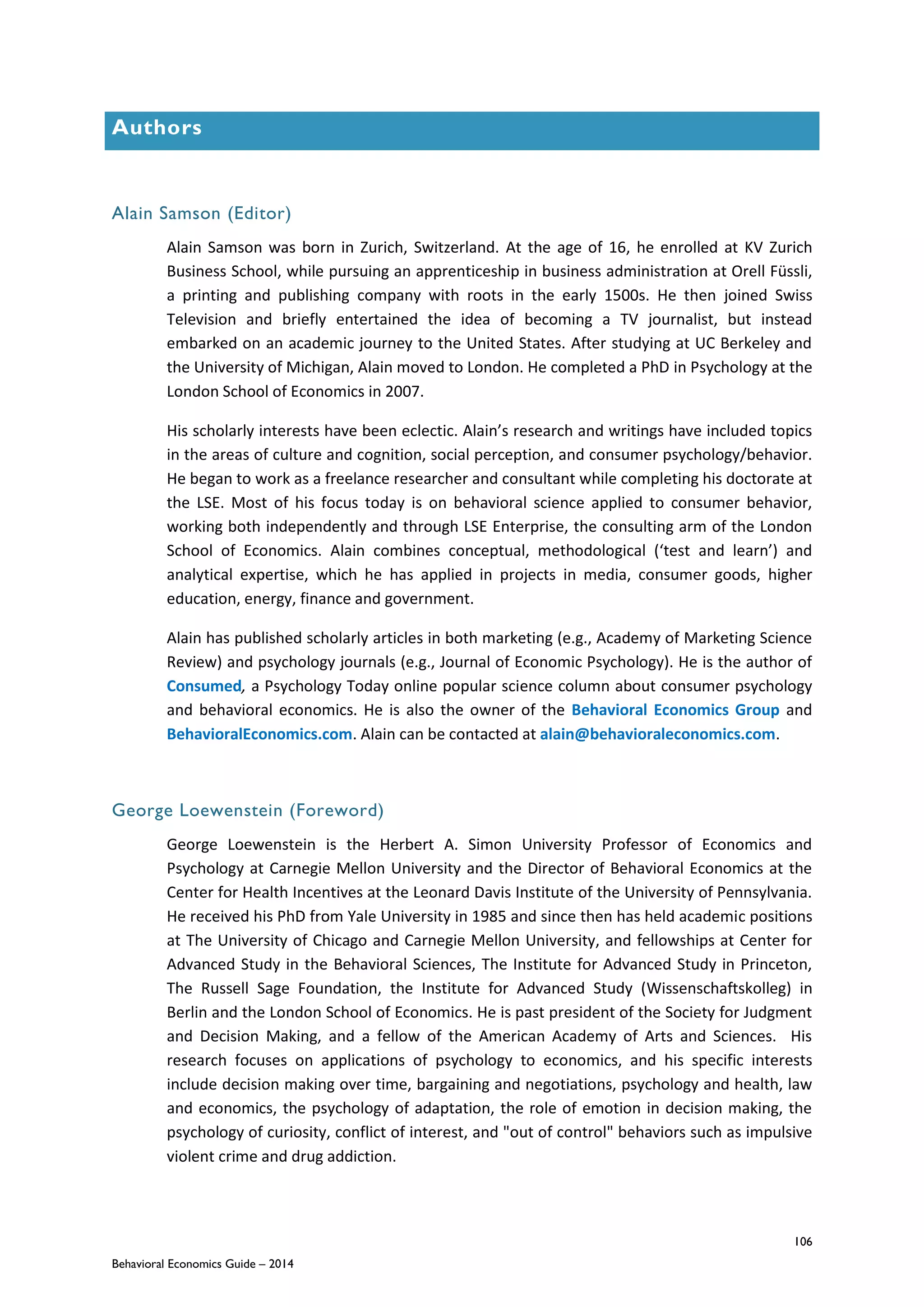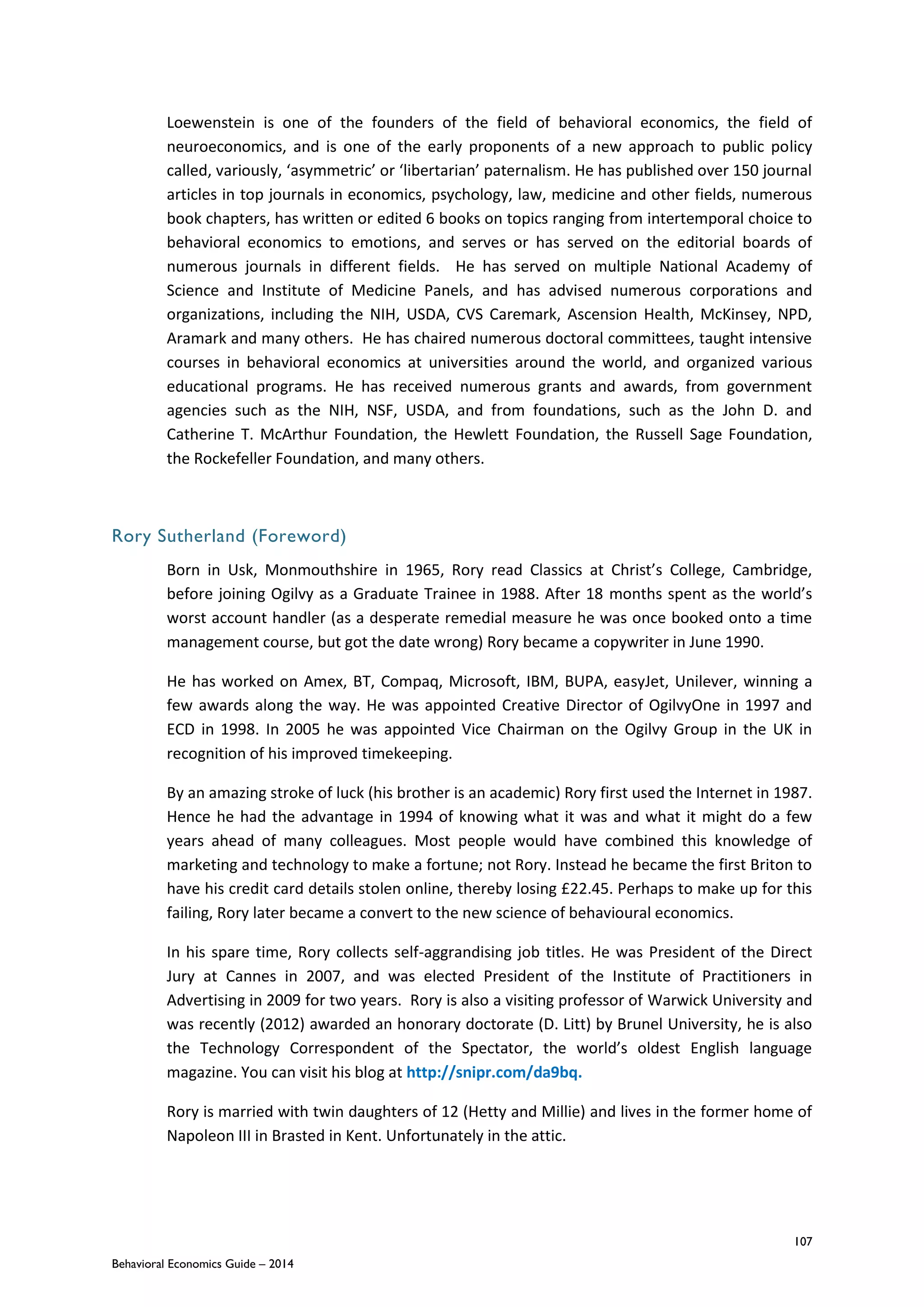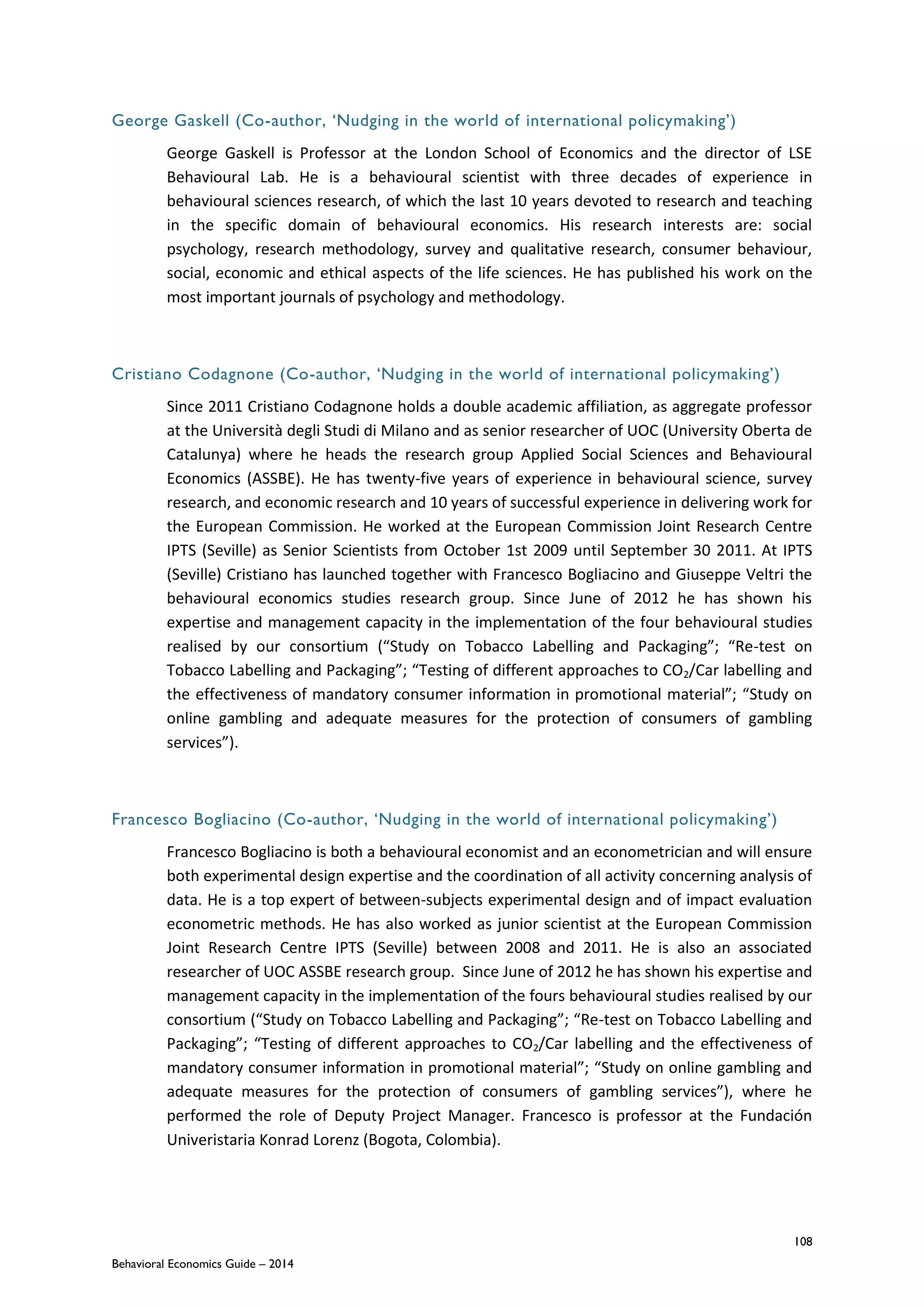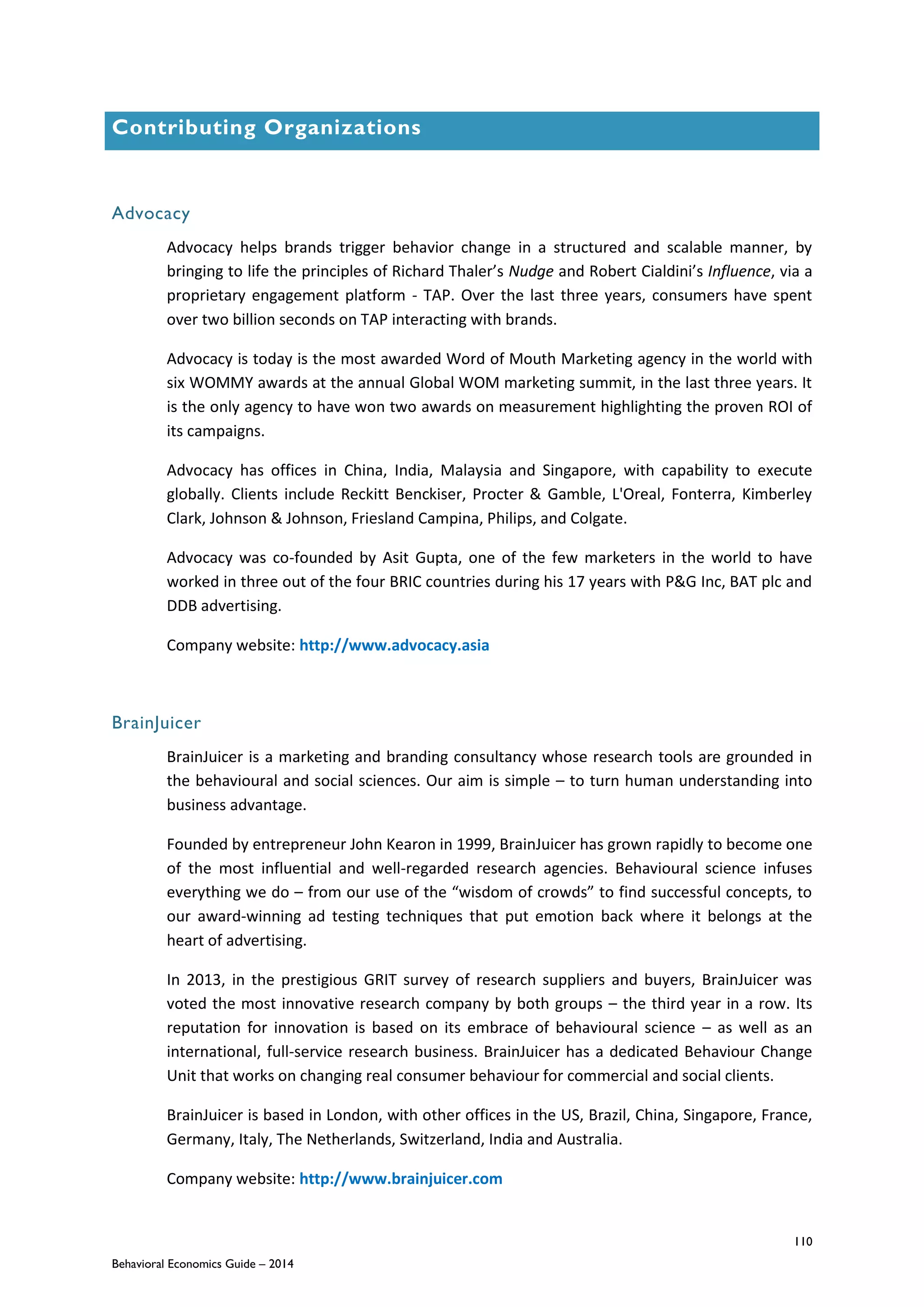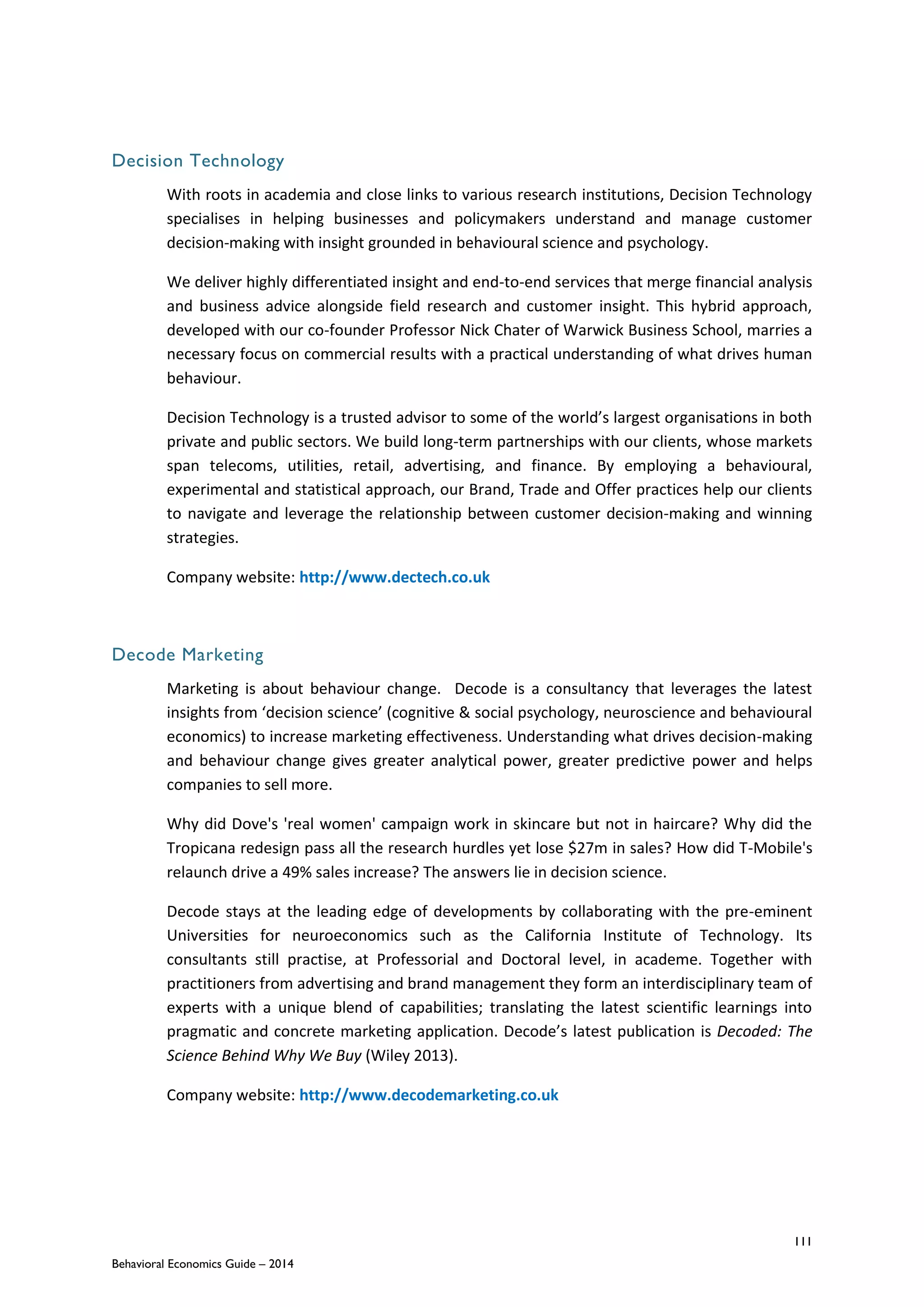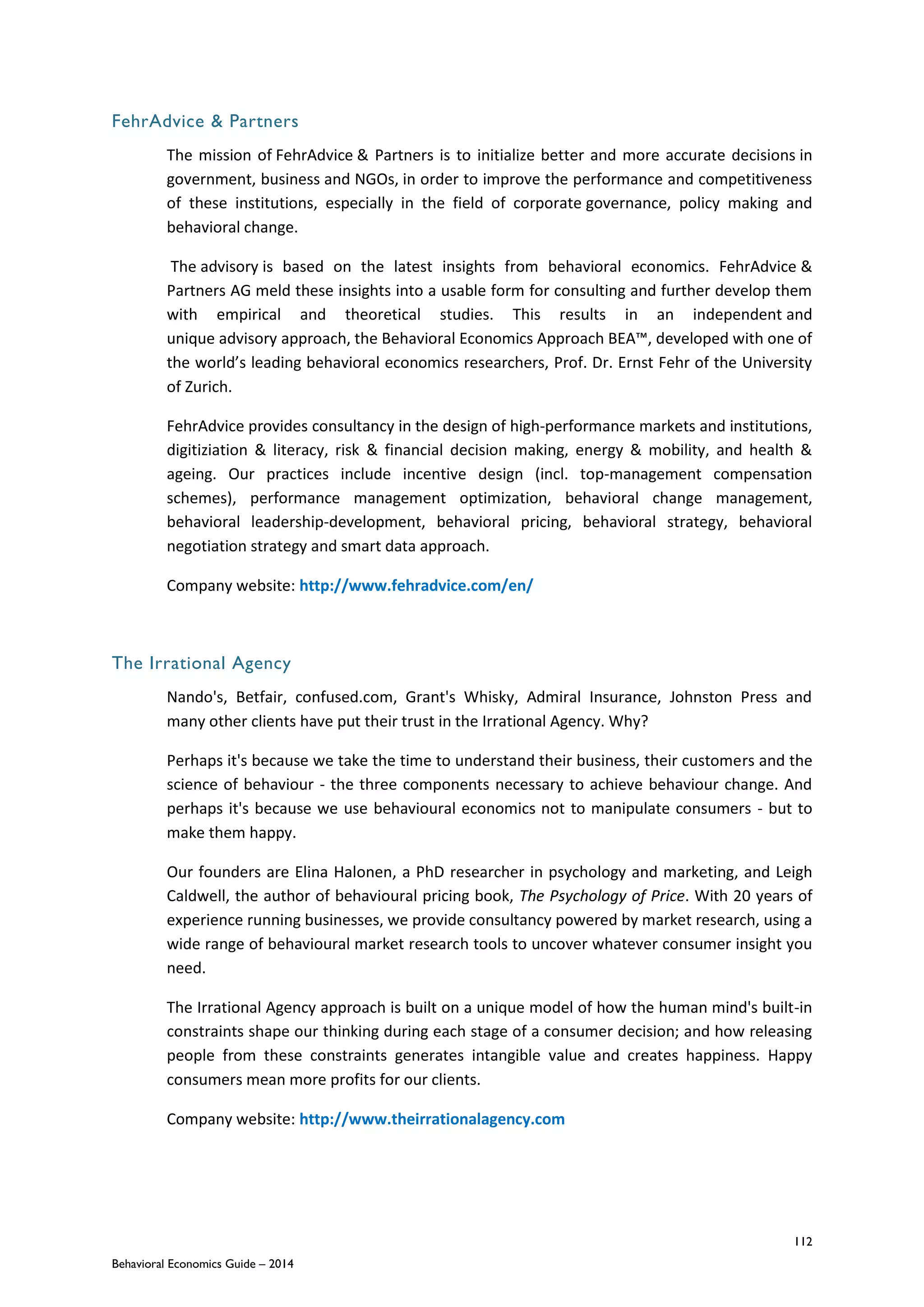The Behavioral Economics Guide 2014, edited by Alain Samson and featuring contributions from various authors, explores the principles and applications of behavioral economics, including concepts like prospect theory and nudging. It presents theoretical frameworks, practical implications, and resource listings for further study in the field. The foreword also features a discussion between George Loewenstein and Rory Sutherland on the subjective nature of valuation and the impact of advertising.
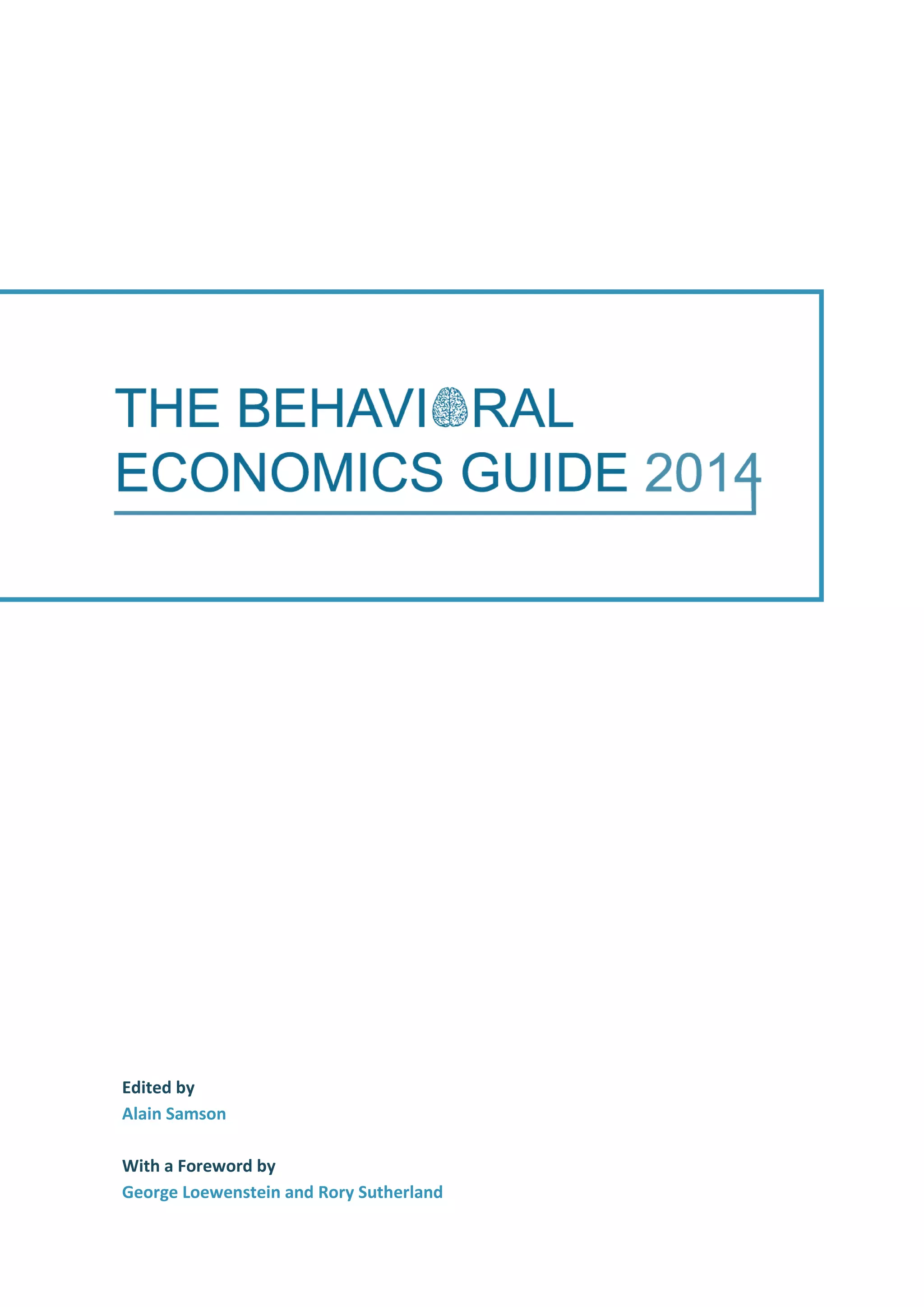
![II
Behavioral Economics Guide – 2014
The Behavioral Economics Guide 2014
1st
Edition
Author information:
Alain Samson (Editor)
George Loewenstein (Foreword)
Rory Sutherland (Foreword)
Phil Barden, Francesco Bogliacino, Leigh Caldwell, Cristiano Codagnone, Tom Ewing, Gerhard Fehr, George Gaskell,, Asit
Gupta, Elina Halonen, Juliet Hodges, Moritz Jäger, Alain Kamm, John Kearon, Francisco Lupiáñez-Villanueva, Henry Stott,
Giuseppe A. Veltri (Contributing authors)
Design and layout by Elina Halonen. Cover design adapted from Tilly Patsalis. Proofing by Mark Jones and Leigh Caldwell.
Copyright © by the authors
All Rights Reserved
Requests for permission to reproduce materials from this work should be sent to alain@behavioraleconomics.com or
directly to contributing authors.
Suggested citation:
Samson, A. (Ed.)(2014). The Behavioral Economics Guide 2014 (with a foreword by George Loewenstein and Rory Sutherland) (1st ed.). Retrieved
from http://www.behavioraleconomics.com.
Suggested citation for individual sections/authors:
[Author(s)] (2014). [Chapter/Section Title]. In A. Samson (Ed.), The Behavioral Economics Guide 2014 (with a foreword by George Loewenstein
and Rory Sutherland) (1st ed.)(pp. nn-nn). Retrieved from http://www.behavioraleconomics.com.](https://image.slidesharecdn.com/beguide2014-140726231619-phpapp02/75/THE-BEHAVIORAL-ECONOMICS-GUIDE-2014-2-2048.jpg)
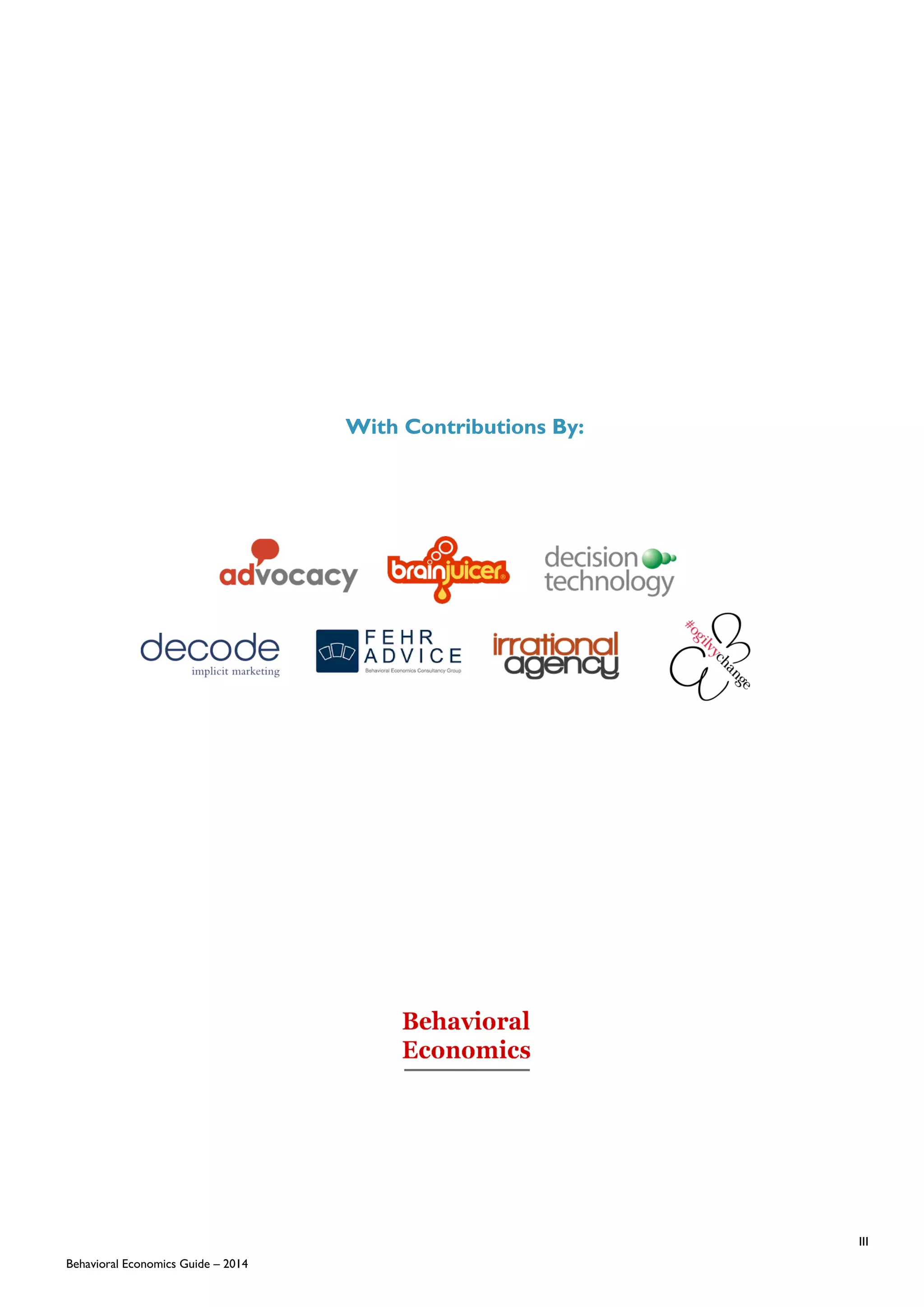
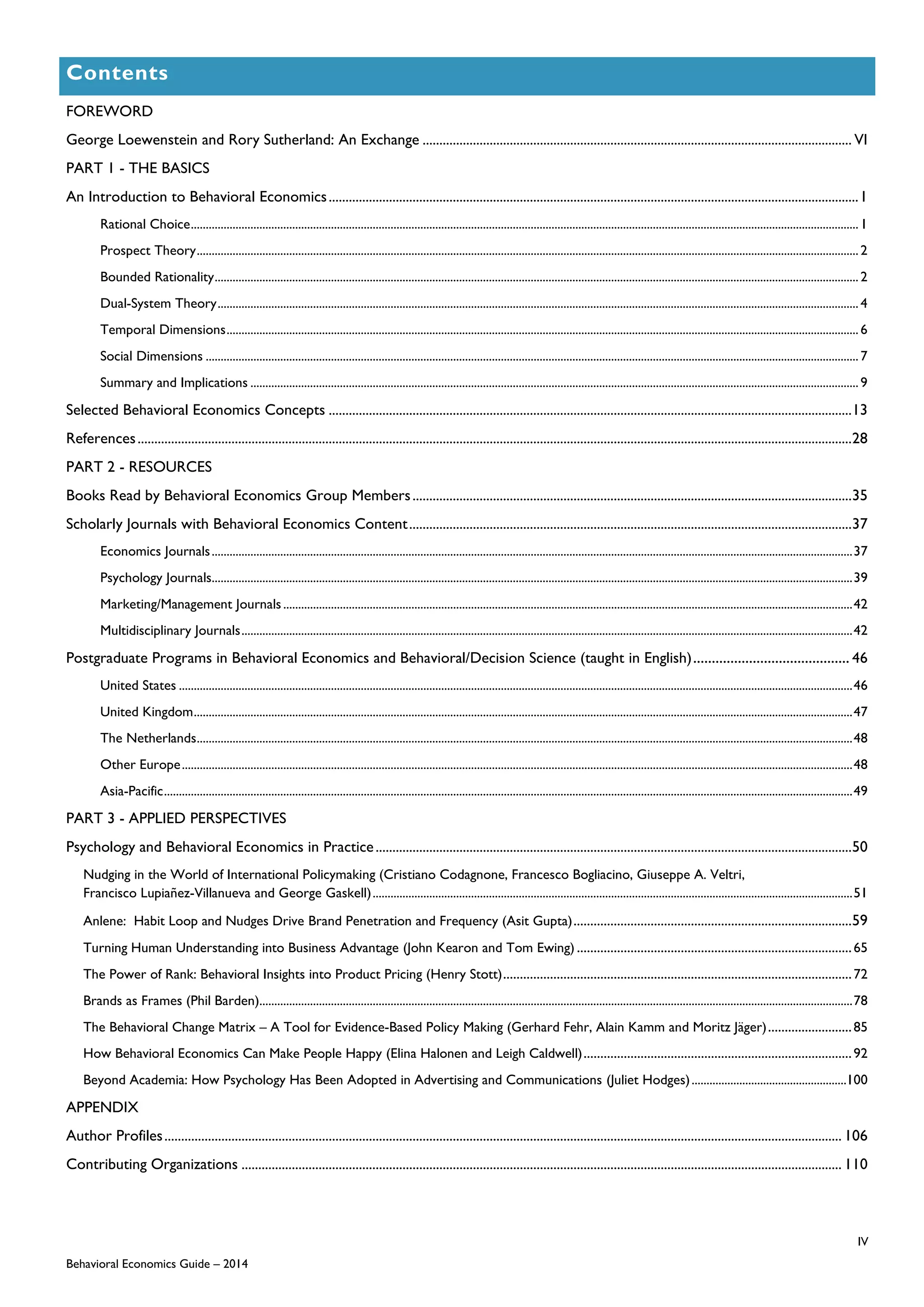
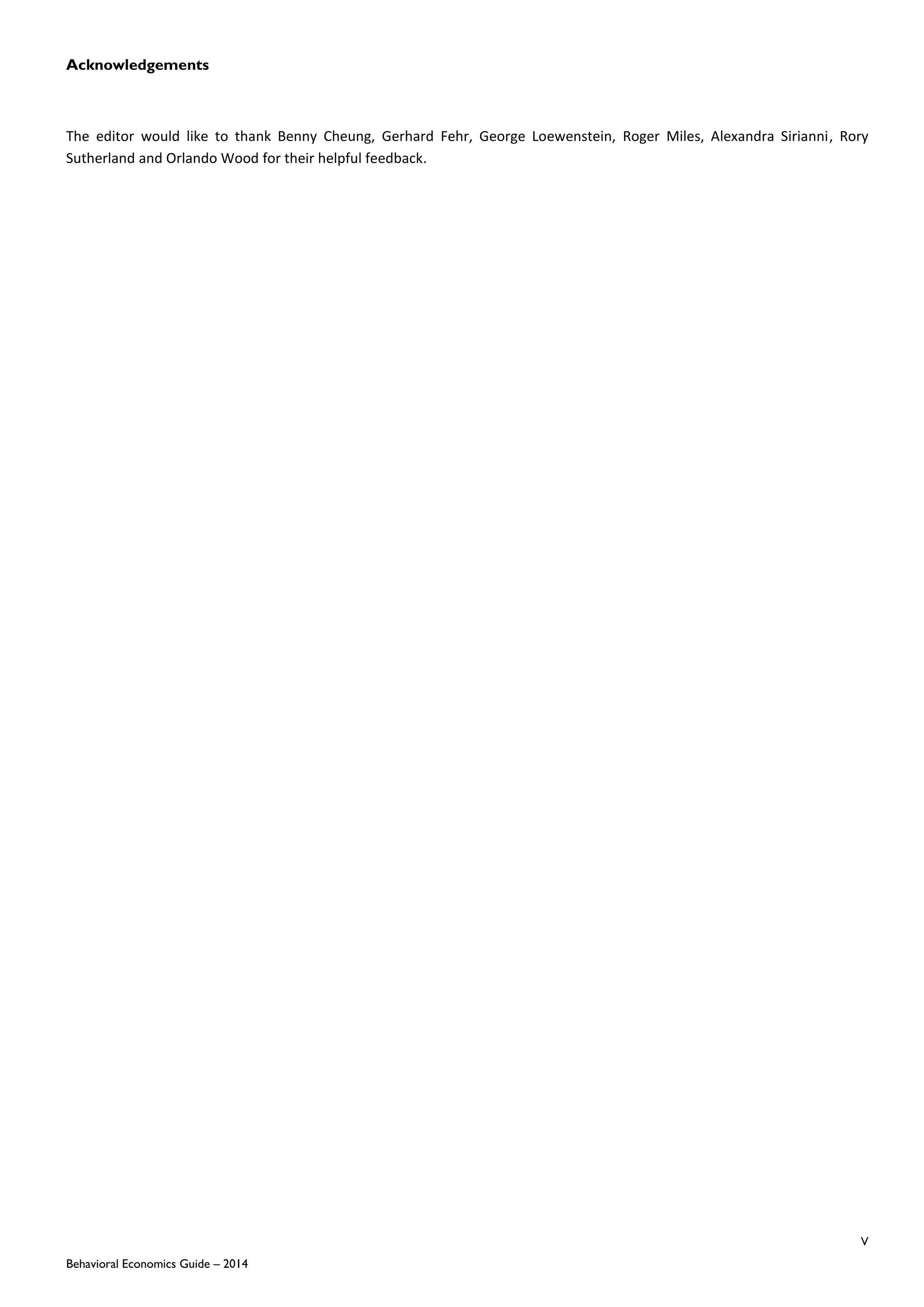
![VI
Behavioral Economics Guide – 2014
FOREWORD
George Loewenstein and Rory Sutherland: An Exchange
George Loewenstein to Rory Sutherland:
Dear Rory,
As you know, Alain Samson asked us to write a foreword for his Behavioral Economics (BE) Guide,
hoping to gain the perspective of two people applying the science (if I can be so presumptuous) of
BE in the academic/public and private sectors. I’m sure that Alain would appreciate some colorful
fireworks to illuminate his guide, so, as the representative of academia, let me begin with a
challenge:
I’ve researched many topics in my long academic career, and my latest research topic has been Rory
Sutherland. Watching your many TED talks and reading your pieces in The Spectator has not only
been incredibly stimulating but, I must say, a lot more entertaining than my usual academic
research. Your TED talks should be required viewing for any graduate student in search of novel,
important research topics.
In working my way through your talks I was searching, as social scientists are prone to do, for a
central, unifying theme, and it turned out to be a fairly easy task. A—the?—central theme of much
of your work, and one that you allude to in every one of your presentations, is the idea that our
perception of, and reaction to, reality is subjective. How you feel about products, or even about
your life, is at least as important, and probably much more important, than the product or your life’s
objective characteristics.
This is an idea I can embrace, because it’s been a central theme in my own work. In research on
‘coherent arbitrariness’ [see also ‘anchoring’] with Dan Ariely and Drazen Prelec we find that people
often have little idea about how much they like, or how to value, goods and experiences. We even
identify experiences which are sufficiently ambiguous that people can easily be persuaded that the
same experience is either good (in which case subjects are willing to pay to experience them, and
more so if they are longer) or bad (in which case subjects demand to be paid to put up with them,
and more so if they are longer). In another line of research, on hedonic adaptation (much of it with
Peter Ubel and reviewed in a paper with Shane Frederick), we find that people are able to adapt to a
very wide range of experiences. Adaptation, again, drives a wedge between the objective
characteristics of an experience and people’s hedonic reactions to it. In research on ‘source
dependence’, with Sam Issacharoff, and ‘history of ownership effects’, with Michel Strahilevitz, we
find that how you obtain an object and how long you own it are both important determinants of
value, over and above the object’s objective characteristics. In diverse research on the impact of
relative comparisons, my colleagues and I find support for the idea, highlighted in many of your
talks, that almost all judgments are relative. And, in a series of thought pieces, I have written about
the importance of meaning in people’s lives and the malleability of what matters—what people
value.
Many of the sections of Samson’s guide to behavioral economics also reflect this theme, beginning
with the first, on Prospect Theory (which posits that judgments of value are relative) and its](https://image.slidesharecdn.com/beguide2014-140726231619-phpapp02/75/THE-BEHAVIORAL-ECONOMICS-GUIDE-2014-6-2048.jpg)
![VII
Behavioral Economics Guide – 2014
extension to framing effects. The sections on Availability and Salience highlight the observation that
how one thinks about a decision, and the judgments one makes in support of the decision (e.g. of
the probabilities of different consequences), is often highly malleable. Research on the status quo
bias and inertia also highlights the arbitrariness of many decisions by demonstrating their
dependence on defaults, due to the tremendous attractiveness of doing nothing, i.e. deciding by not
deciding (to paraphrase a famous word poster from the 1970s). It would be easy to extend this list
with other subsections of Samson’s compilation of concepts on anchoring effects, the affect
heuristic, diversification bias, hot-cold empathy gaps, and partitioning effects.
So far so good. Where we begin to part ways, Rory, is in the implications we draw from this central
insight regarding the subjectivity of valuation and experience. The conclusions you draw are far
more optimistic than those that I draw, and (not surprisingly) far more positive about the role of
advertising and marketing.
Is the fact that perceptions matter more than reality a good thing or a bad thing? In some situations,
I believe, it is arguably a very bad thing. To make my point, let me just focus on one of the factors
that drives a wedge between the objective and the subjective: Adaptation. Adaptation is almost
certainly, in the net, a good thing. Pain, hunger, sexual deprivation, and other forms of misery are
signals that evolved to motivate behaviors that promote survival and reproduction. If the signal,
such as hunger, has been in force for an extended period, but we have failed to take actions to
eliminate it, it almost surely indicates that we are unable to do so or have consciously decided that
it’s not worth it. In that case the signal serves no further function, and nature has mercifully evolved
a mechanism—hedonic adaptation—to eliminate it. An organism that doesn’t adapt hedonically will
not survive for long; yet, adaptation has diverse downsides.
The most obvious ‘cost’ of hedonic adaptation is that it occurs for goods as well as bads, creating the
‘hedonic treadmill’ that prevents us from enjoying whatever successes we may achieve in life.
Adaptation to pleasurable experiences may also be responsible for destructive addictions, which are
due in part to the decreasing pleasure taken from a given level of a good or activity and in part to
the displeasure (craving)—which increases in intensity the longer and more we have been
indulging—experienced when consumption of the good or activity ceases.
Also, as a result of adaptation, we can become inured to, and complacent in accepting,
circumstances that in the long run are not good for us. Well before we became collectively aware of
the horrendous threat of climate change, Dubos (1965:278-279) wrote prophetically that “this very
adaptability enables [us] to become adjusted to conditions and habits which will eventually destroy
the values most characteristic of human life.”
Adaptation may work against moral values as well. In his book ‘Nazi Doctors’, R.J. Lifton (1990)
describes a process whereby German doctors (who had taken the Hippocratic Oath to do no harm)
were gradually transformed into active killers, and Christopher Browning documented, in his book
‘Ordinary Men’, a similar process among German ‘Police Orders’ in Poland. In the famous Milgram
experiment, subjects were not asked to instantly administer a potentially lethal shock but were
given a series of requests to increase the voltage slightly. Having just administered a 100 volt shock
to someone, administering a shock of 105 volts doesn’t seem all that much worse.](https://image.slidesharecdn.com/beguide2014-140726231619-phpapp02/75/THE-BEHAVIORAL-ECONOMICS-GUIDE-2014-7-2048.jpg)
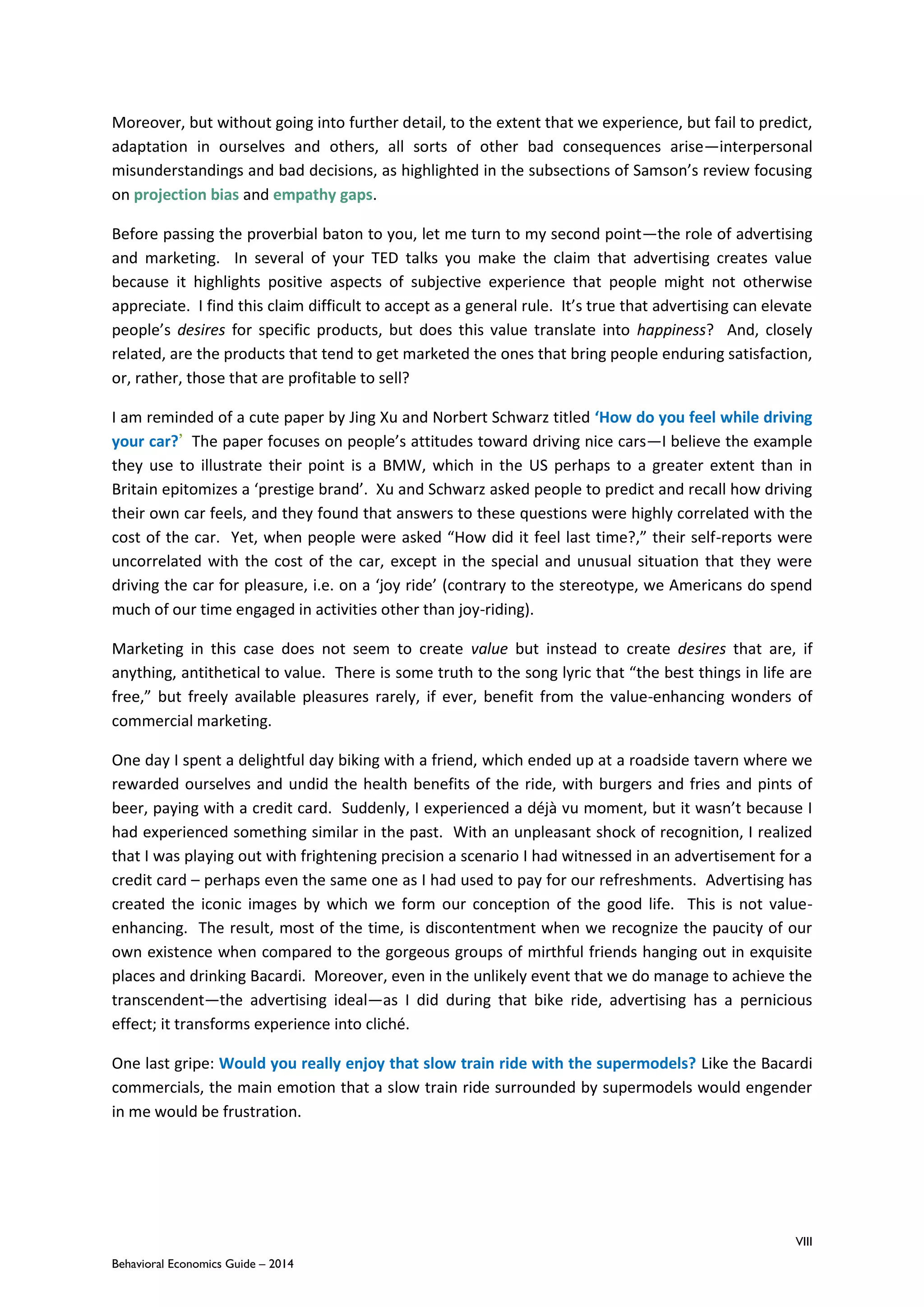
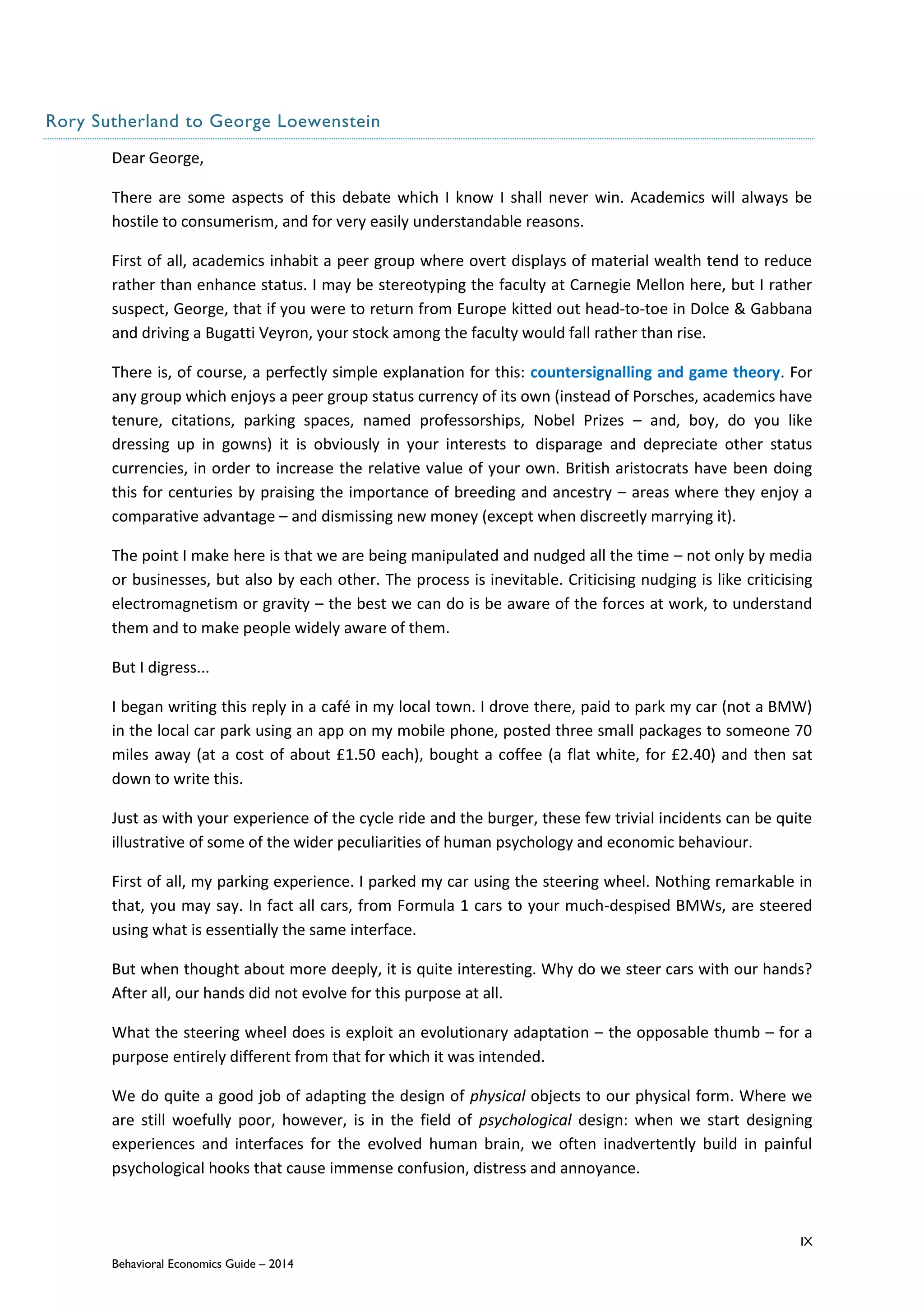

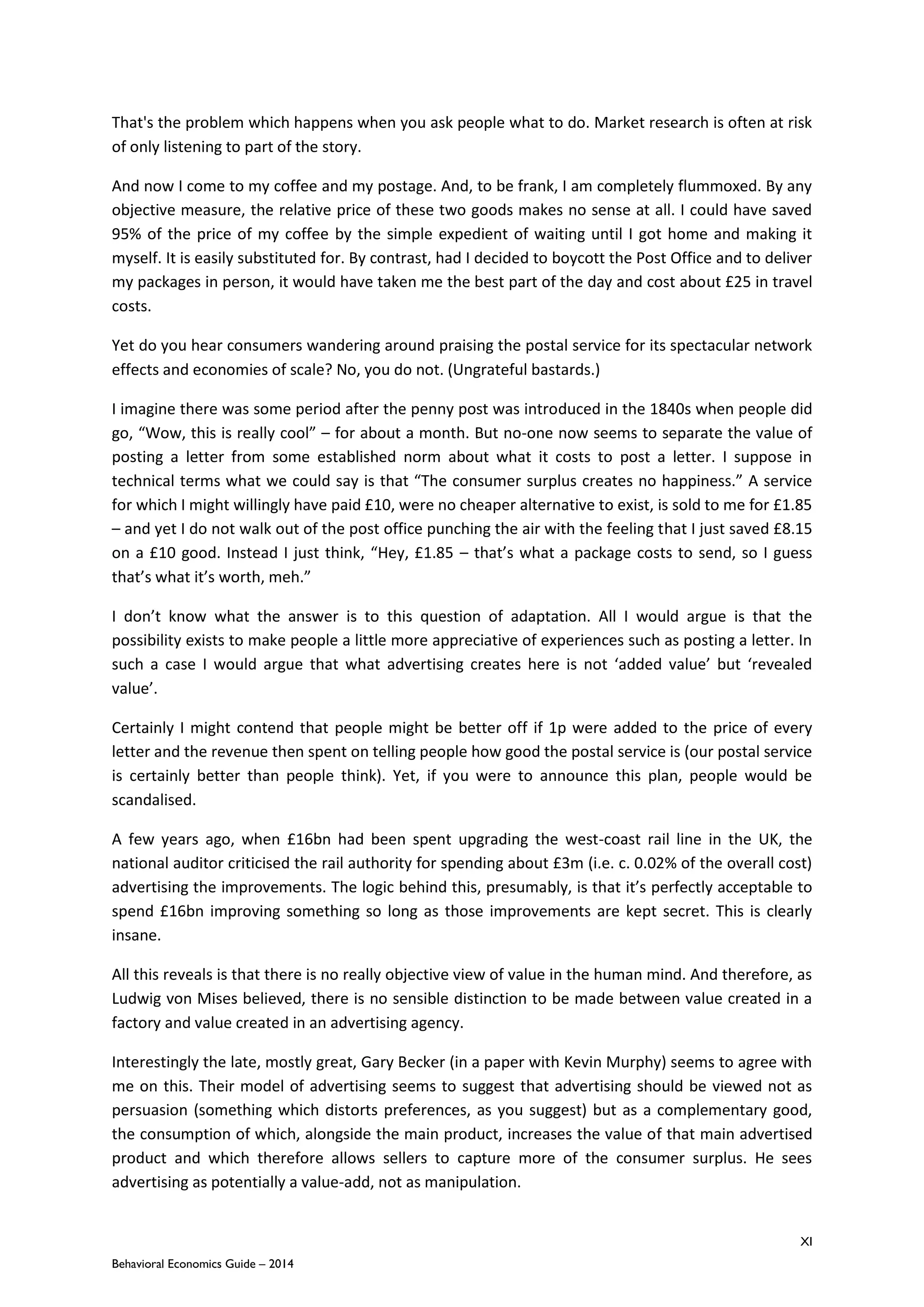
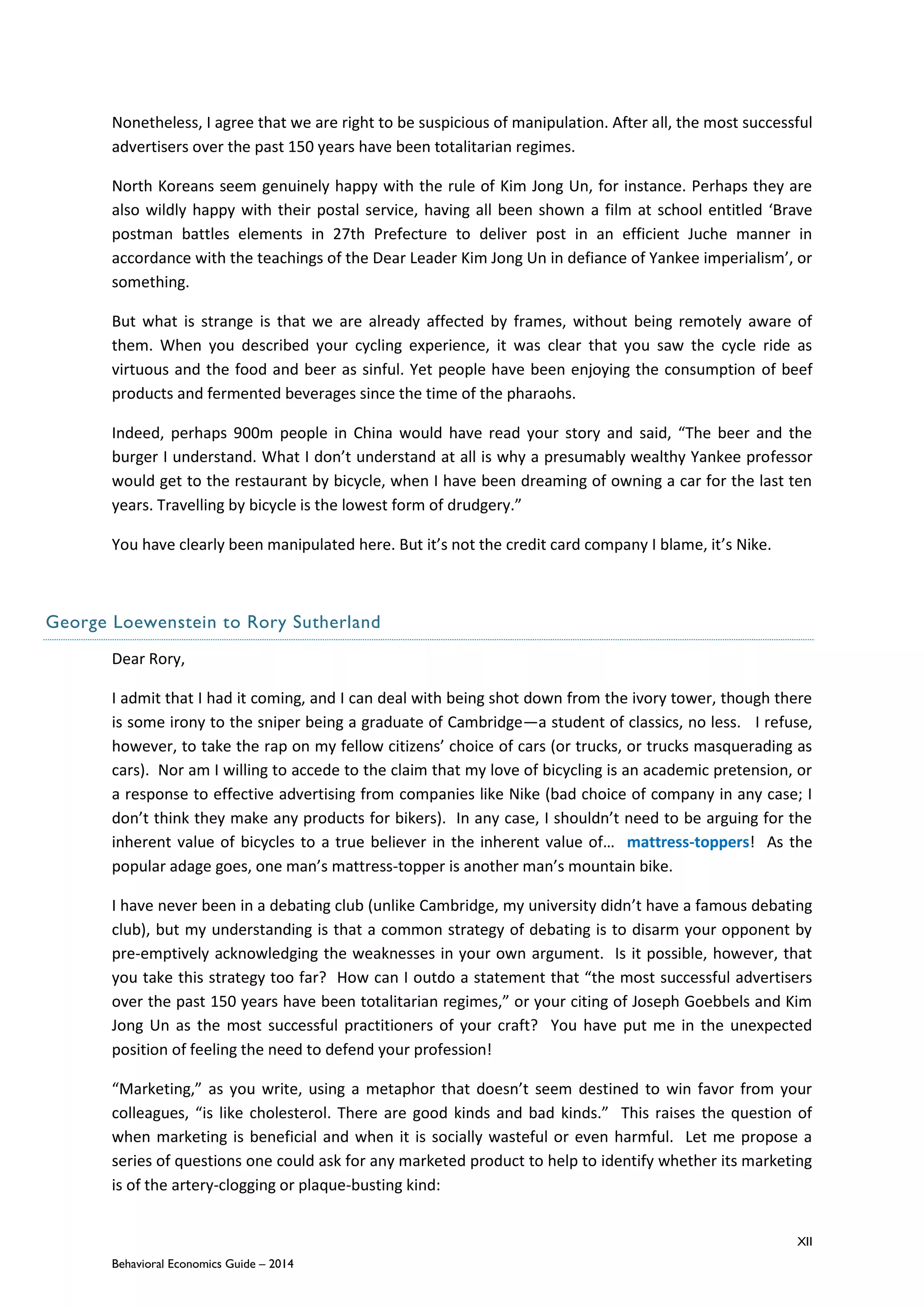
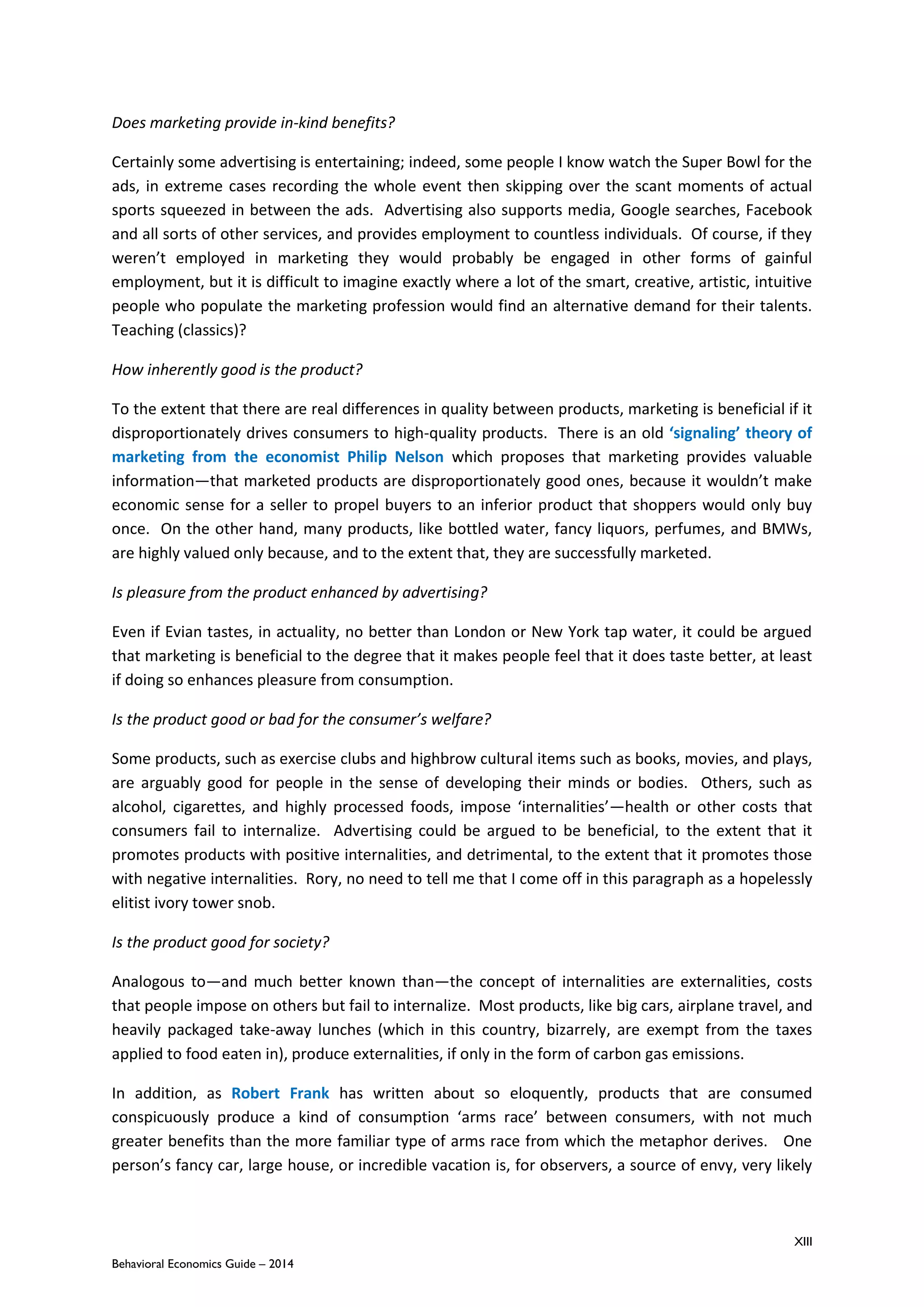
![XIV
Behavioral Economics Guide – 2014
driving them to competing conspicuous purchases in a never-ending cycle that promotes waste,
encourages debt, and discourages saving (neither of which is typically observable by others).
What are the market forces?
Another form of arms race occurs in the commercial sphere. An increase in one company’s
marketing forces other companies to also increase their own marketing, or risk losing business. The
end result may be a huge boon to marketers, but it is of questionable value to consumers or society
as a whole.
Rory, to quote an esteemed ad-man, “I digress.” Whatever our differences over the merits of our
respective professions, we clearly agree on one point, the value of behavioral economics, and on a
second point, the value of the online resource that Alain Samson has created to provide academics,
practitioners, and anyone else with an interest in expanding their intellectual horizons with an
entrée to the topic. After you respond, if you choose, to these comments, and hopefully answer my
question about whether you would really like to take a long, slow train to Paris surrounded by
supermodels, I propose that we channel any reader we haven’t lost long ago to what they
presumably came to this guide in search of.
Rory Sutherland to George Loewenstein
Dear George,
I entirely agree. And you’re making me feel guilty now.
And thank you for pointing me in the direction of Phillip Nelson. I did not realise that Nelson was the
original coiner of the phrases “search good” and “experience good.” (A mattress-topper, by the way,
is very much an experience good. Until you own one, you cannot conceive of any reason for buying
one at all).
He was also the source of this quotation: “What makes the advertising issue fascinating... is that it is
fundamentally an issue in how to establish truth in economics.”
And it has to be said that economics has always found it difficult to understand marketing at all.
This was written in 1924 by Pigou: “Under simple competition there is no purpose in [....]
advertisement since, ex hypothesi, the market will take, at the market price, as much as any small
seller wishes to sell.” Once you assume that consumers have fixed preferences and perfect
information, and you really have created an imaginary economic model where there is no role for
any marketing activity at all.
But the real problem is not really so much that modern economists don’t realise that economics is a
much more complex enterprise than the simple 100-year-old neo-classical model suggests. The
larger problem may be the model of economics which persists in government, in business schools
and in business itself.
The real problem with this model is the other things it leaves out: it is, essentially, a model which is
trust-free, psychology-free, context-free, relationship-free and ethics-free.](https://image.slidesharecdn.com/beguide2014-140726231619-phpapp02/75/THE-BEHAVIORAL-ECONOMICS-GUIDE-2014-14-2048.jpg)
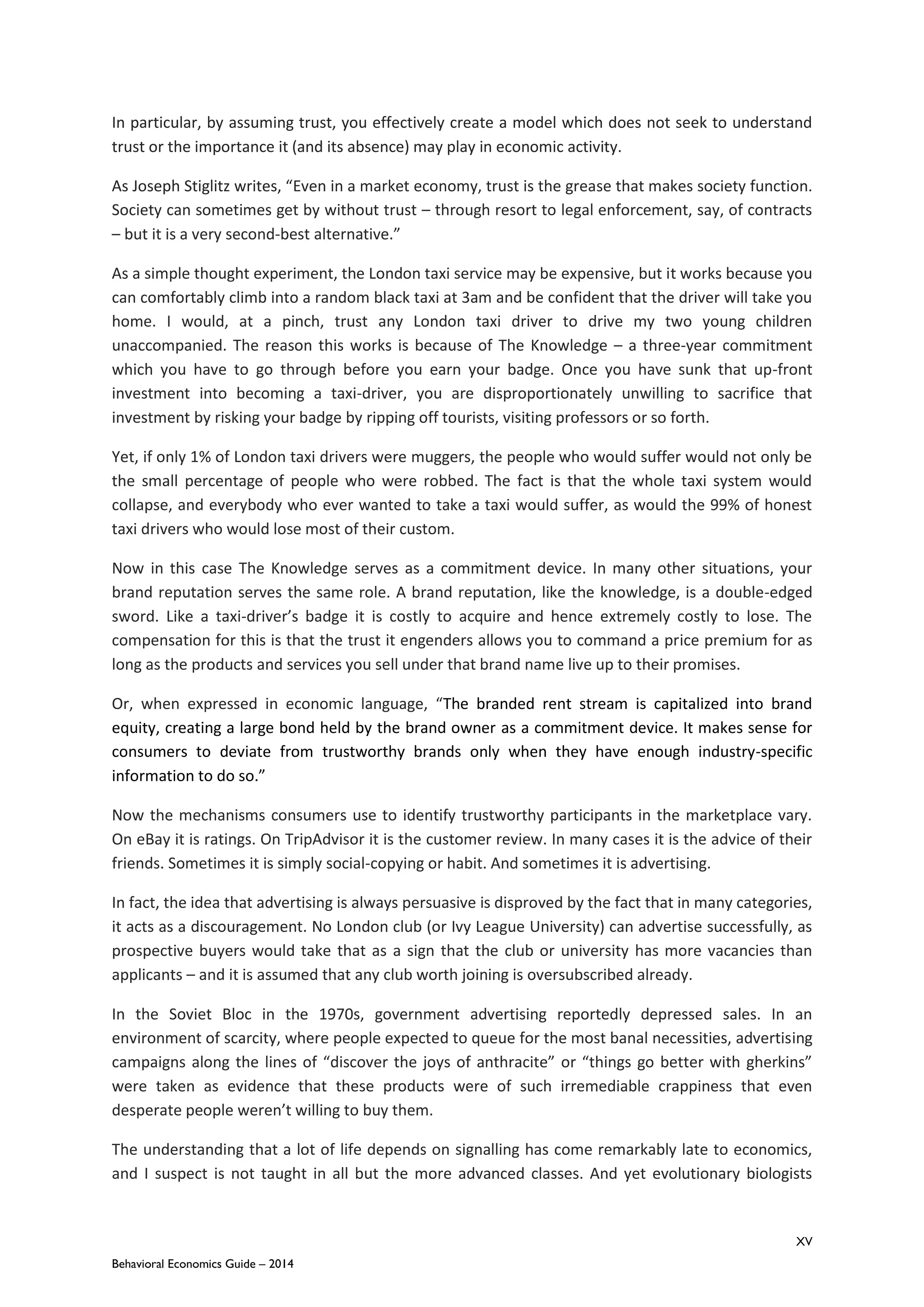
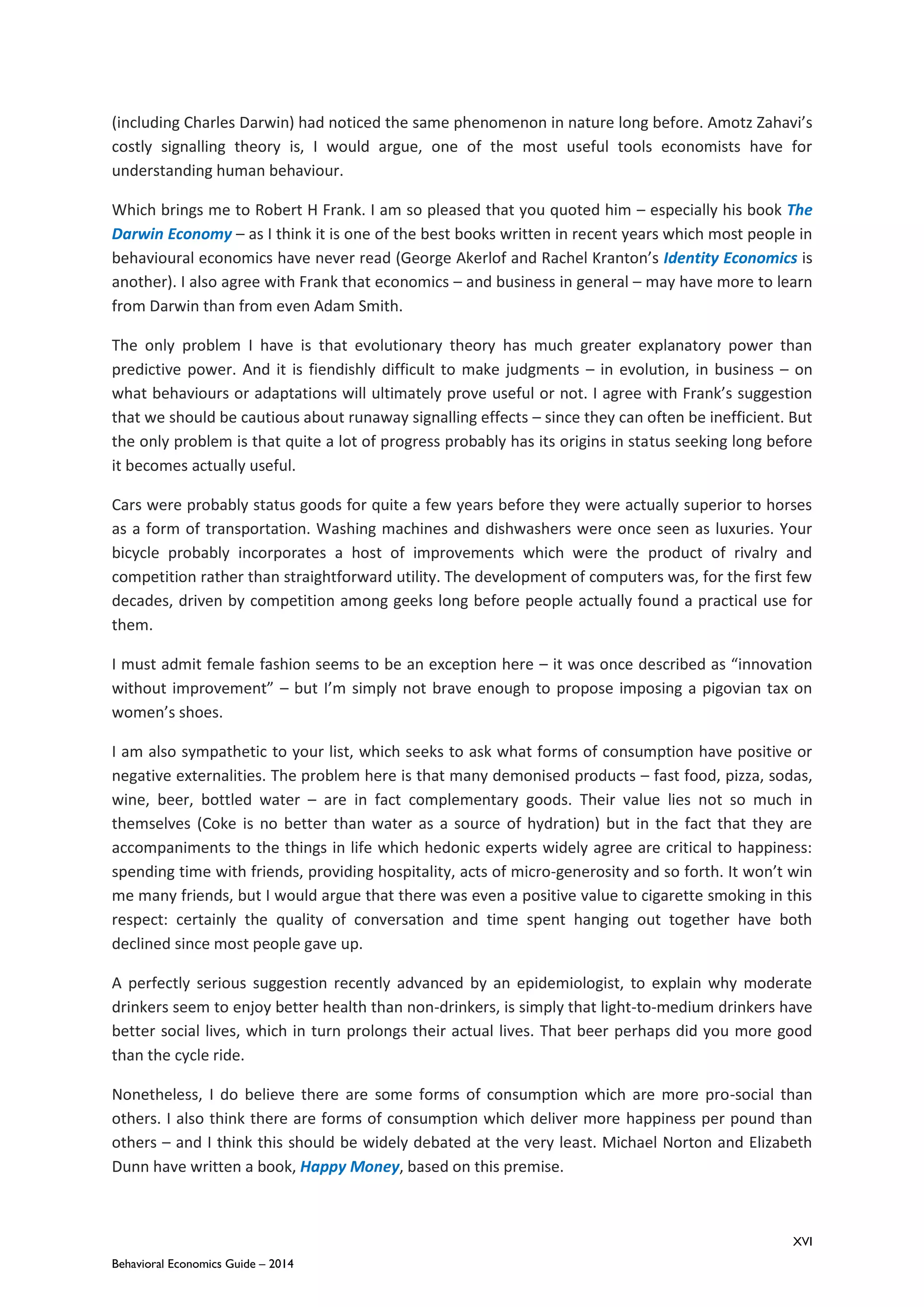
![XVII
Behavioral Economics Guide – 2014
I’ll end with two more things. I admit I have been wary about marketing’s power to mislead when
deployed by totalitarian regimes. But there is an interesting question here: totalitarian regimes do a
terrible job of marketing products but a very good job of marketing themselves – something that’s
easy, I suppose, when you have a 100% share of voice. But free market capitalism seems to do the
opposite: it is very good at marketing products and services, but very bad at getting people to see
the value in the system itself.
Finally, I think that the adoption of just a few principles from behavioural economics into business
and government thinking can have a significant effect on human wellbeing and economic progress
over the next ten years. The vital thing is that this happens fast. In general the speed of adoption of
ideas from the social sciences seems to be measured in decades at best, centuries at worst.
At the very simplest these are:
1) Small changes can have large effects
2) Psychology is really important.
3) People can’t always explain why they do what they do, or what they want.
4) Preference is relative and social and contextual, not absolute
5) Trust is never a given; commitment really matters
6) People satisfice
I am sure you can add to this with some much more valuable principles – it isn’t intended to be
exhaustive. But the important fact is that these are six things which are not widely assumed in
decision making.
When I say that the next revolution is psychological not technological, I fervently believe it. And I
know you do, too. Once that’s accepted, I think all the other minor disagreements become quite
unimportant.
I’ll end with one last observation. Paul Krugman once wrote a piece asking why, long after the
upheavals of urbanisation, food in England remained so bad for so long. One of his suggestions was
that, by 1950 or so, Brits had simply no conception of what better food might be like…:
And so ordinary people, and even the middle classes, were forced into a cuisine based on
canned goods (mushy peas!), preserved meats (hence those pies), and root vegetables that
didn't need refrigeration (e.g. potatoes, which explain the chips). But why did the food stay
so bad after refrigerated railroad cars and ships, frozen foods (better than canned, anyway),
and eventually air-freight deliveries of fresh fish and vegetables had become available? Now
we're talking about economics—and about the limits of conventional economic theory. For
the answer is surely that by the time it became possible for urban Britons to eat decently,
they no longer knew the difference. The appreciation of good food is, quite literally, an
acquired taste—but because your typical Englishman, circa, say, 1975, had never had a really
good meal, he didn't demand one [my italics]. And because consumers didn't demand good
food, they didn't get it. Even then there were surely some people who would have liked
better, just not enough to provide a critical mass.
People are creatures of habit with narrow frames of reference. Sometimes, too, I think people are
too thrifty (a lot of behavioural economics focuses on reducing the savings gap – but China arguably](https://image.slidesharecdn.com/beguide2014-140726231619-phpapp02/75/THE-BEHAVIORAL-ECONOMICS-GUIDE-2014-17-2048.jpg)
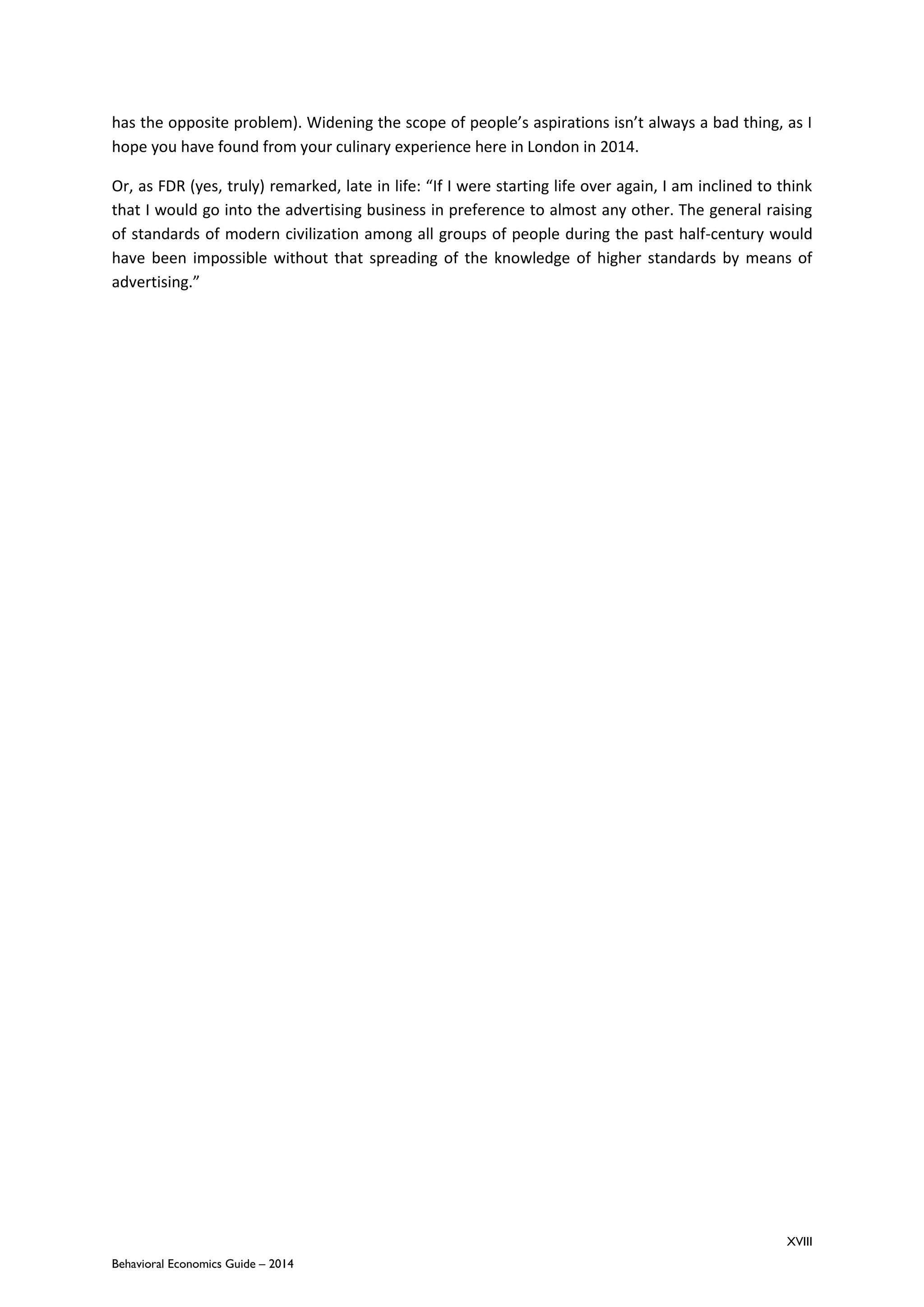
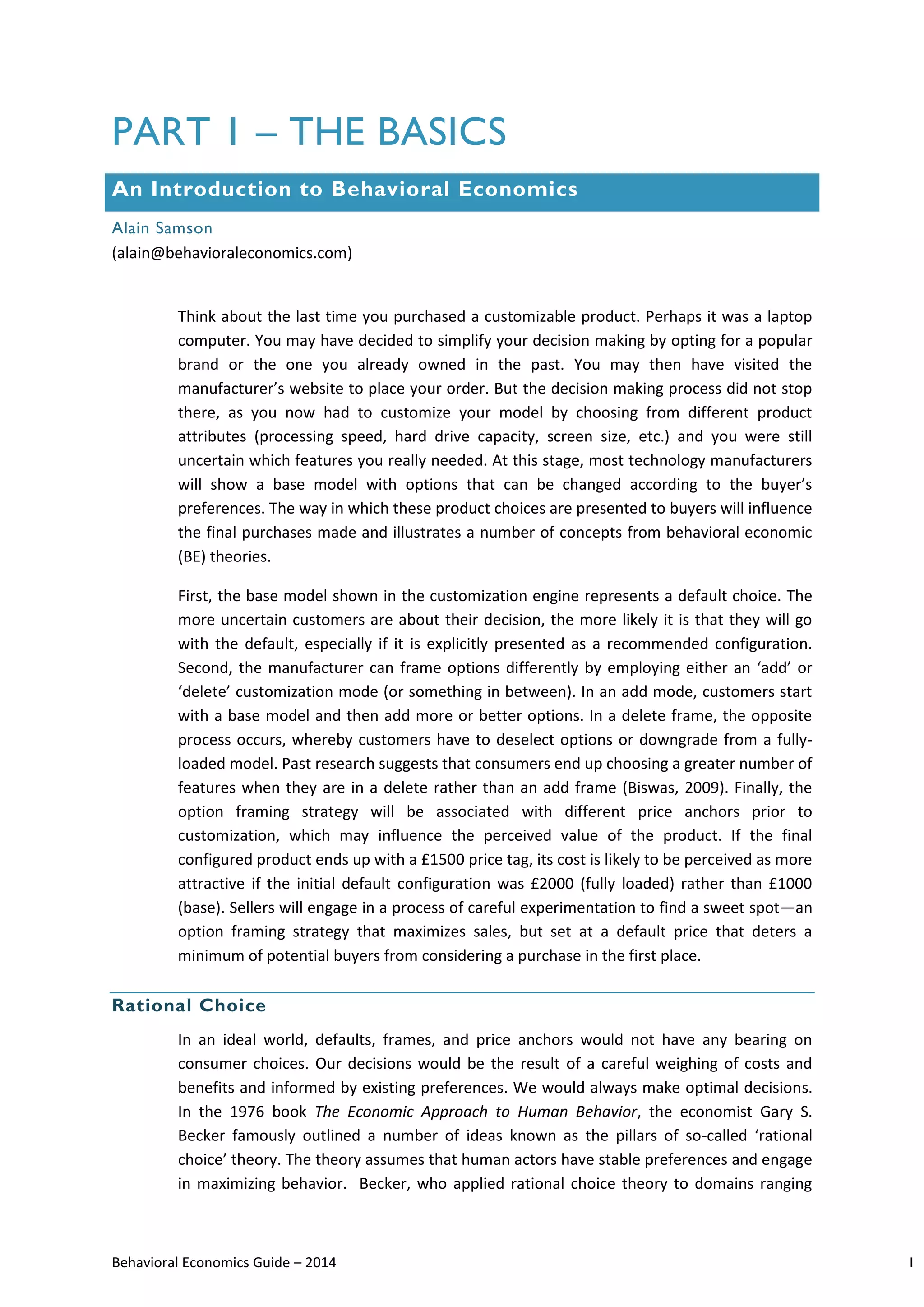
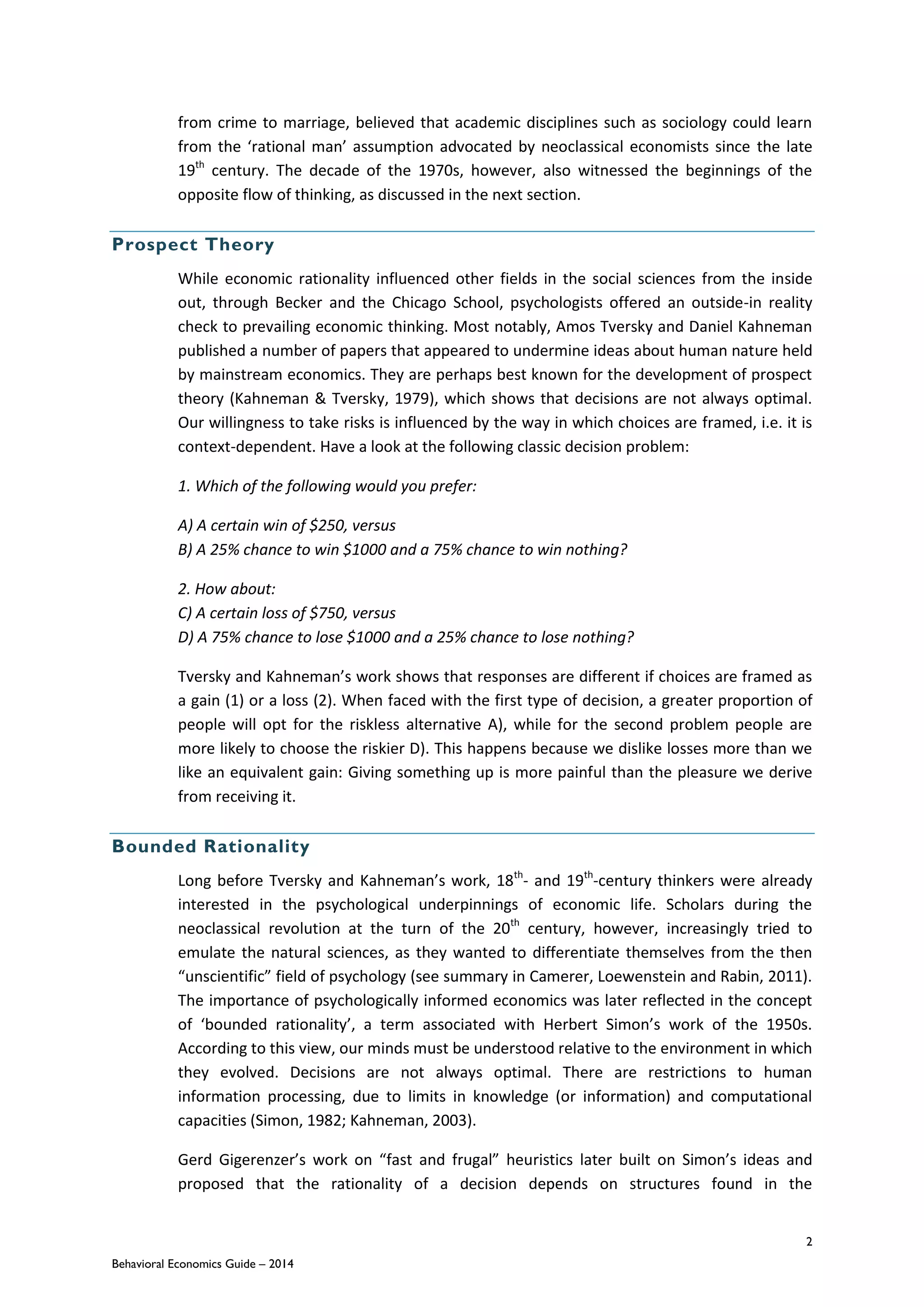
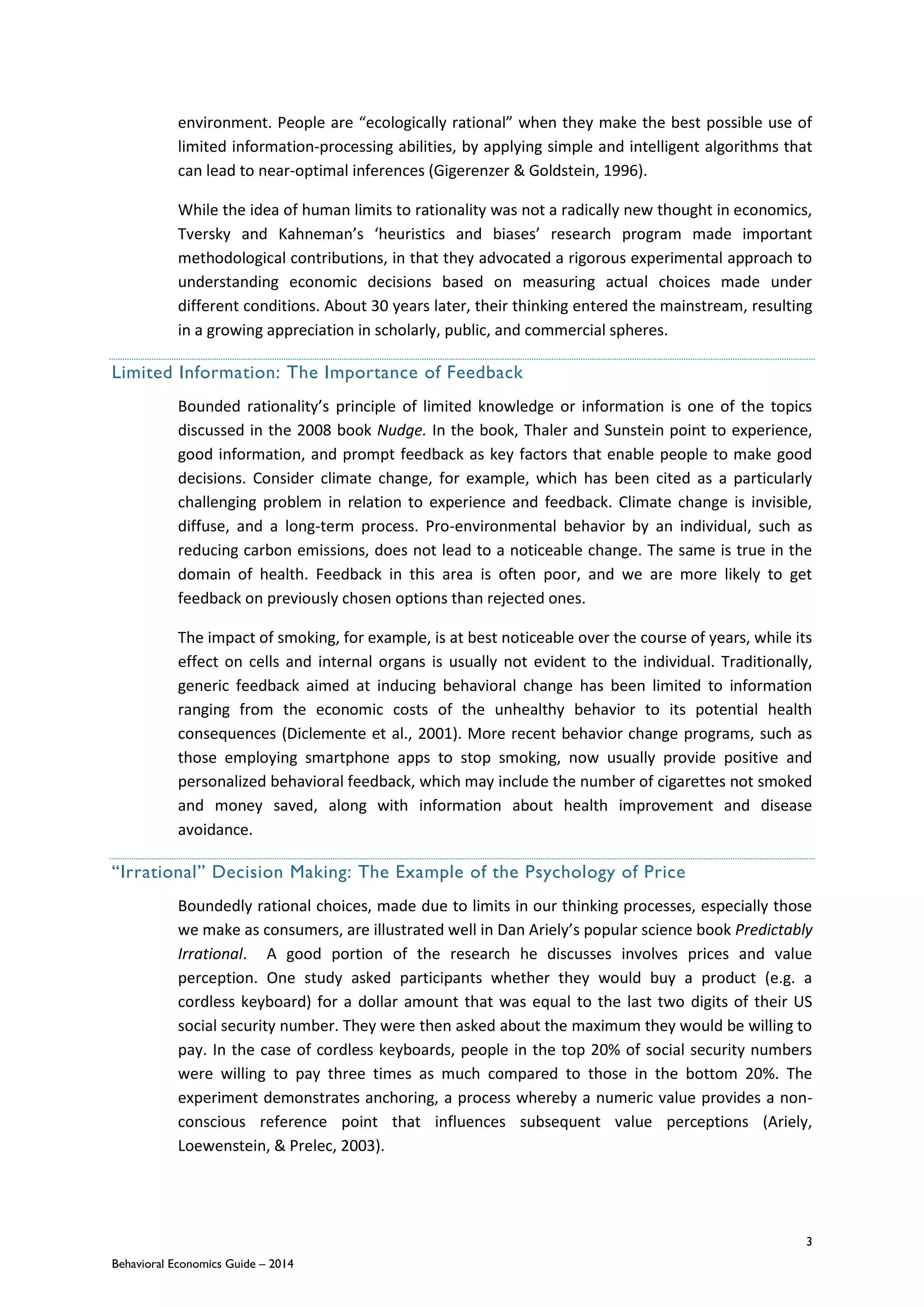
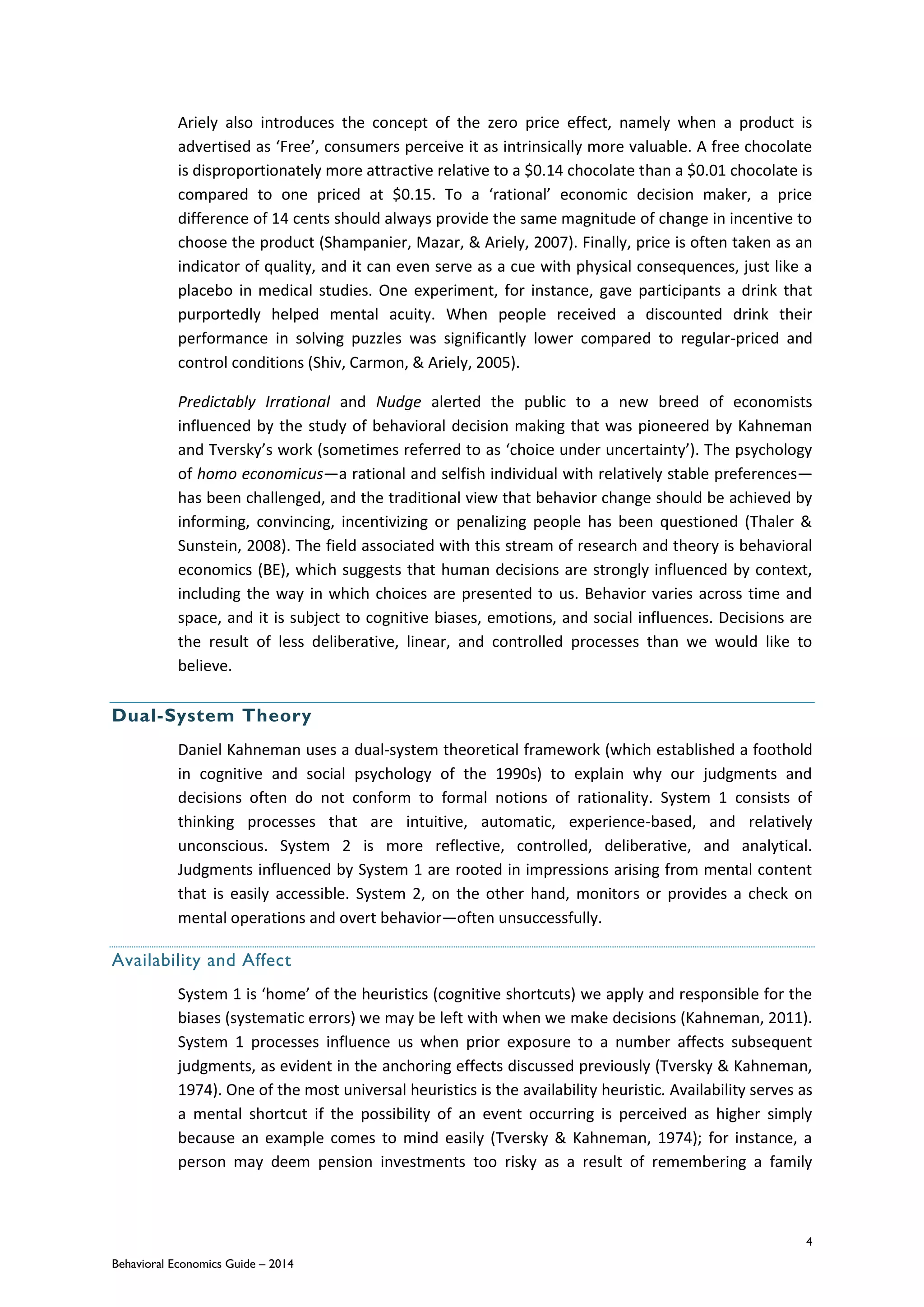
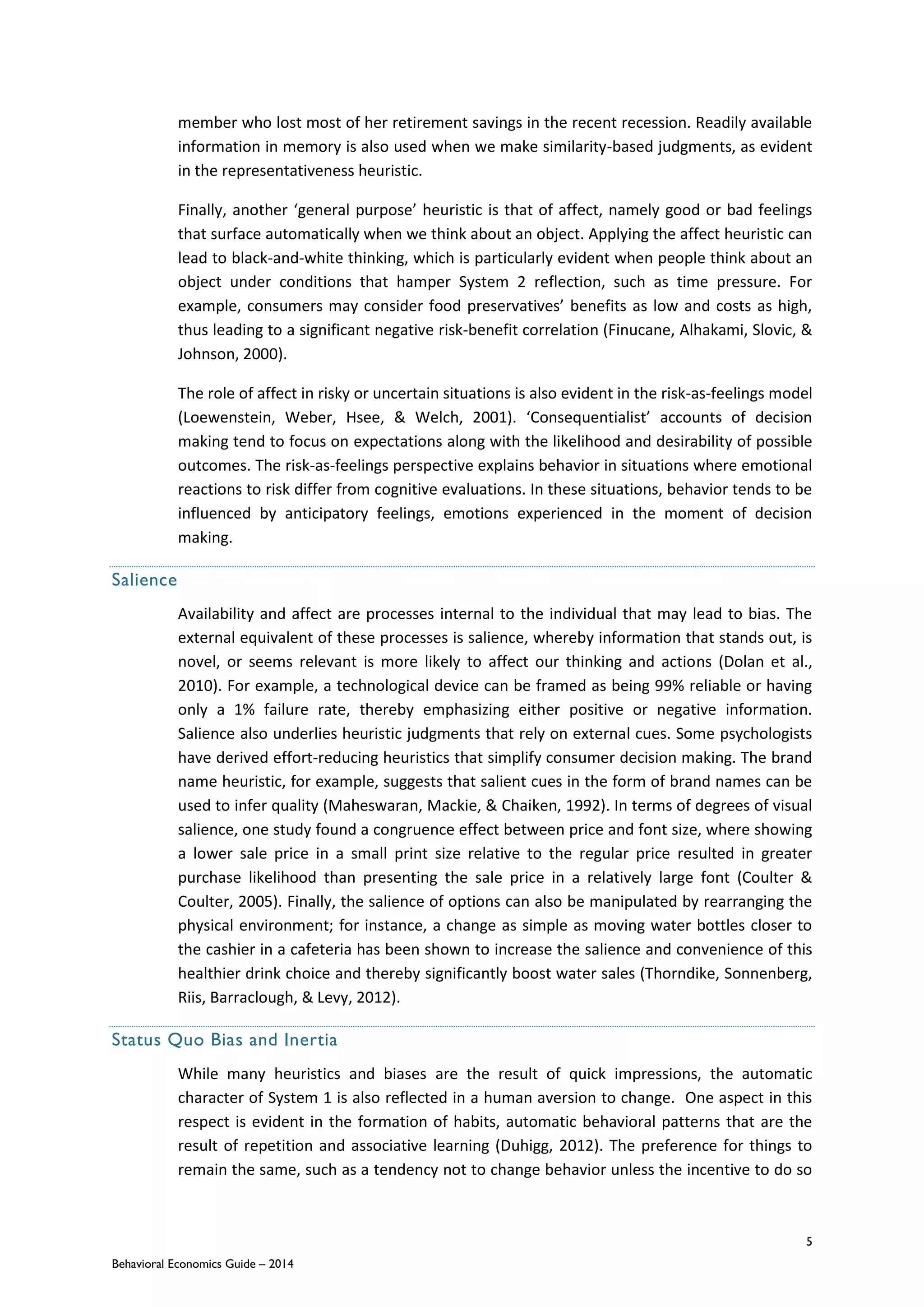
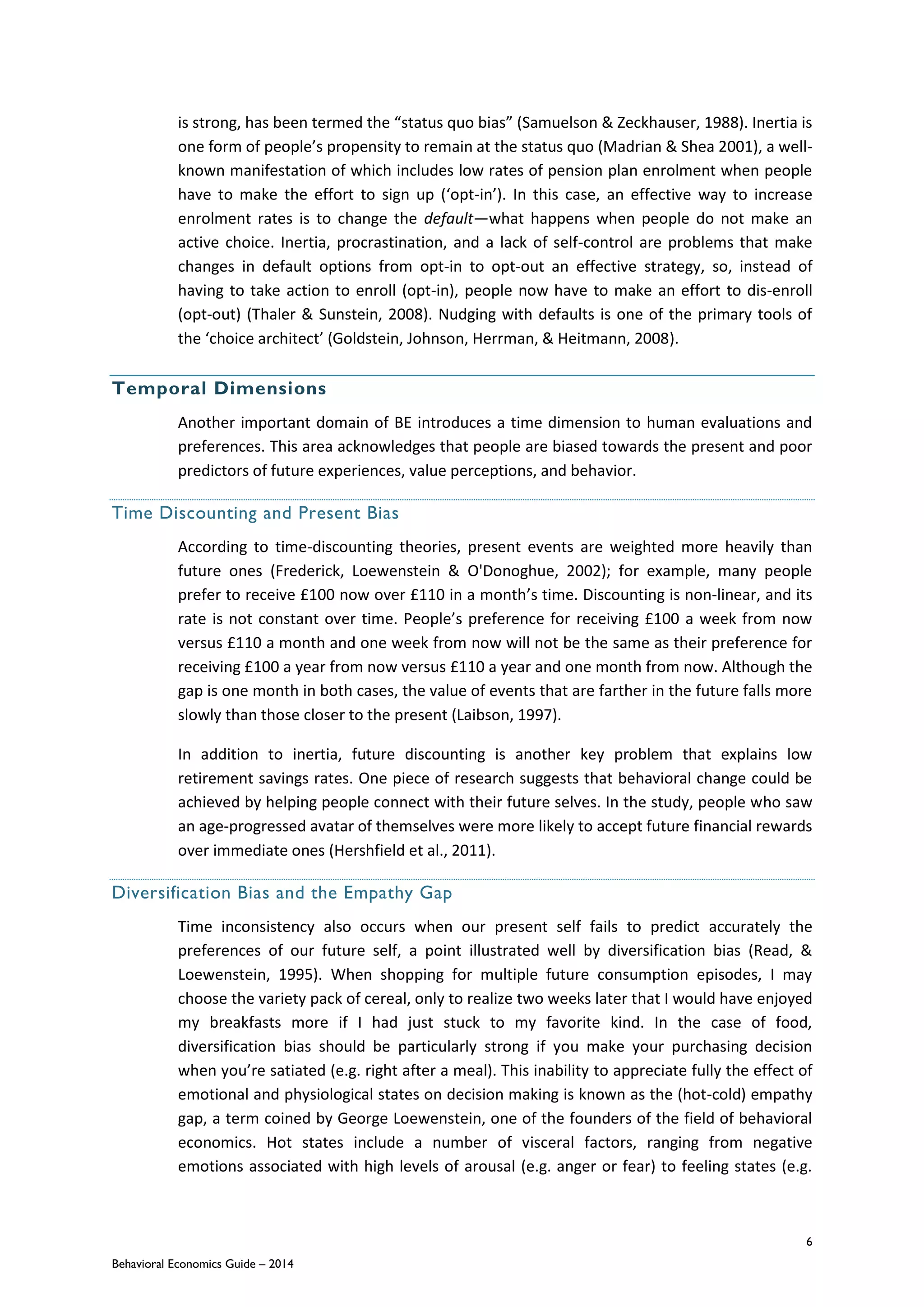
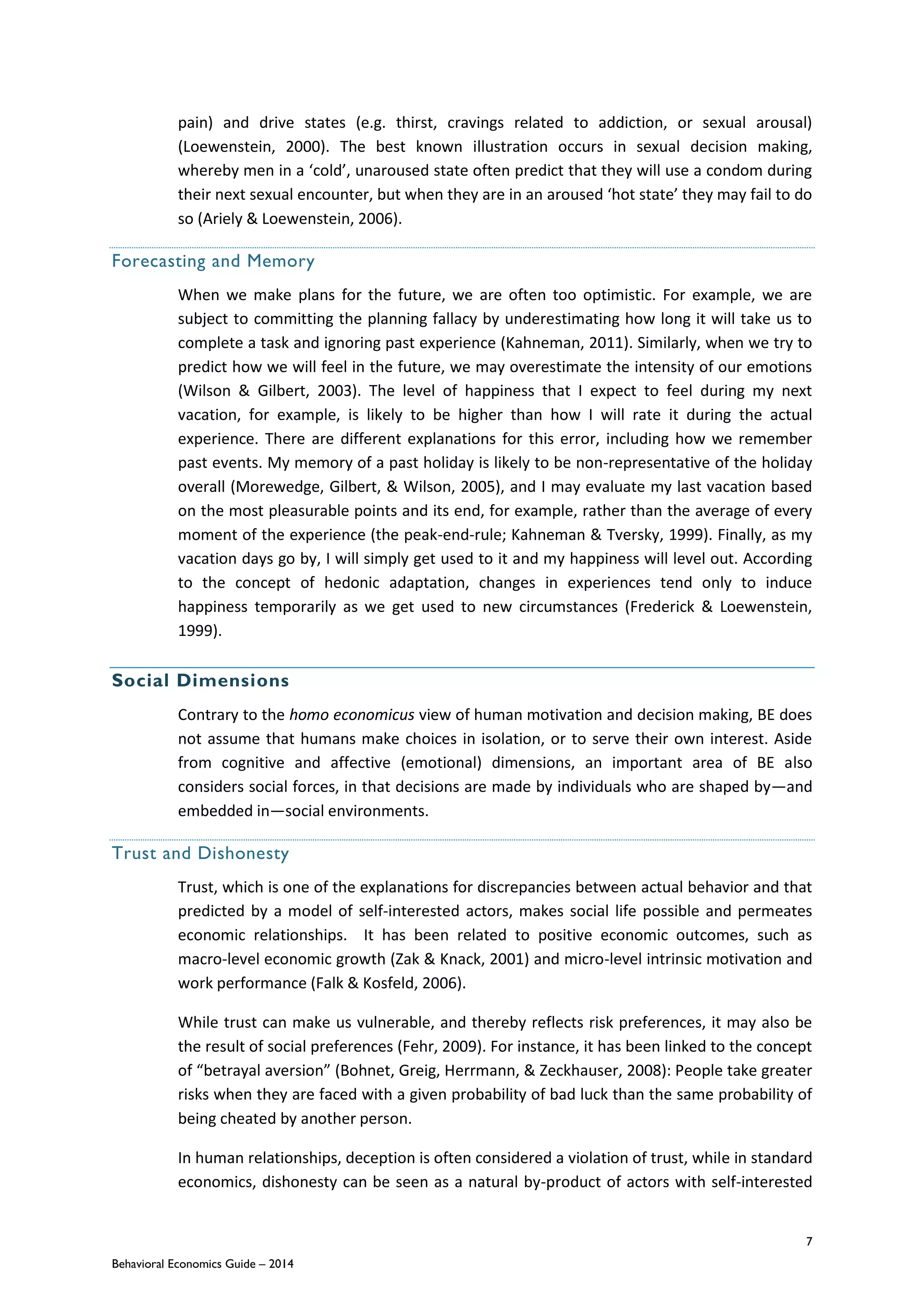
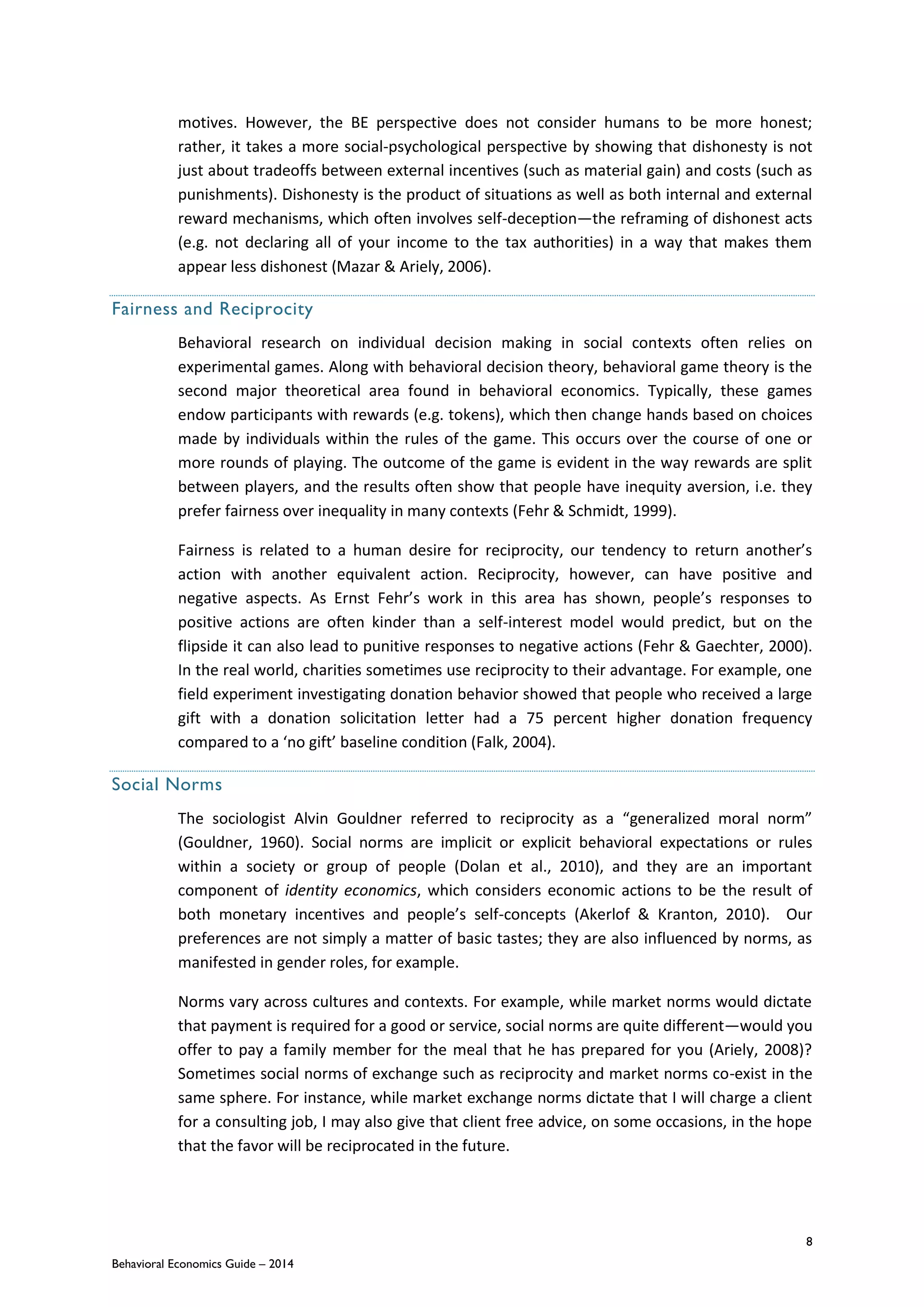

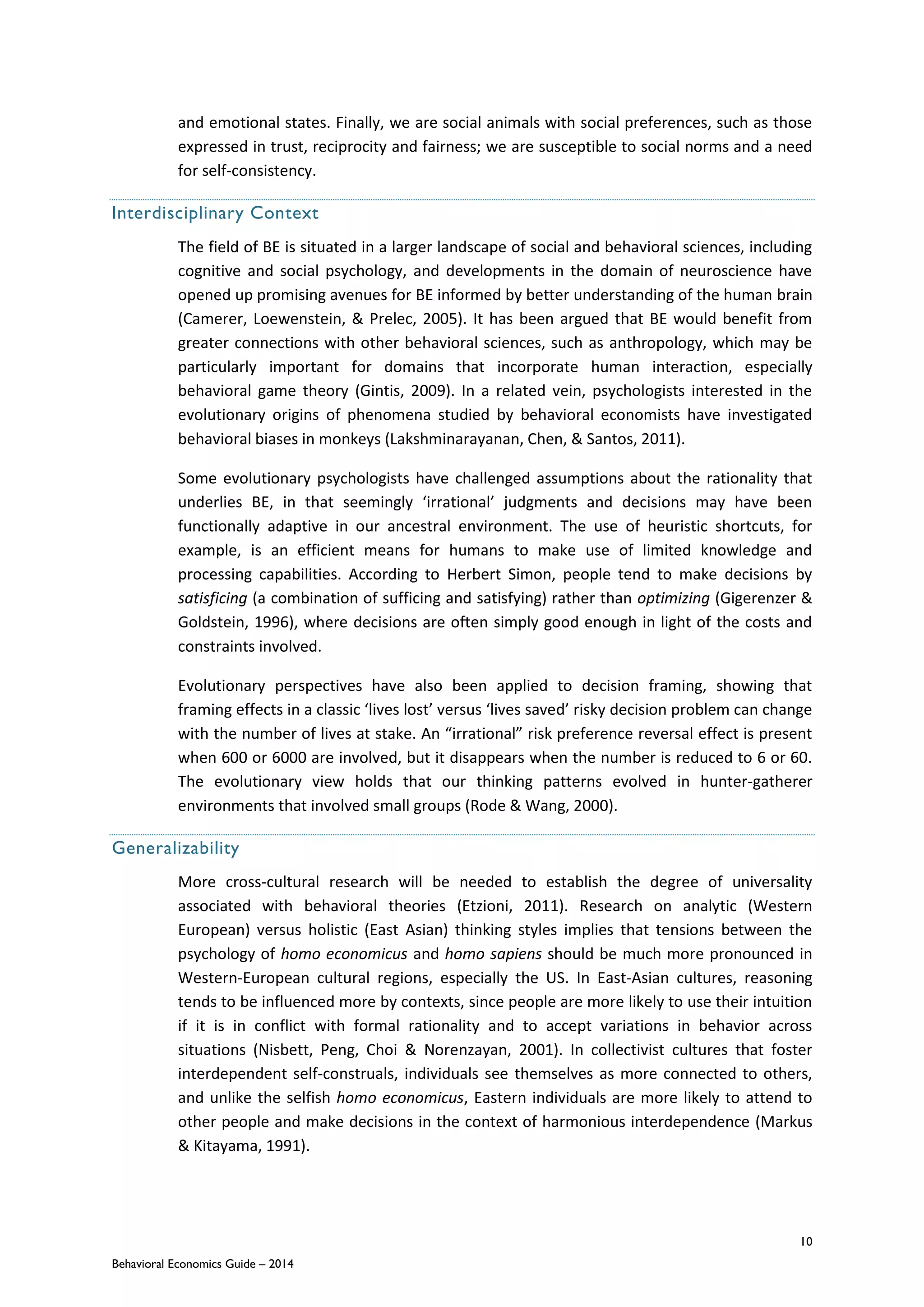

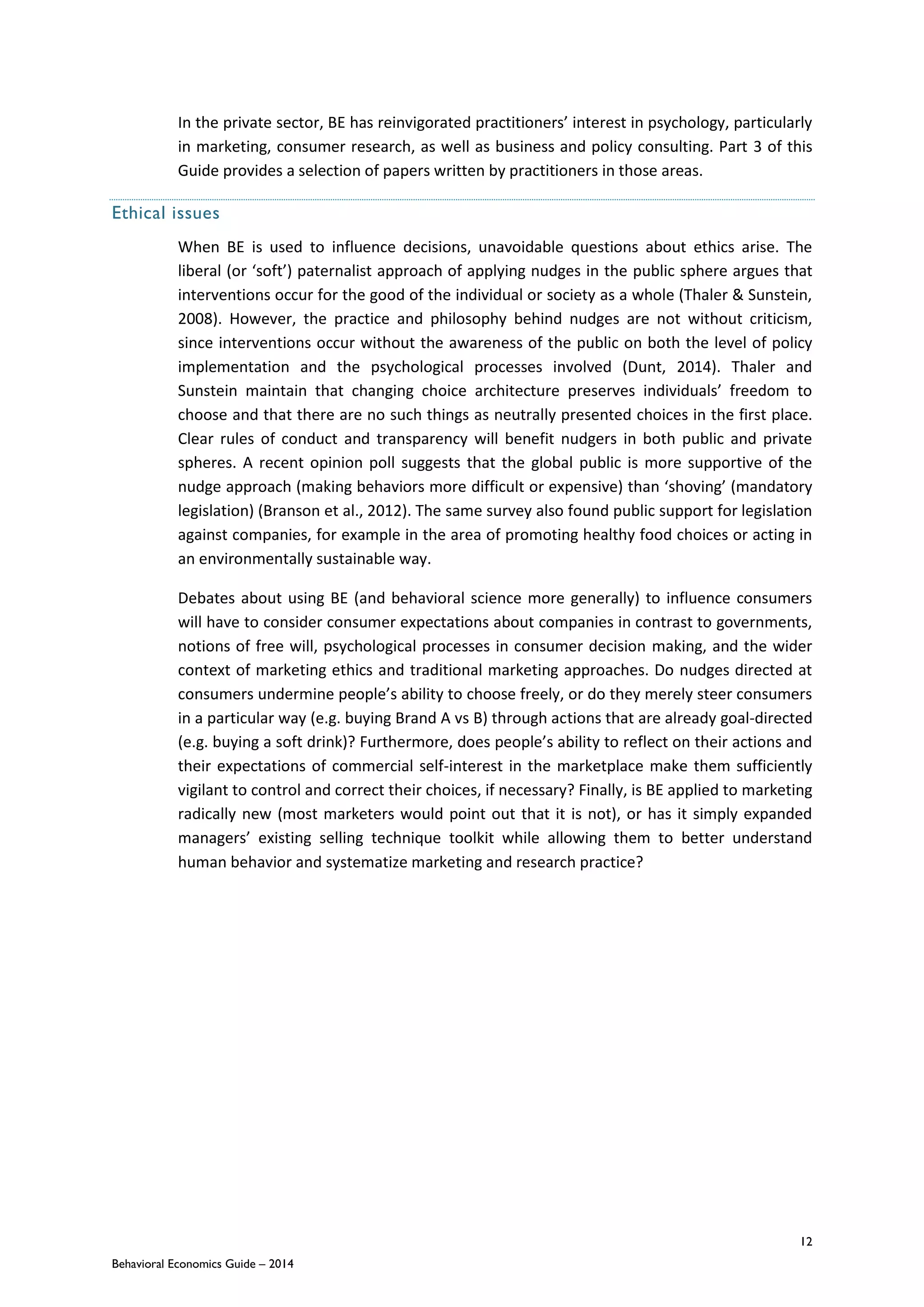
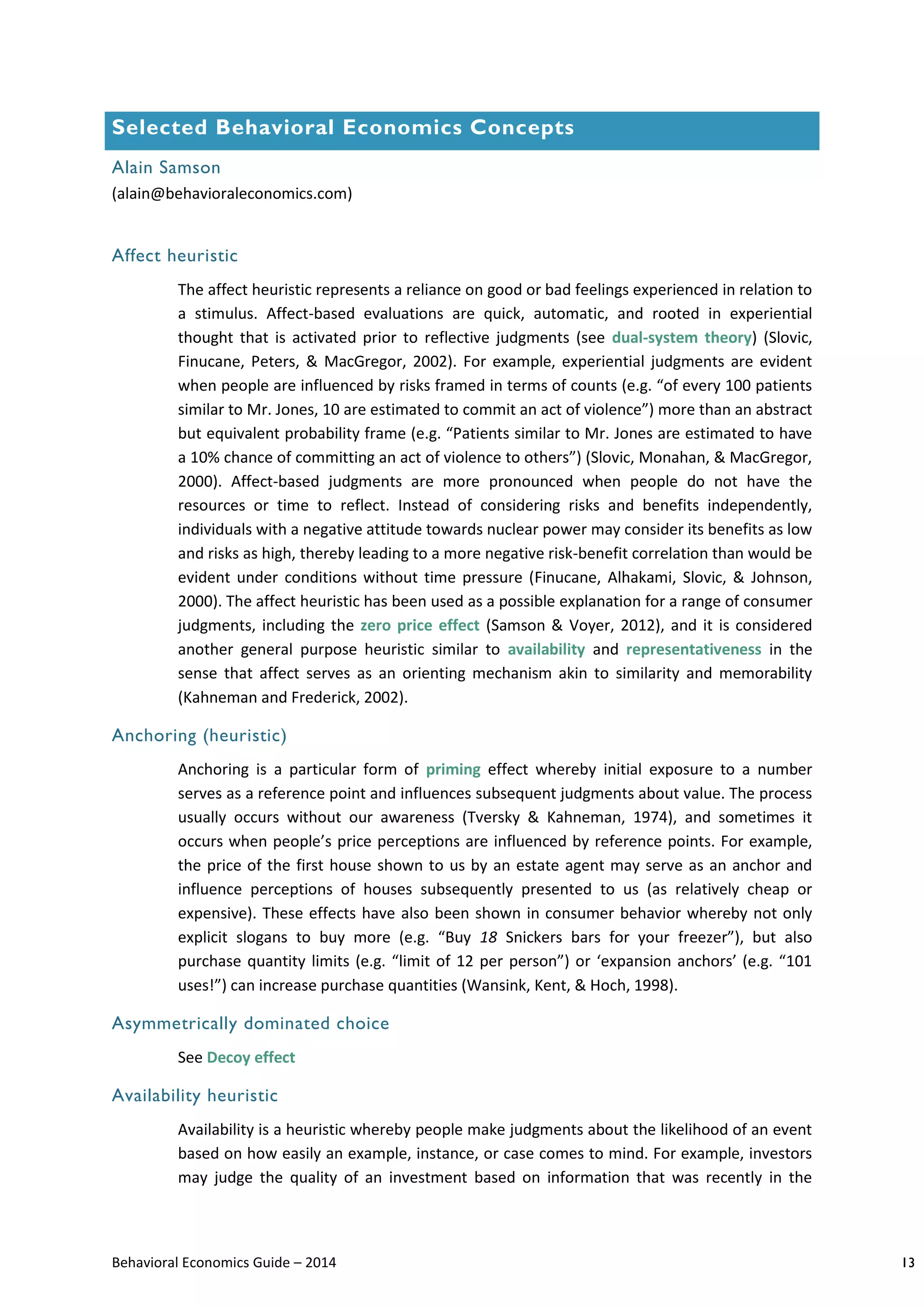
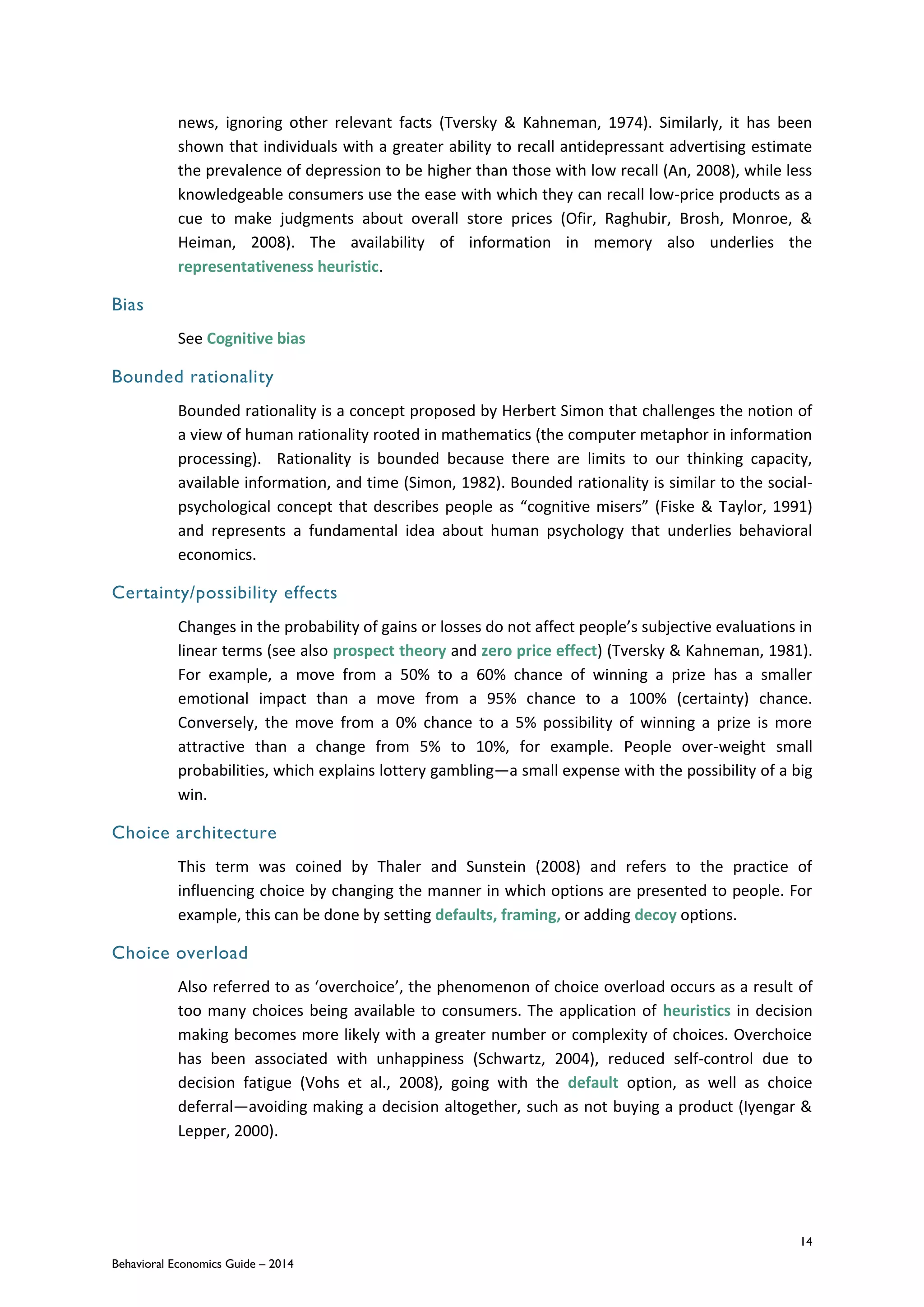
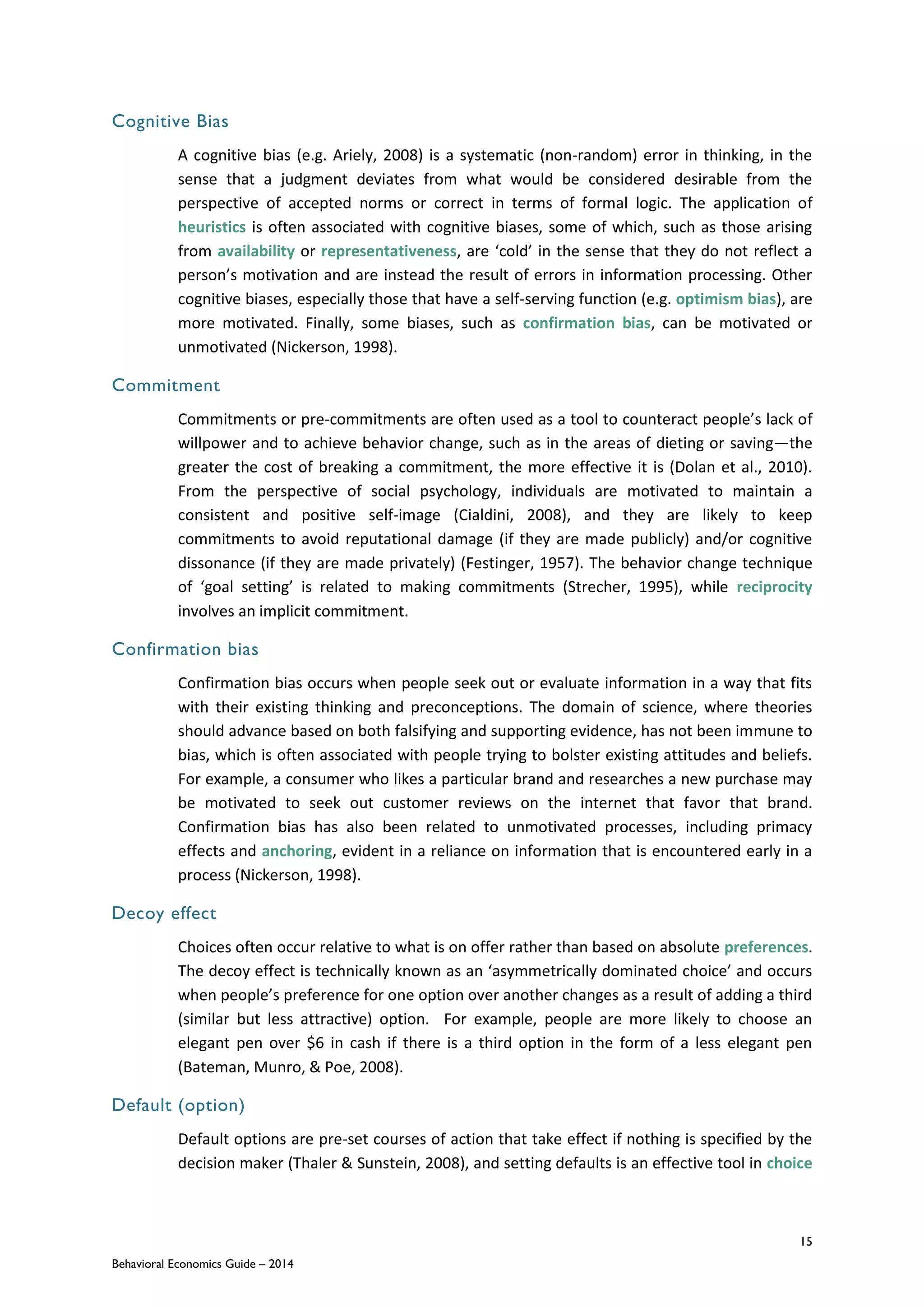
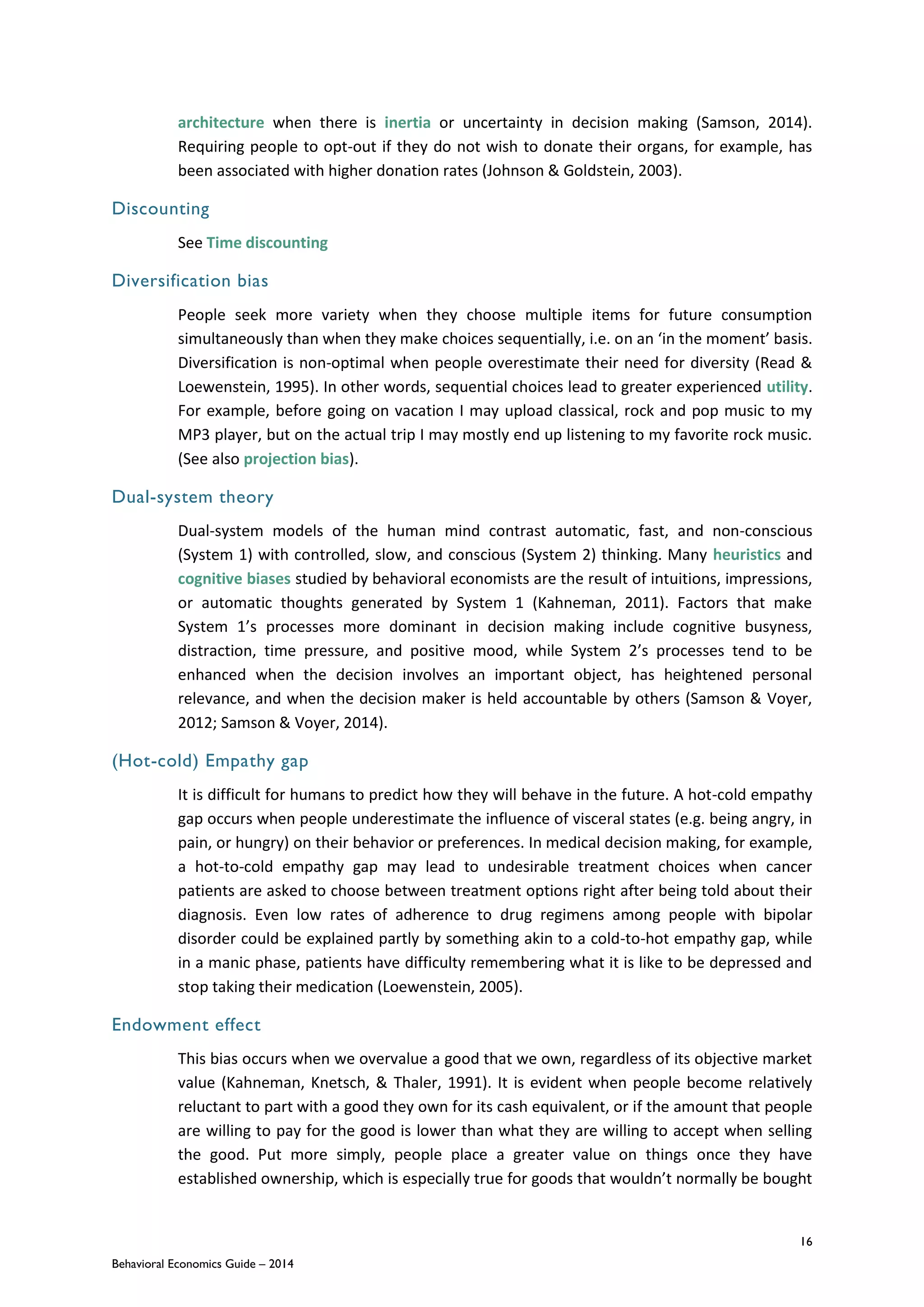
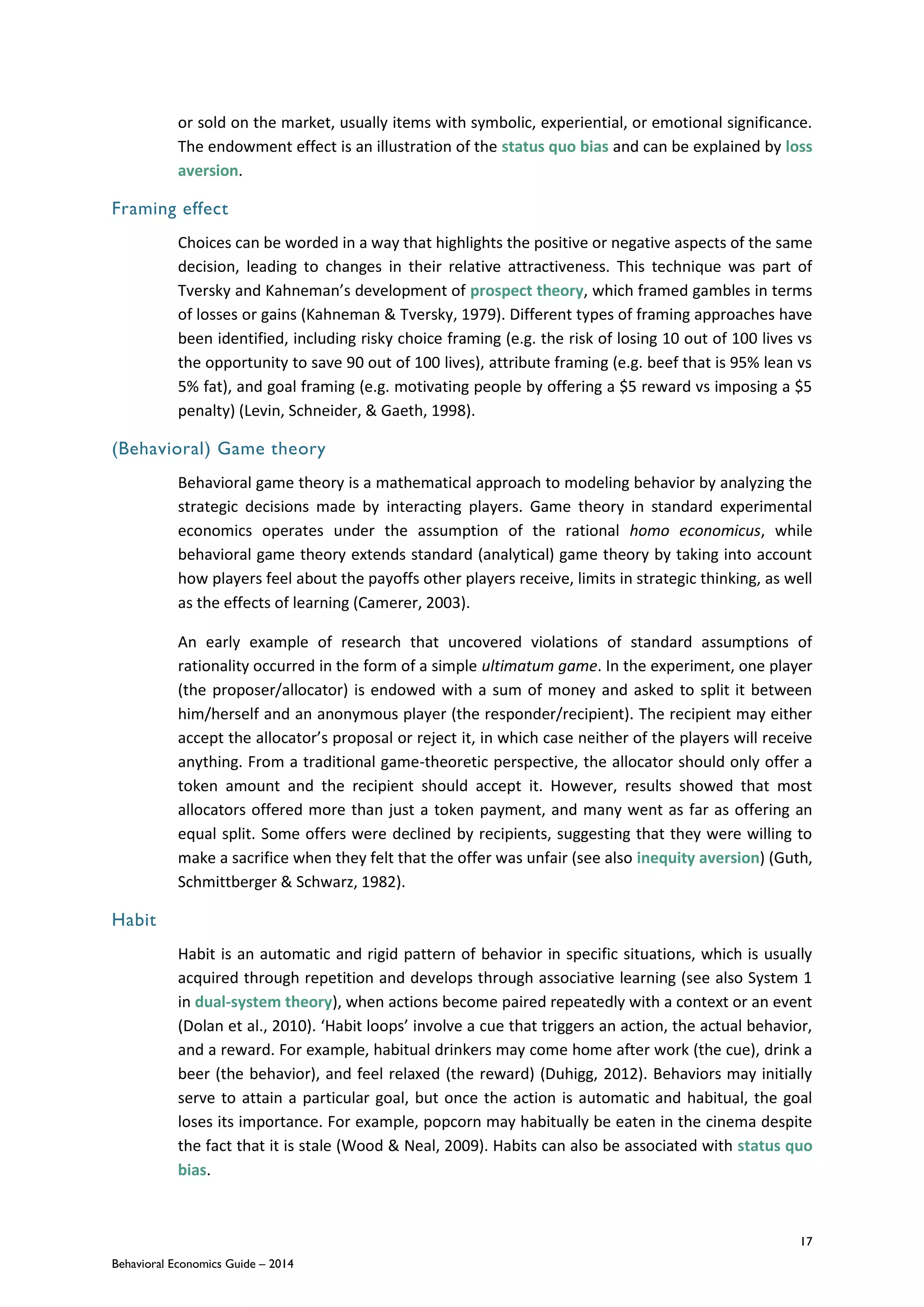
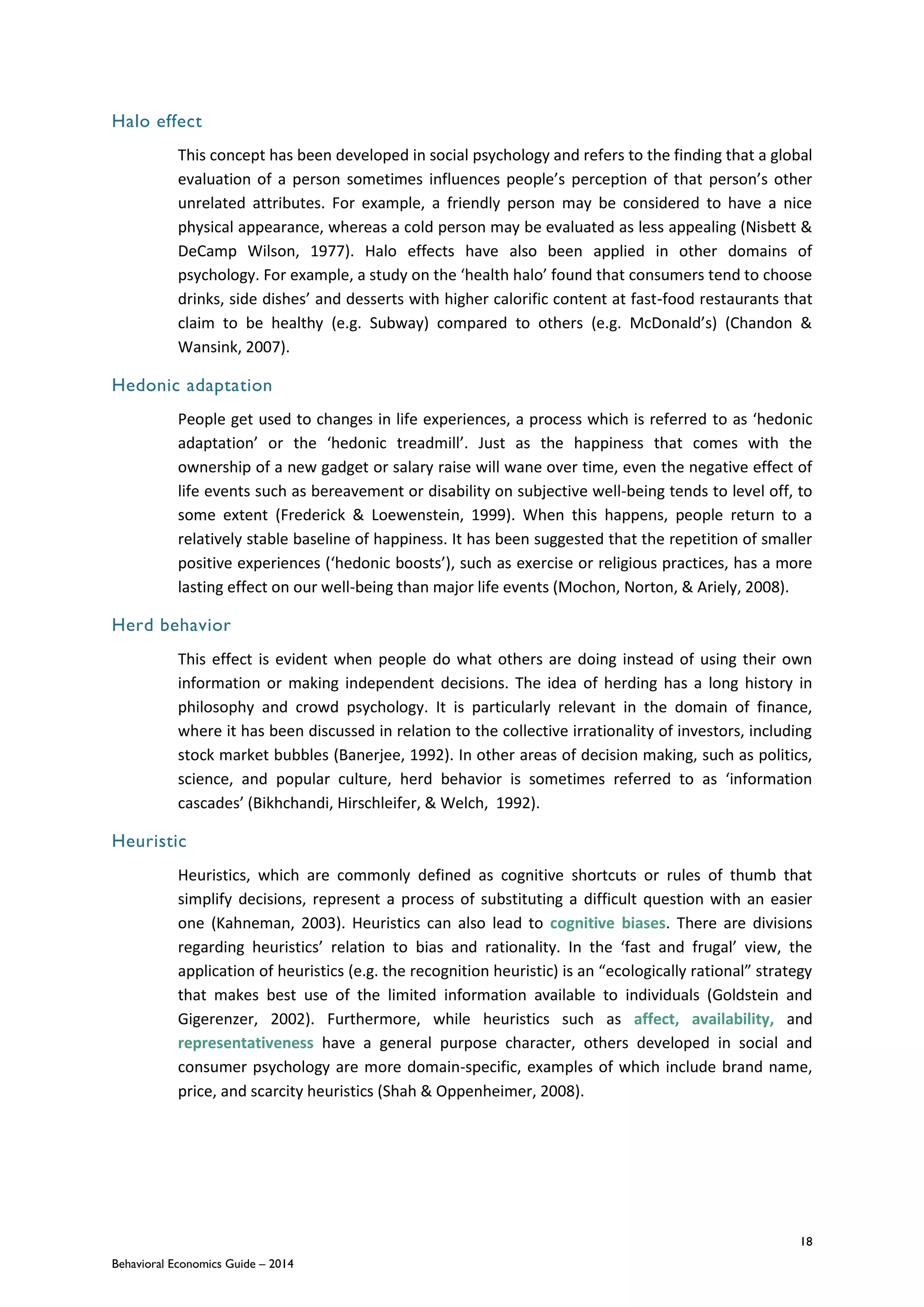

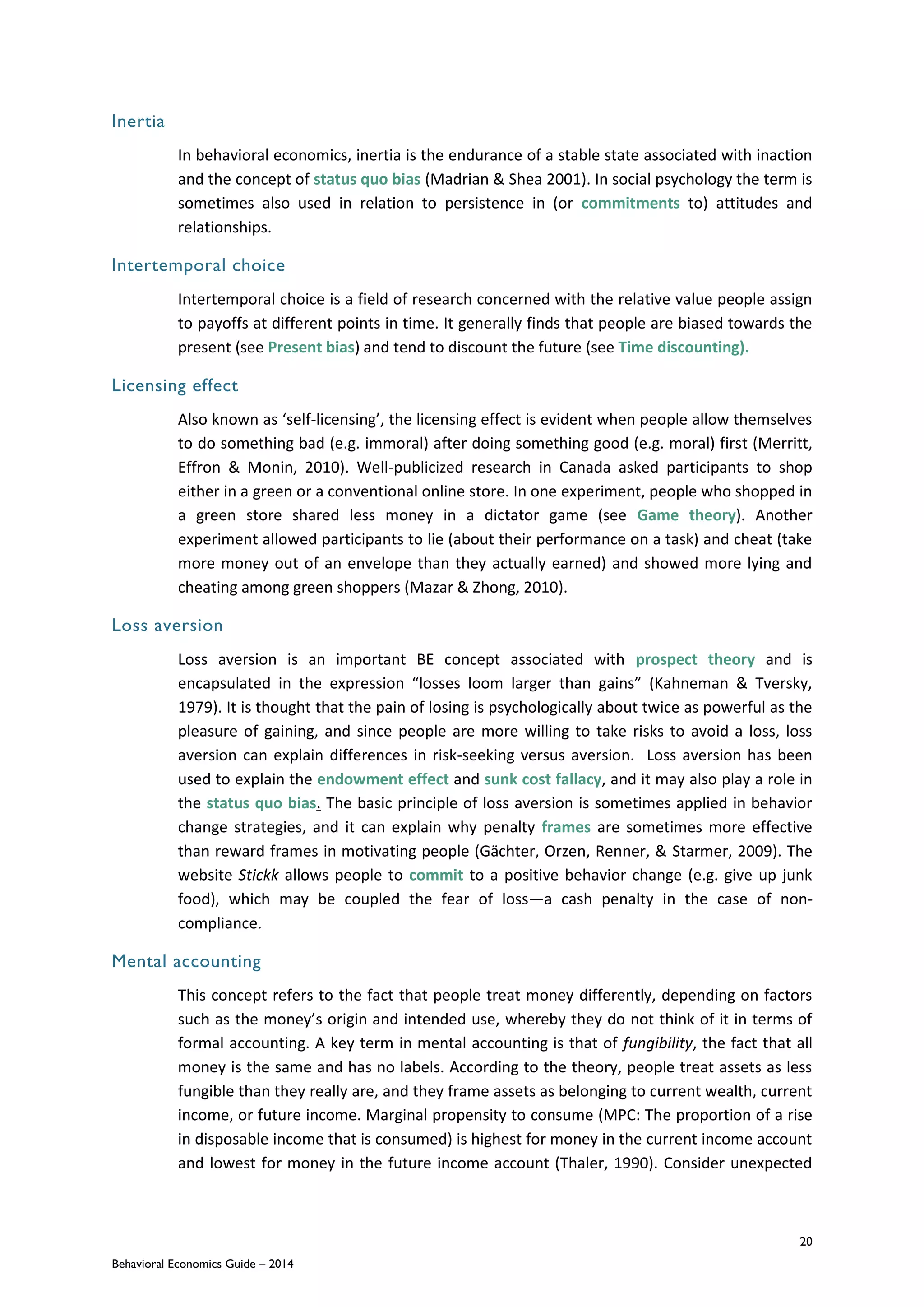
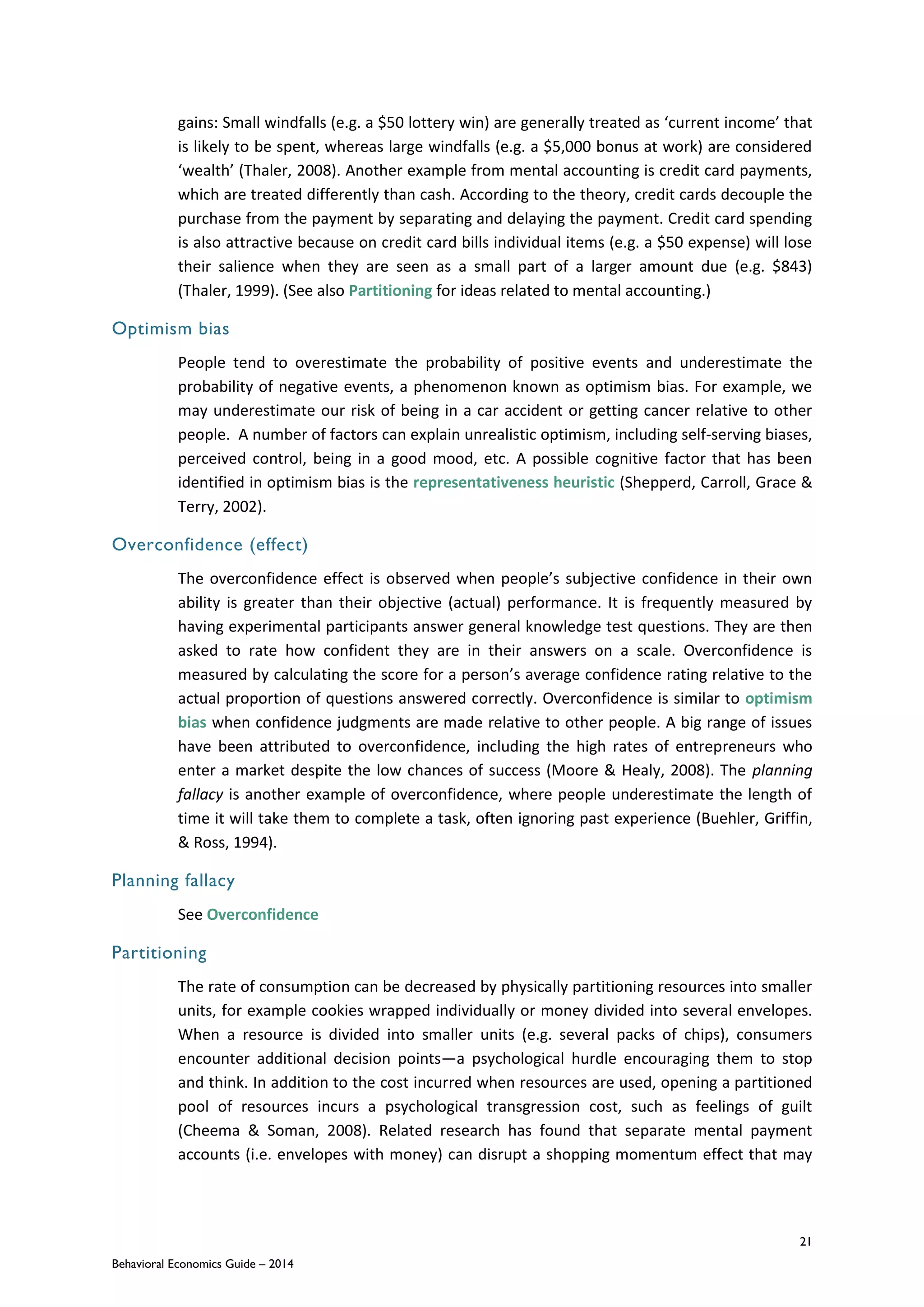
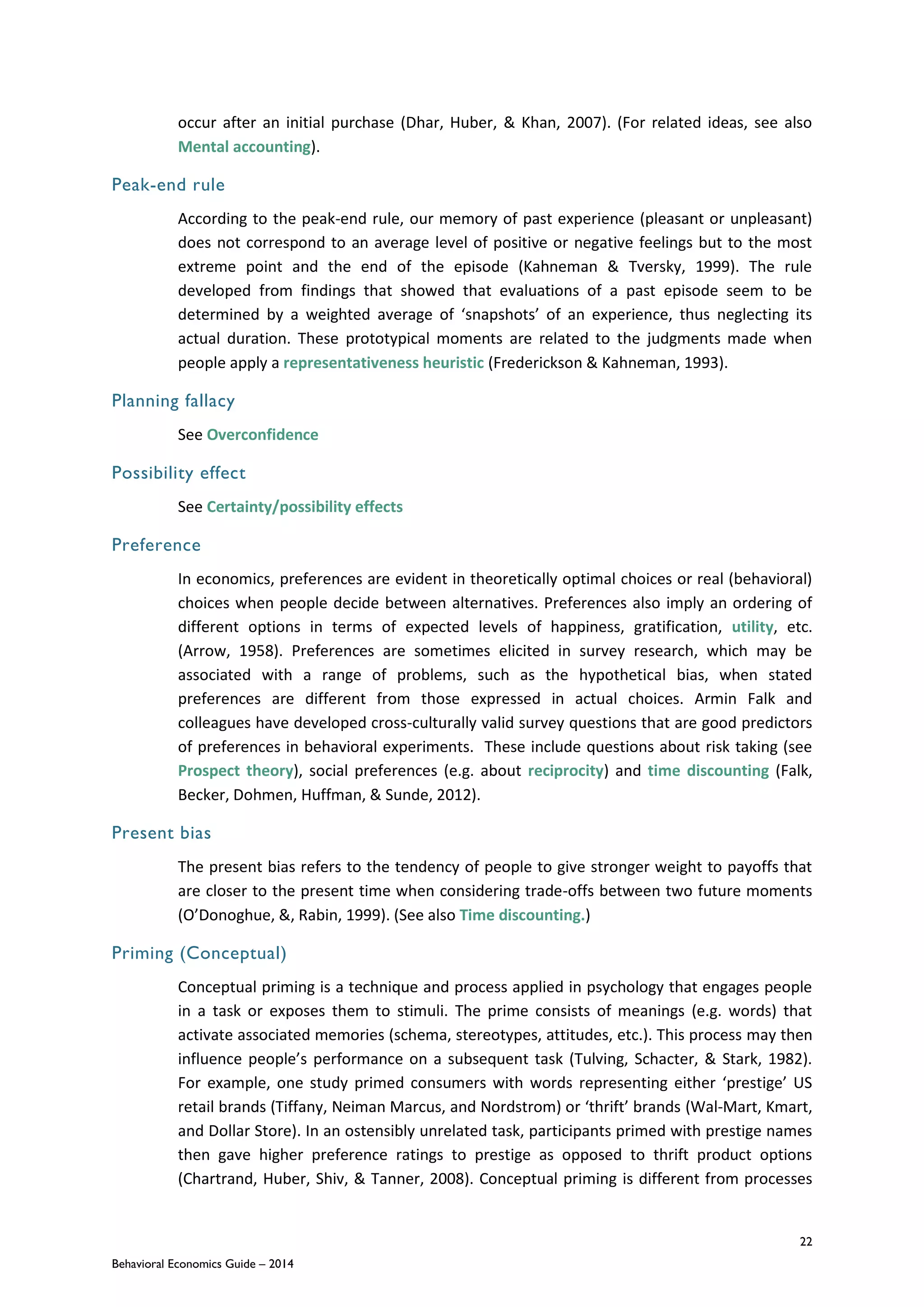
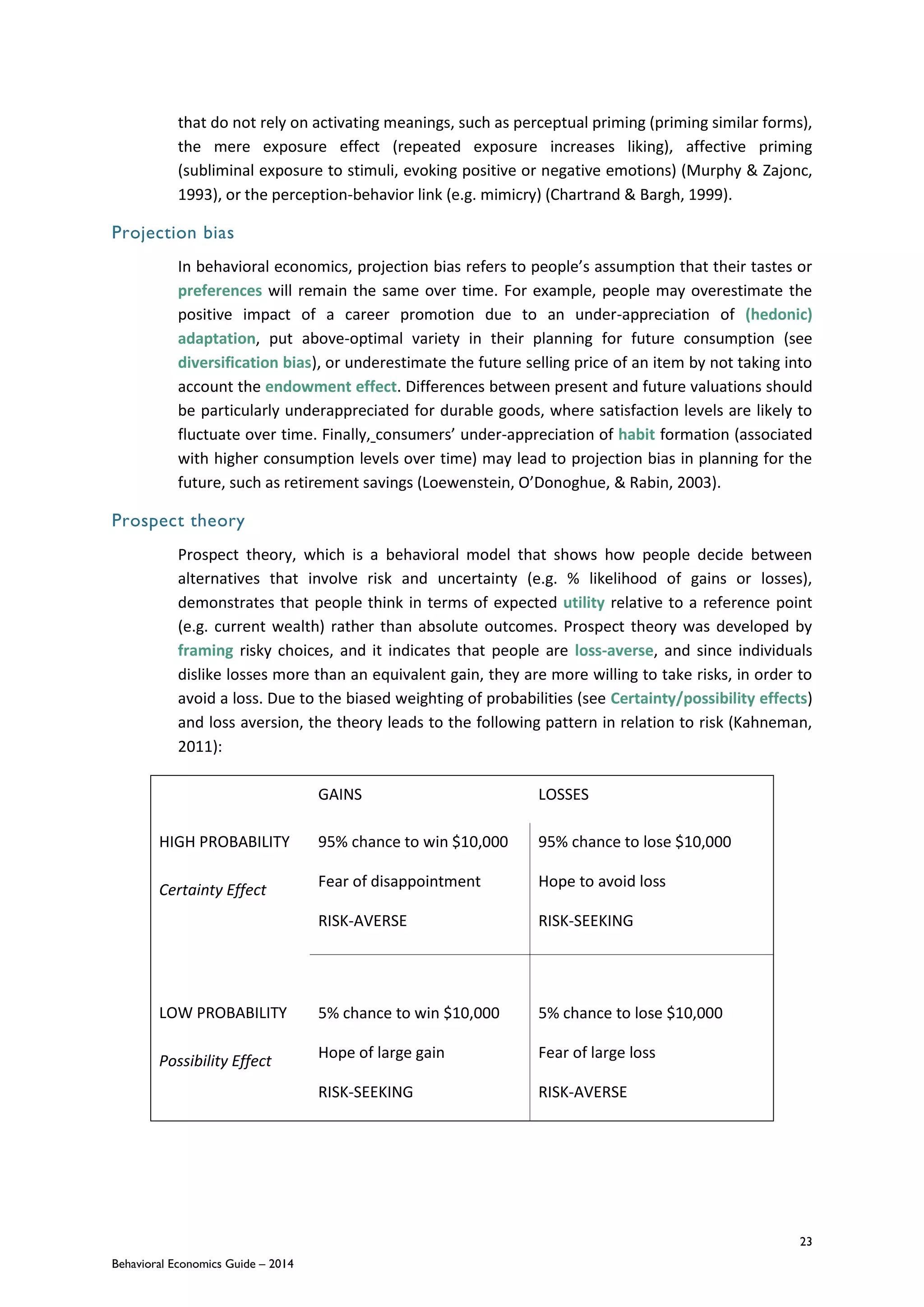
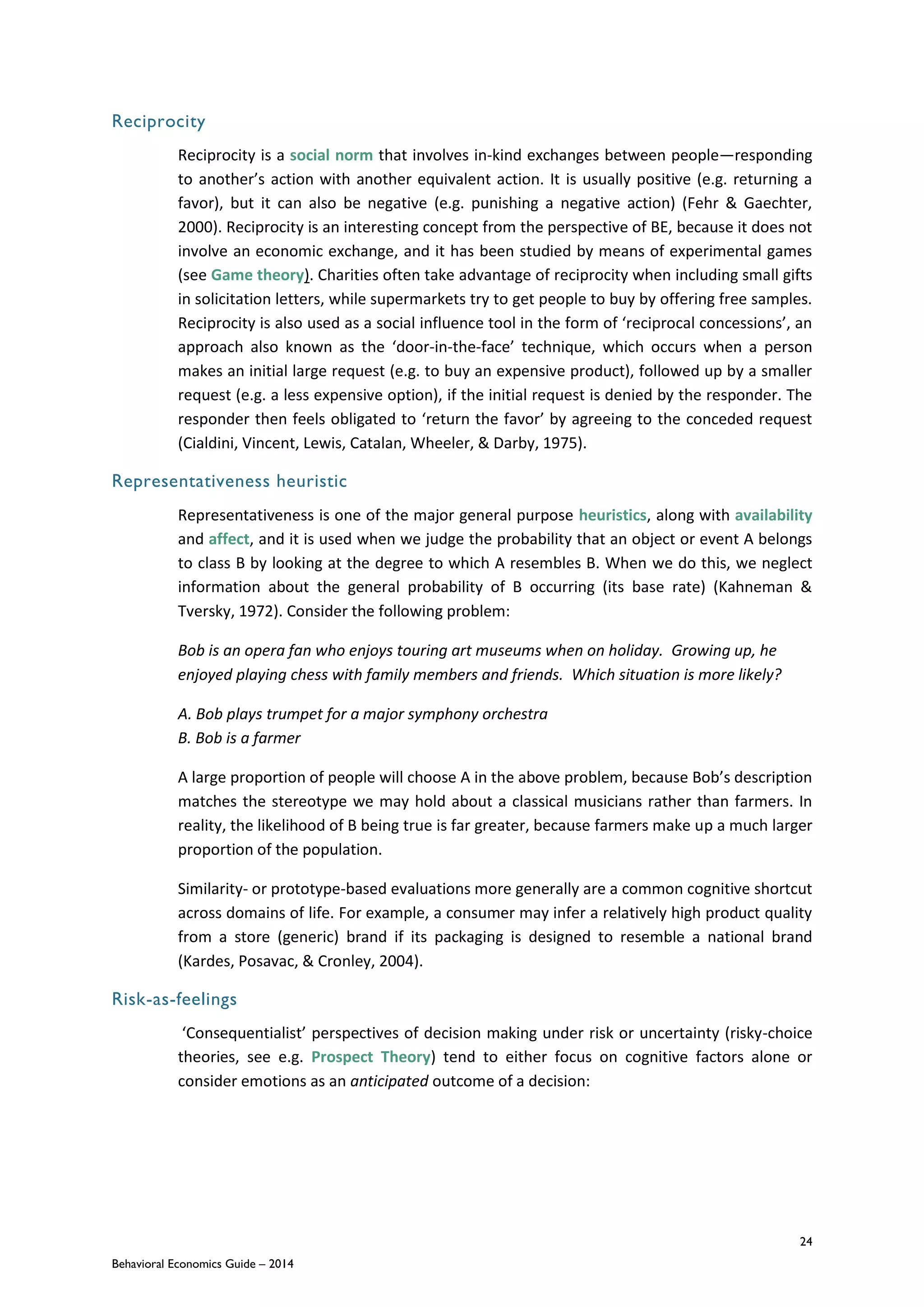
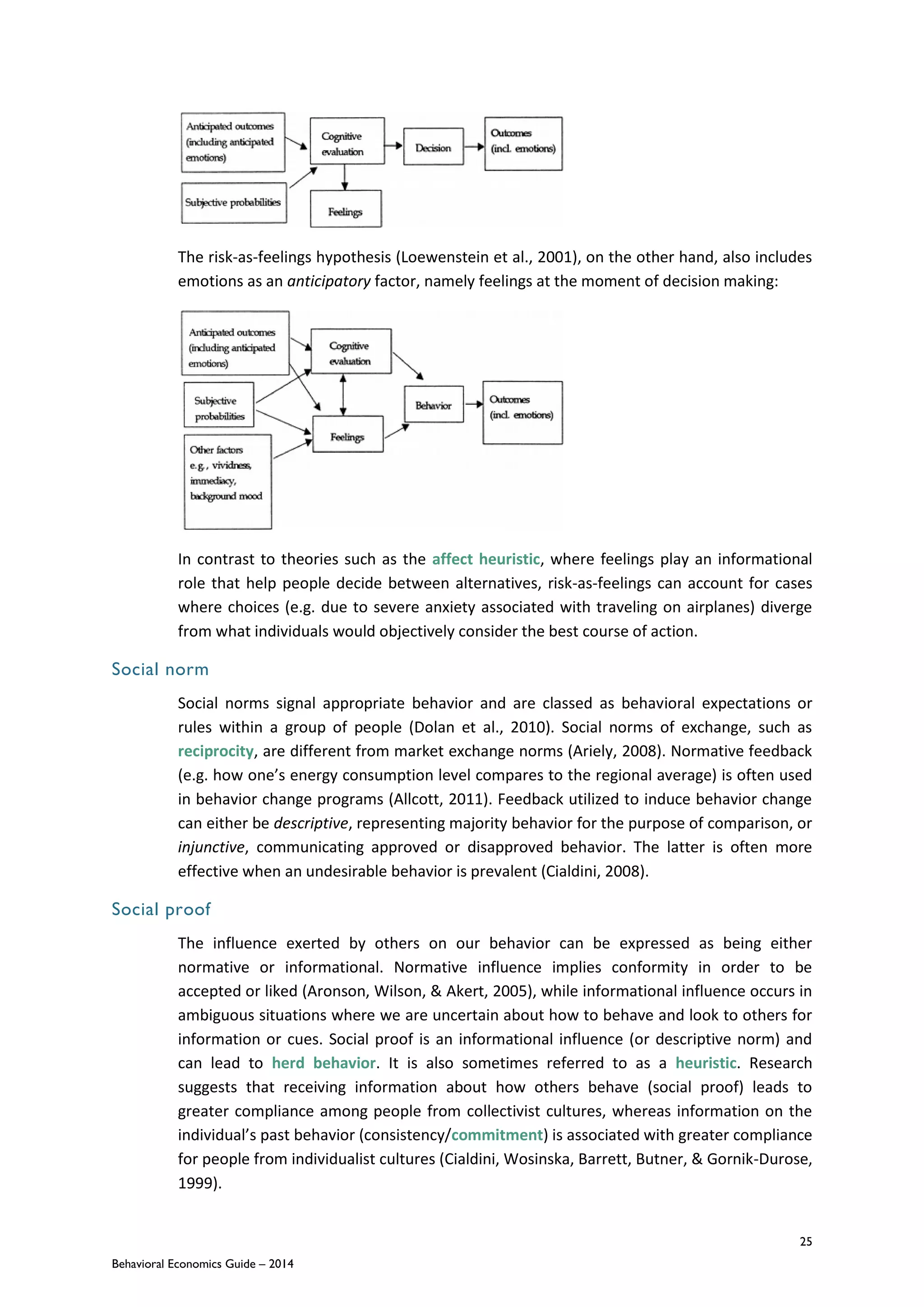

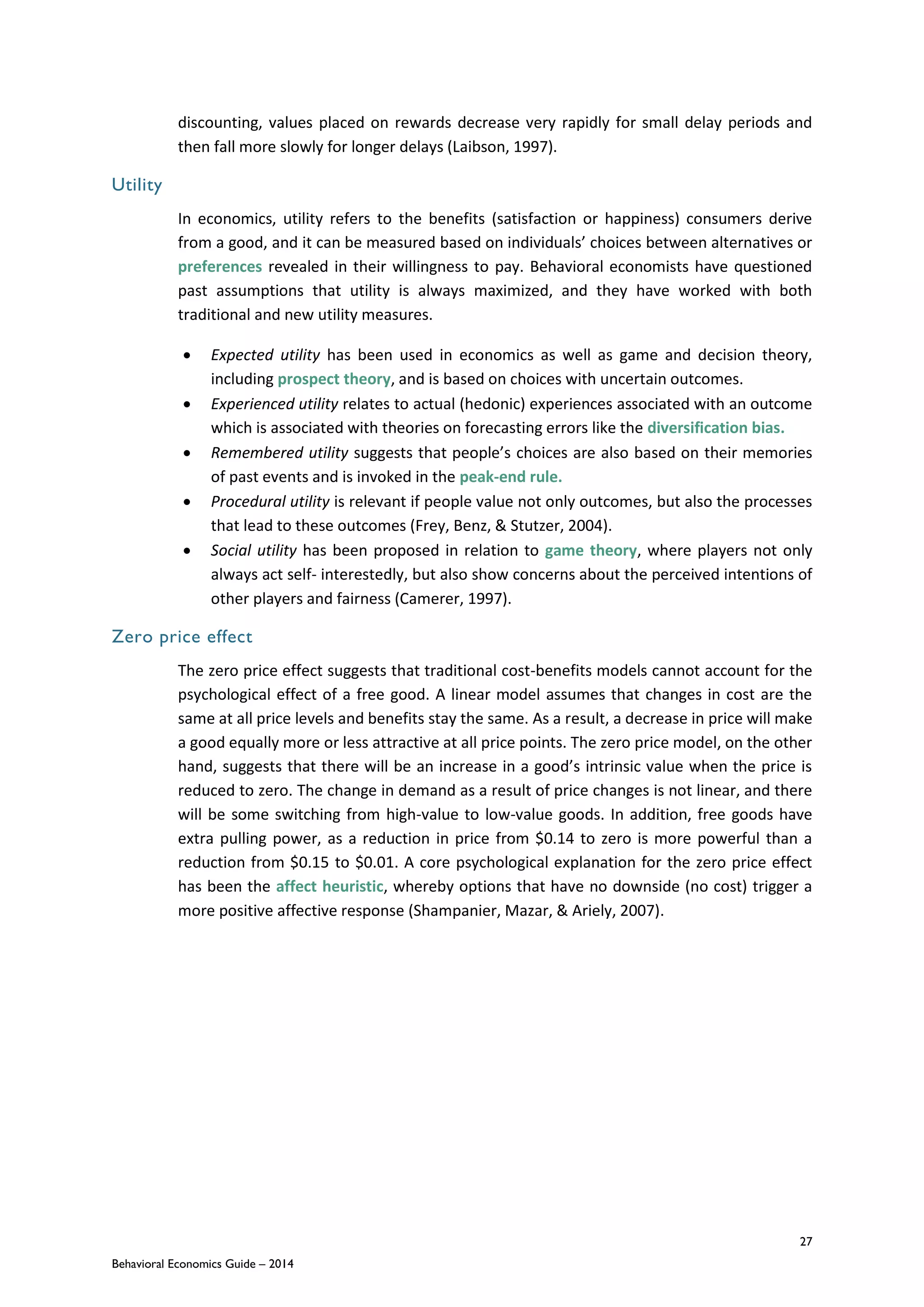
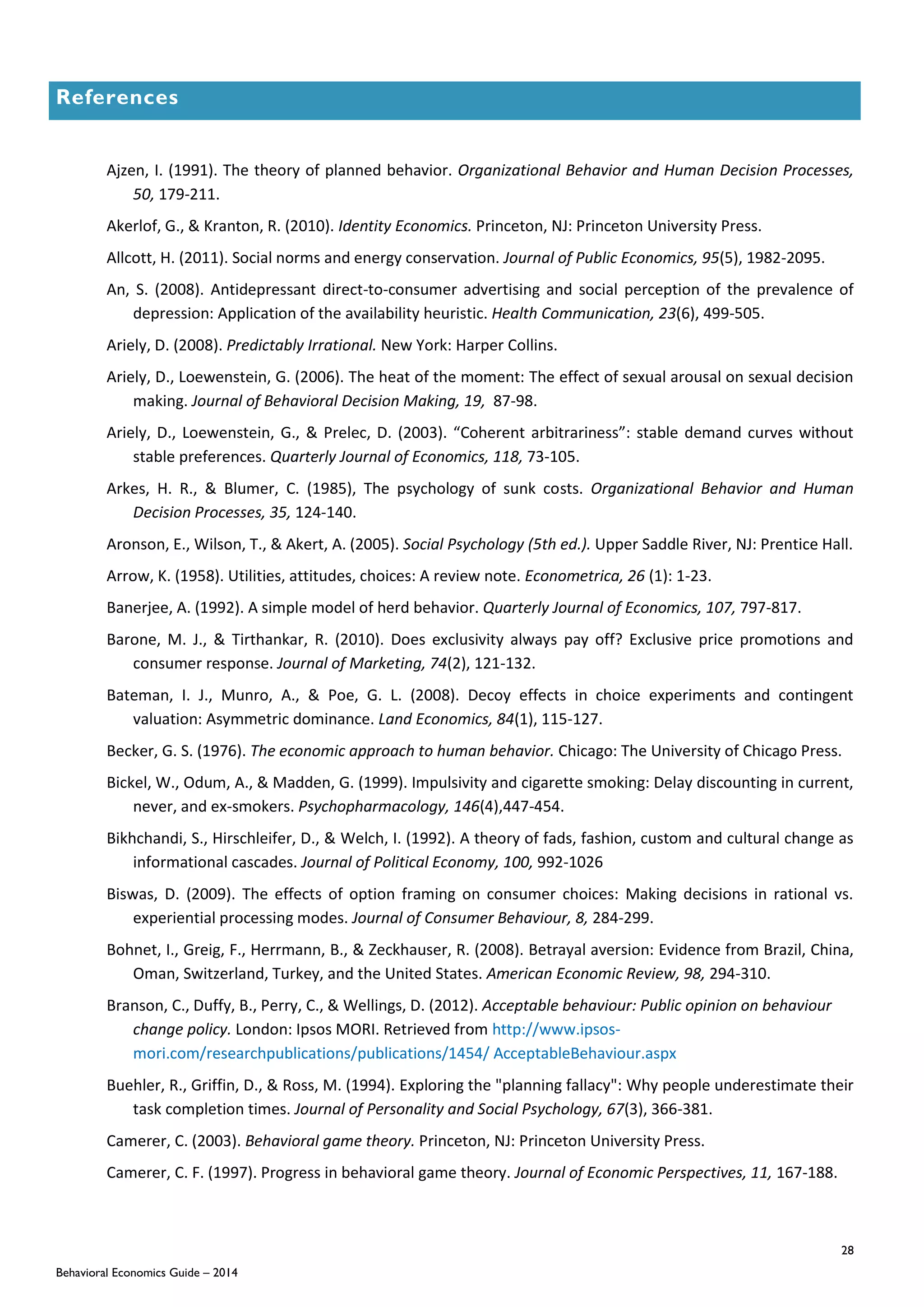
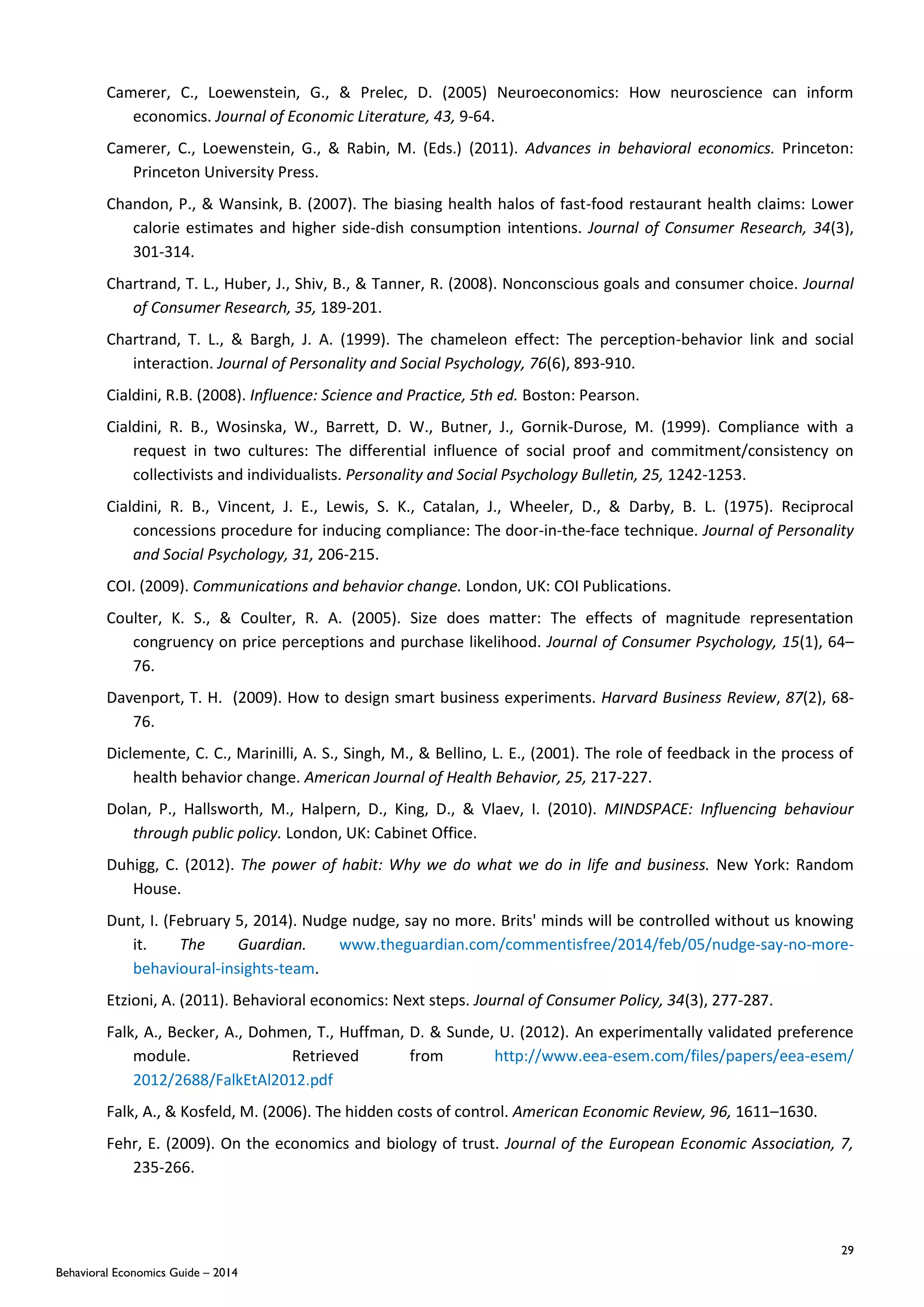
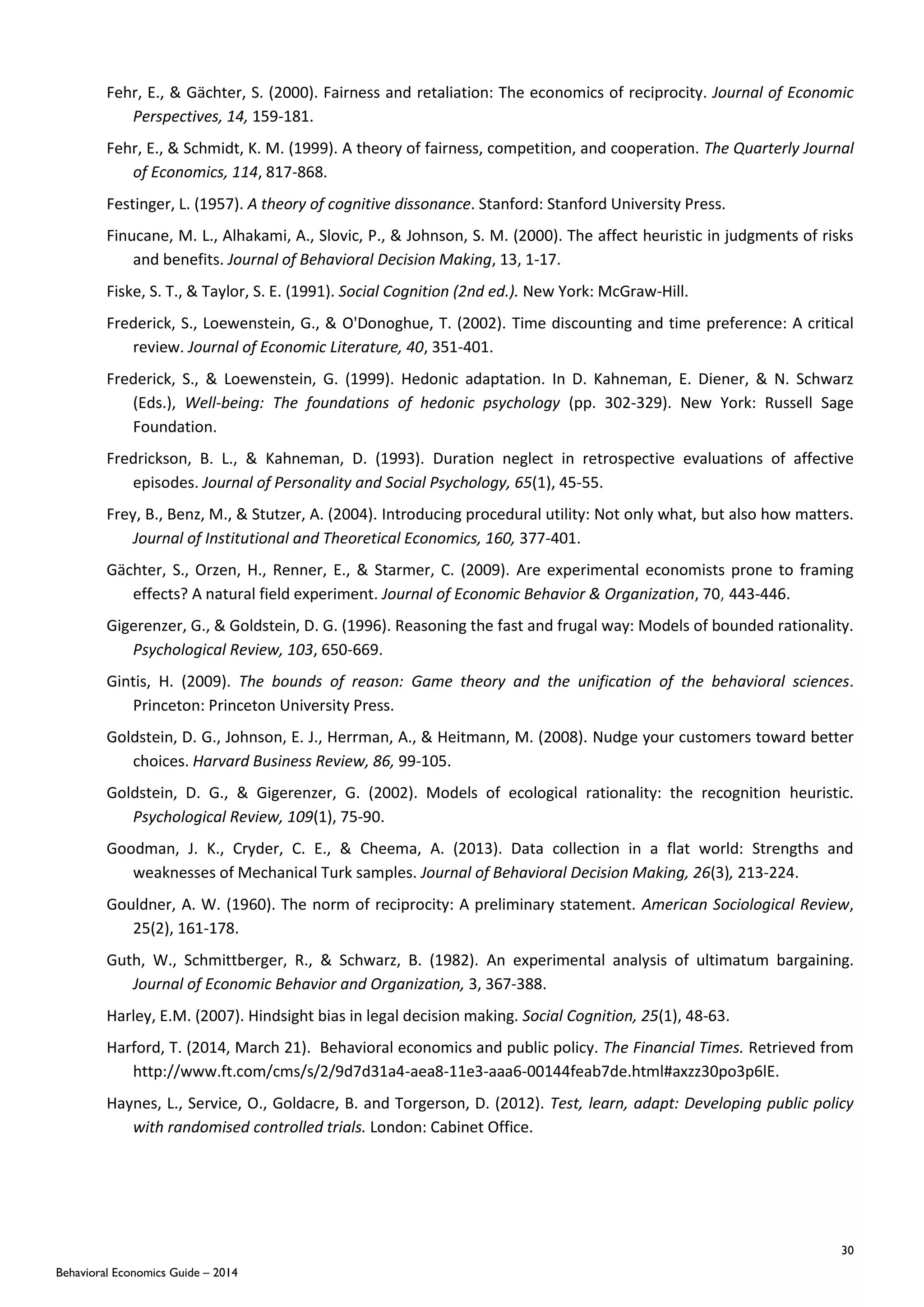
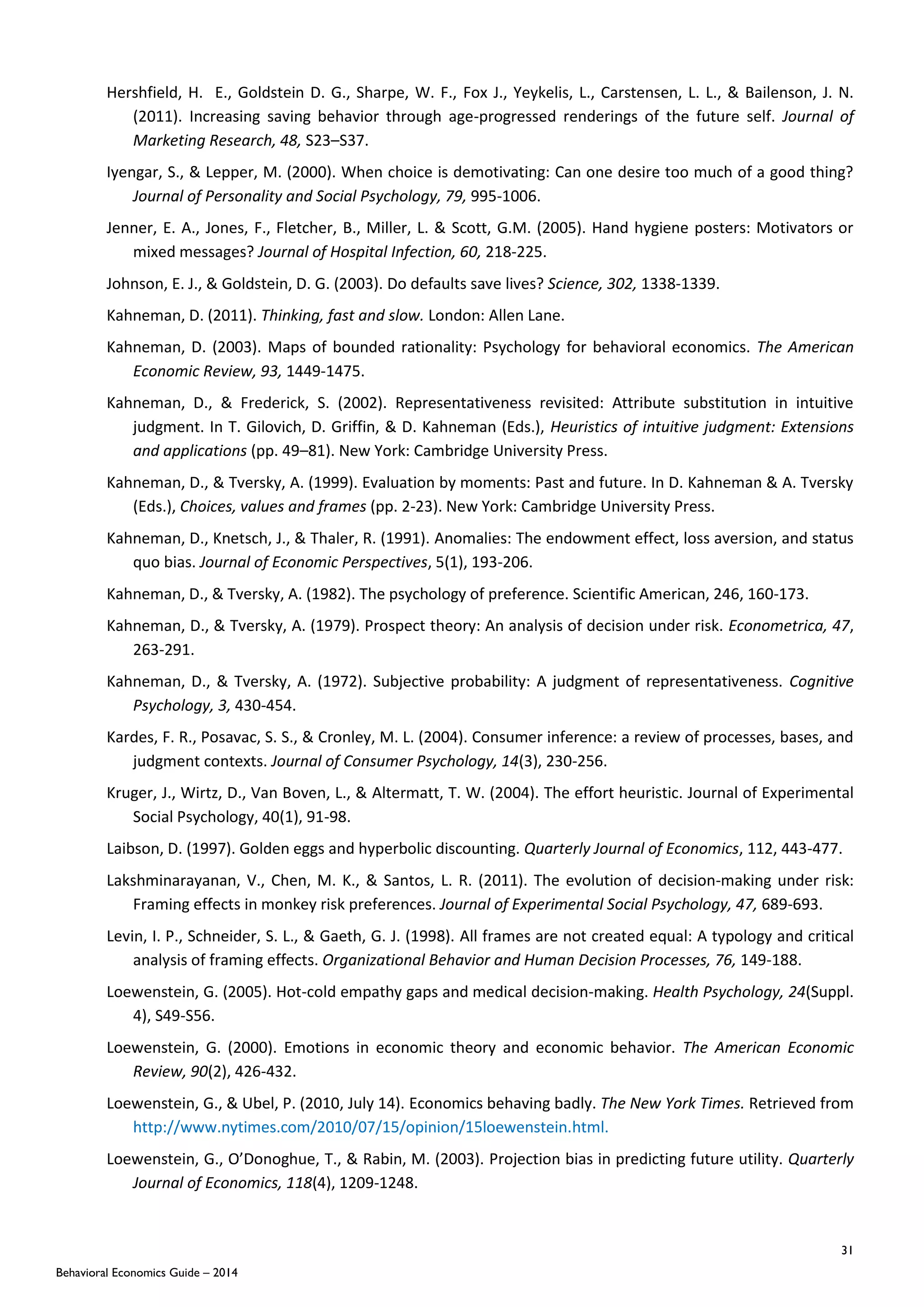
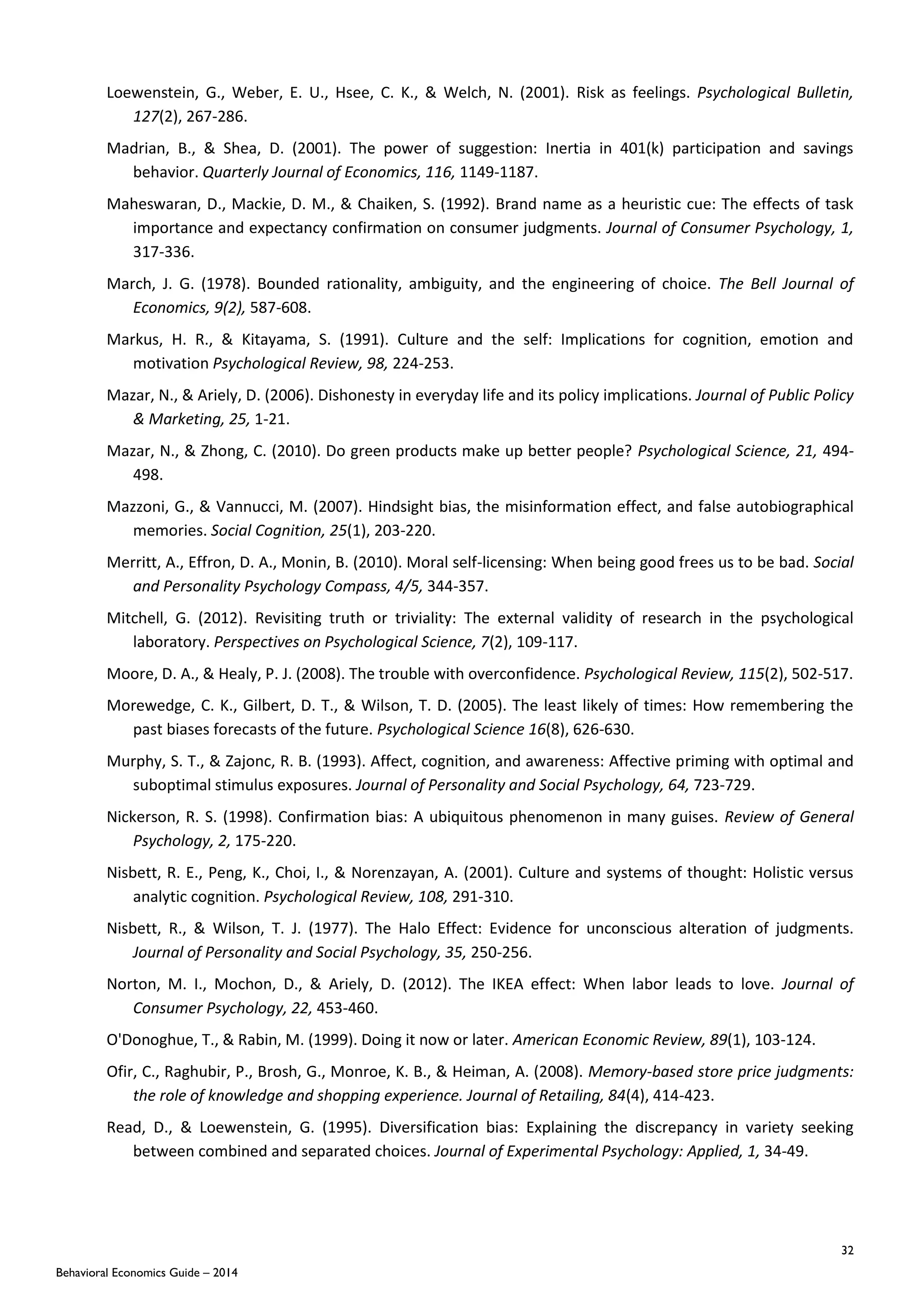
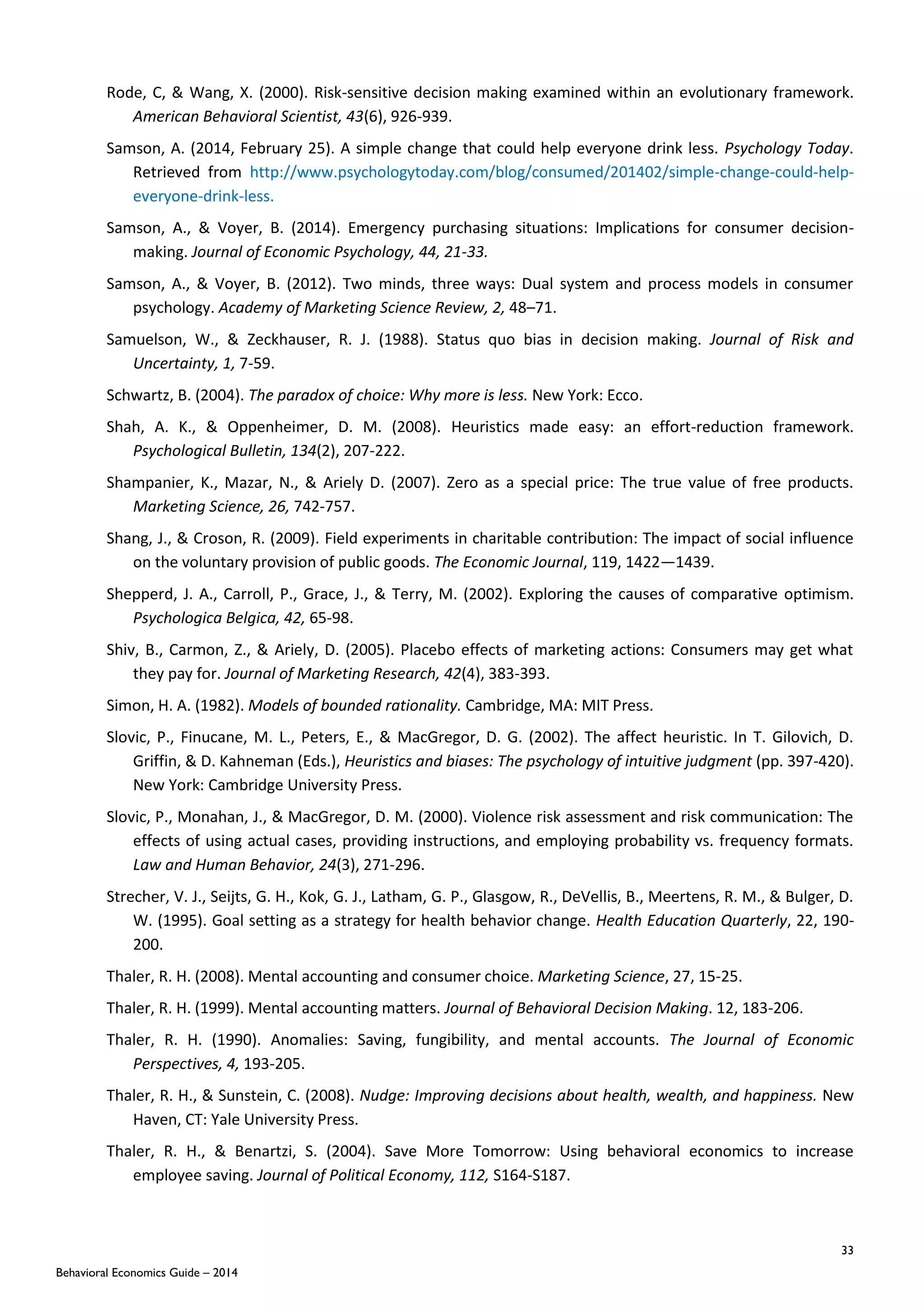
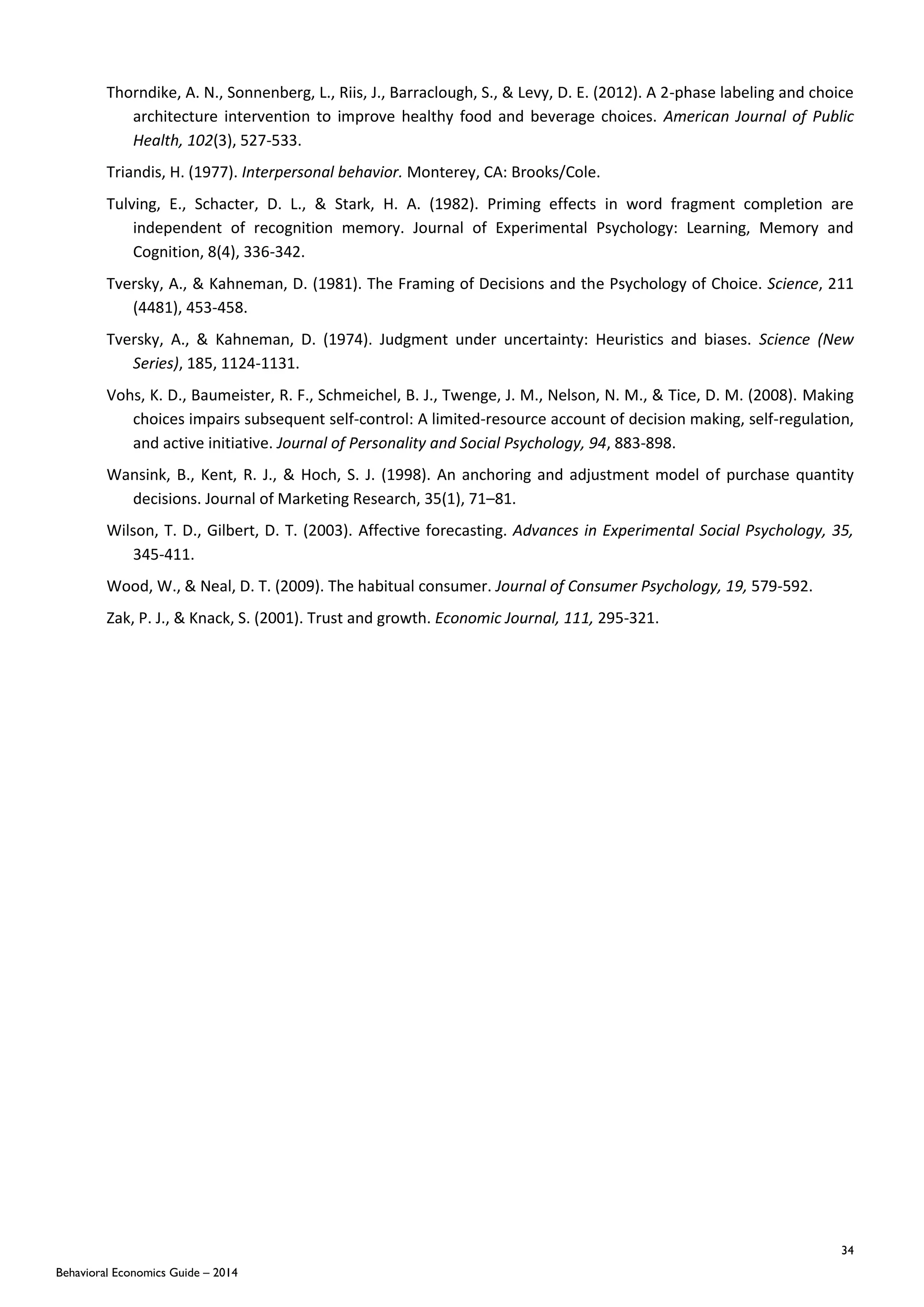
![35
Behavioral Economics Guide – 2014
PART 2 – RESOURCES
Books Read by Behavioral Economics Group Members
* Ratings retrieved from goodreads.com in April 2014
** Google Scholar citation, April 2014 (Note: does not reflect citations of individual chapters in edited books; excludes multiple Google Scholar items/versions
[item with highest count only])](https://image.slidesharecdn.com/beguide2014-140726231619-phpapp02/75/THE-BEHAVIORAL-ECONOMICS-GUIDE-2014-53-2048.jpg)
![36
Behavioral Economics Guide – 2014
* Ratings retrieved from goodreads.com in April 2014
** Google Scholar citations, April 2014 (Note: does not reflect citations of individual chapters in edited books; excludes multiple Google Scholar items/versions
[item with highest count only])](https://image.slidesharecdn.com/beguide2014-140726231619-phpapp02/75/THE-BEHAVIORAL-ECONOMICS-GUIDE-2014-54-2048.jpg)
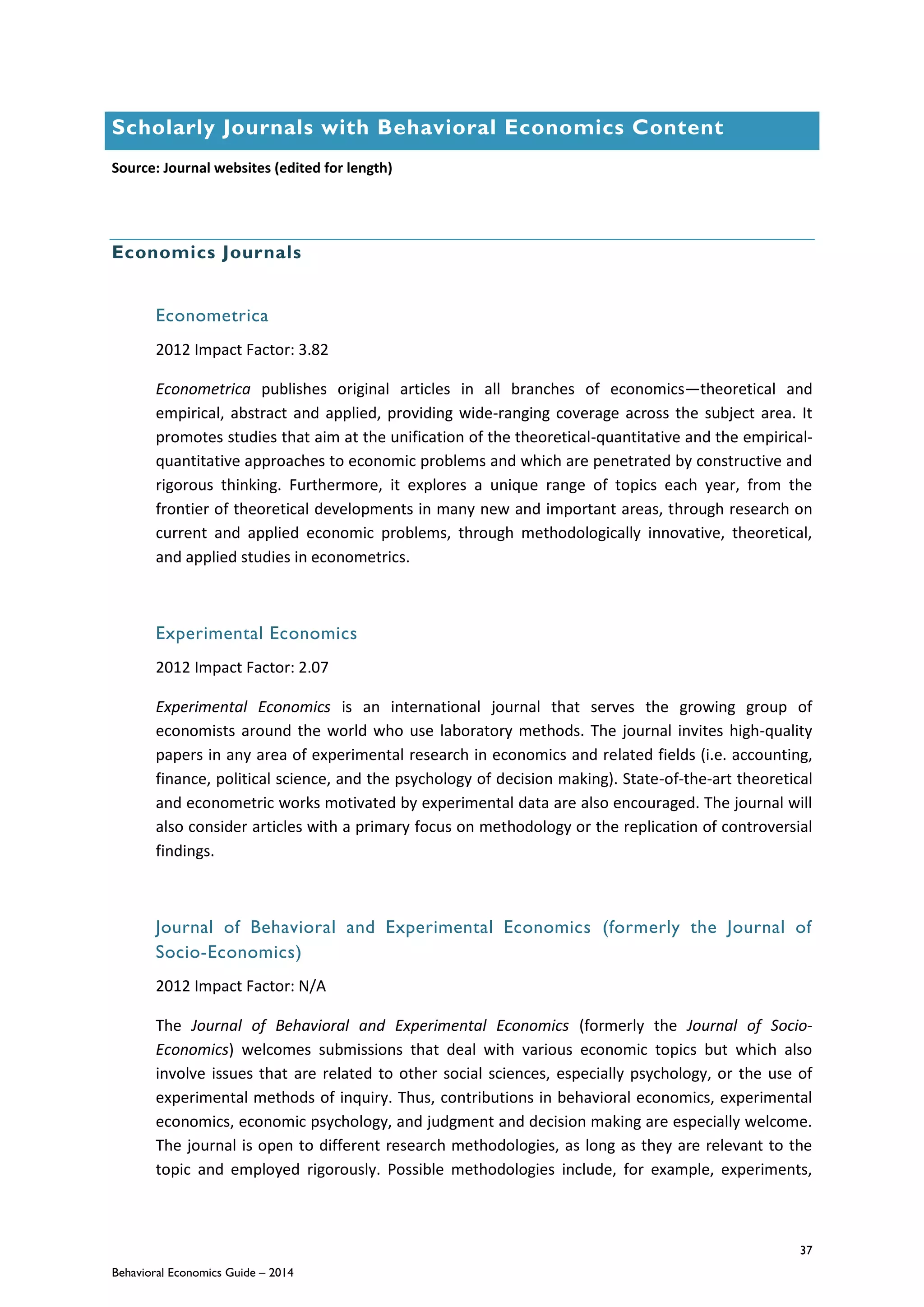
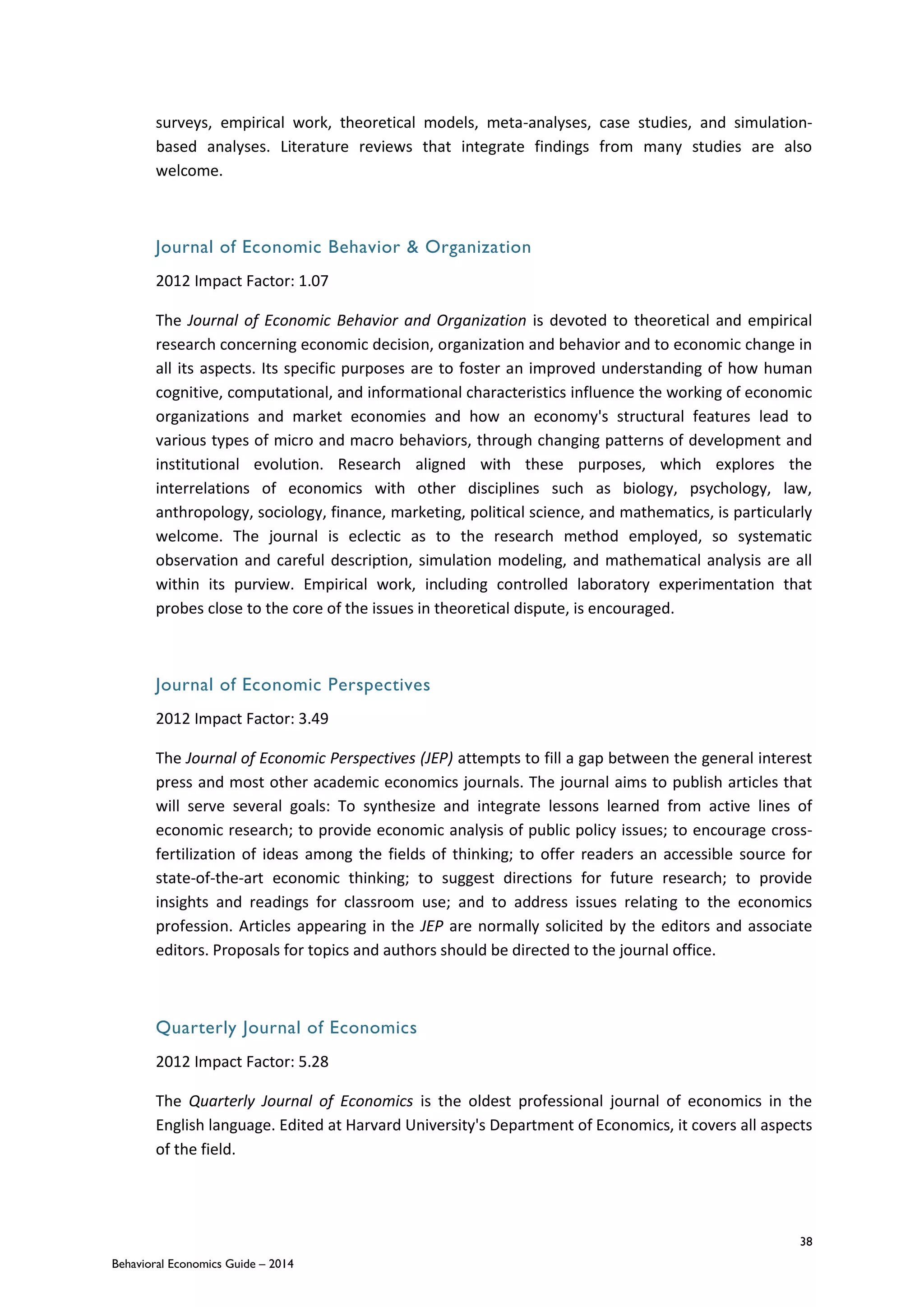
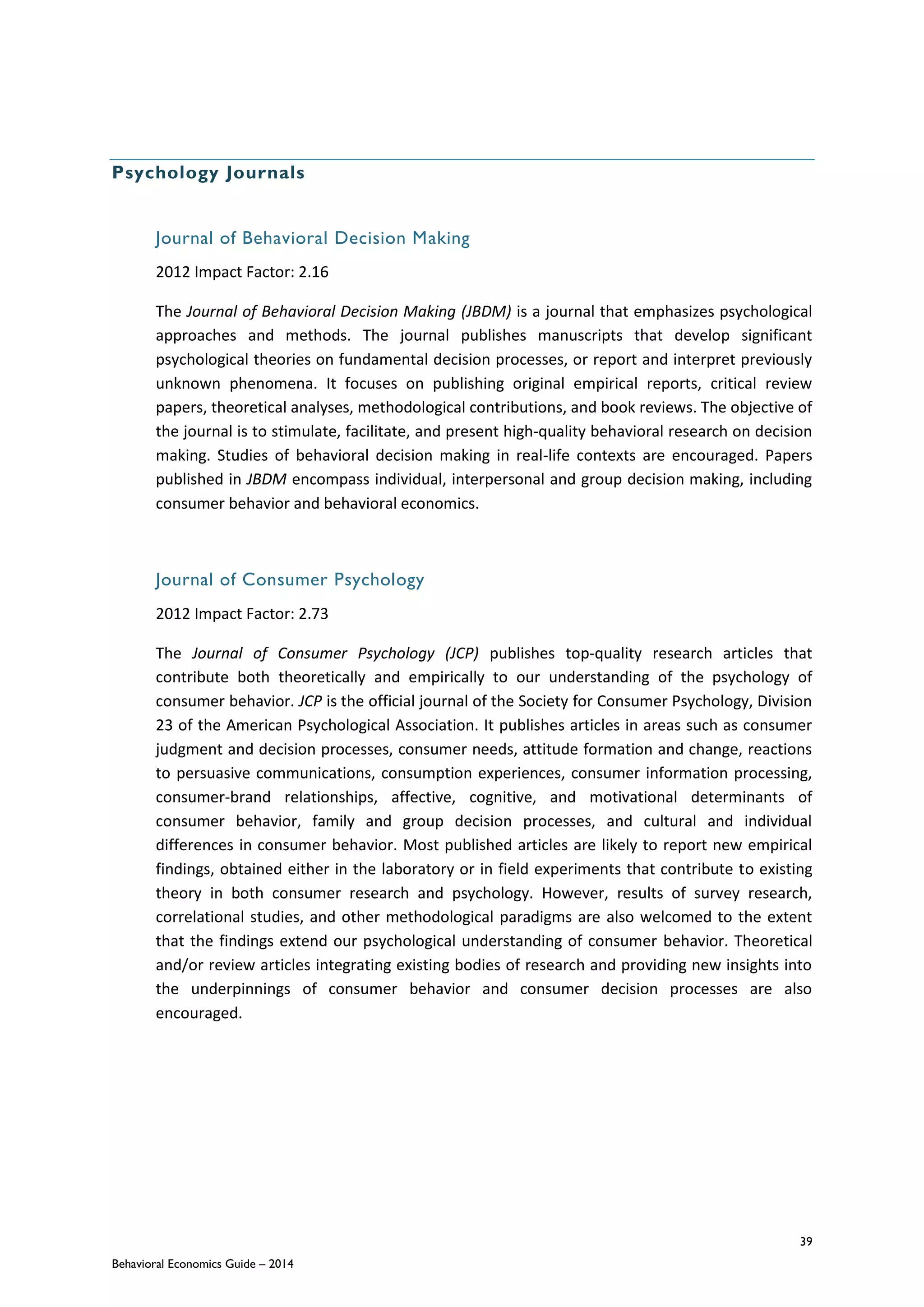
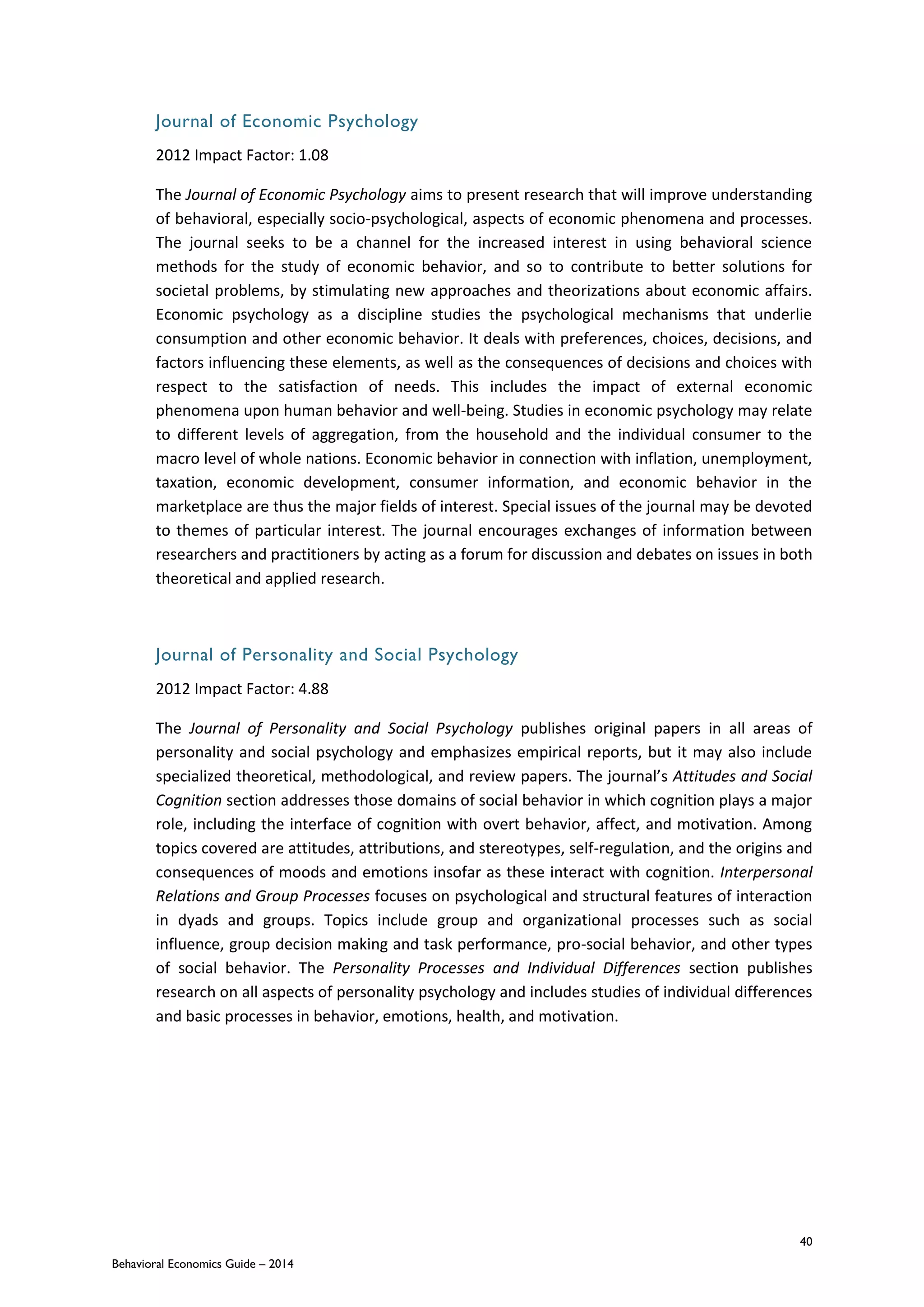
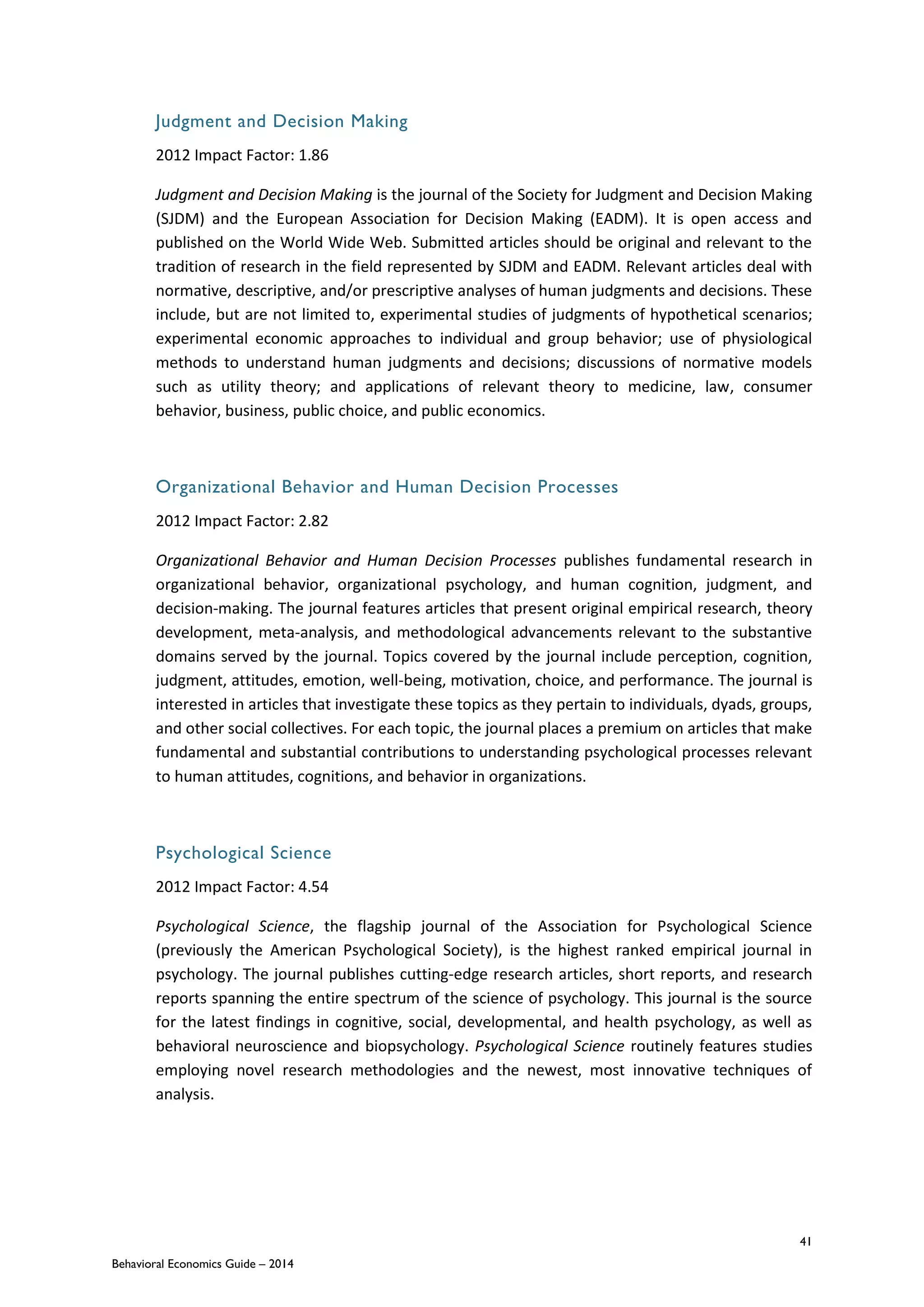
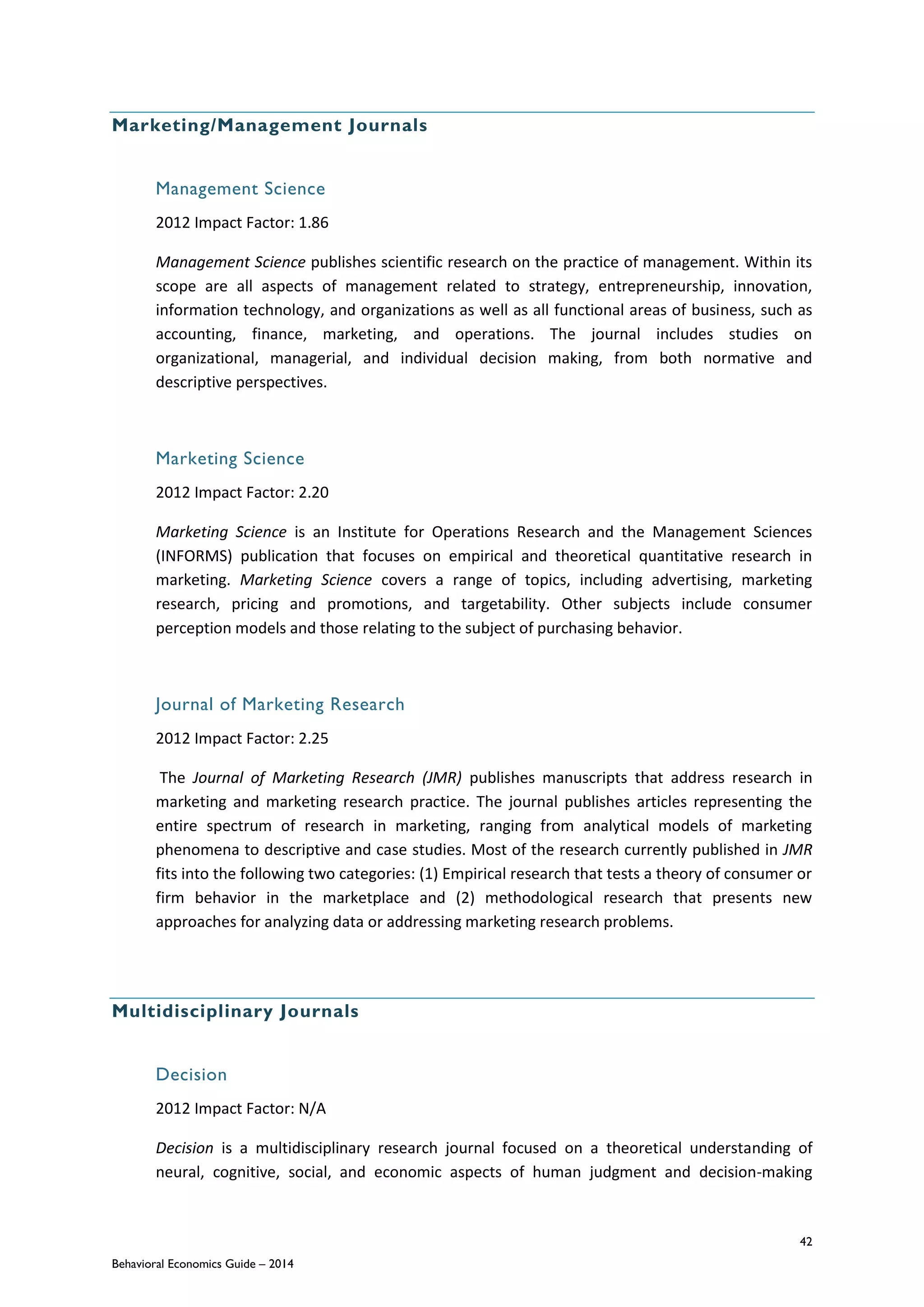

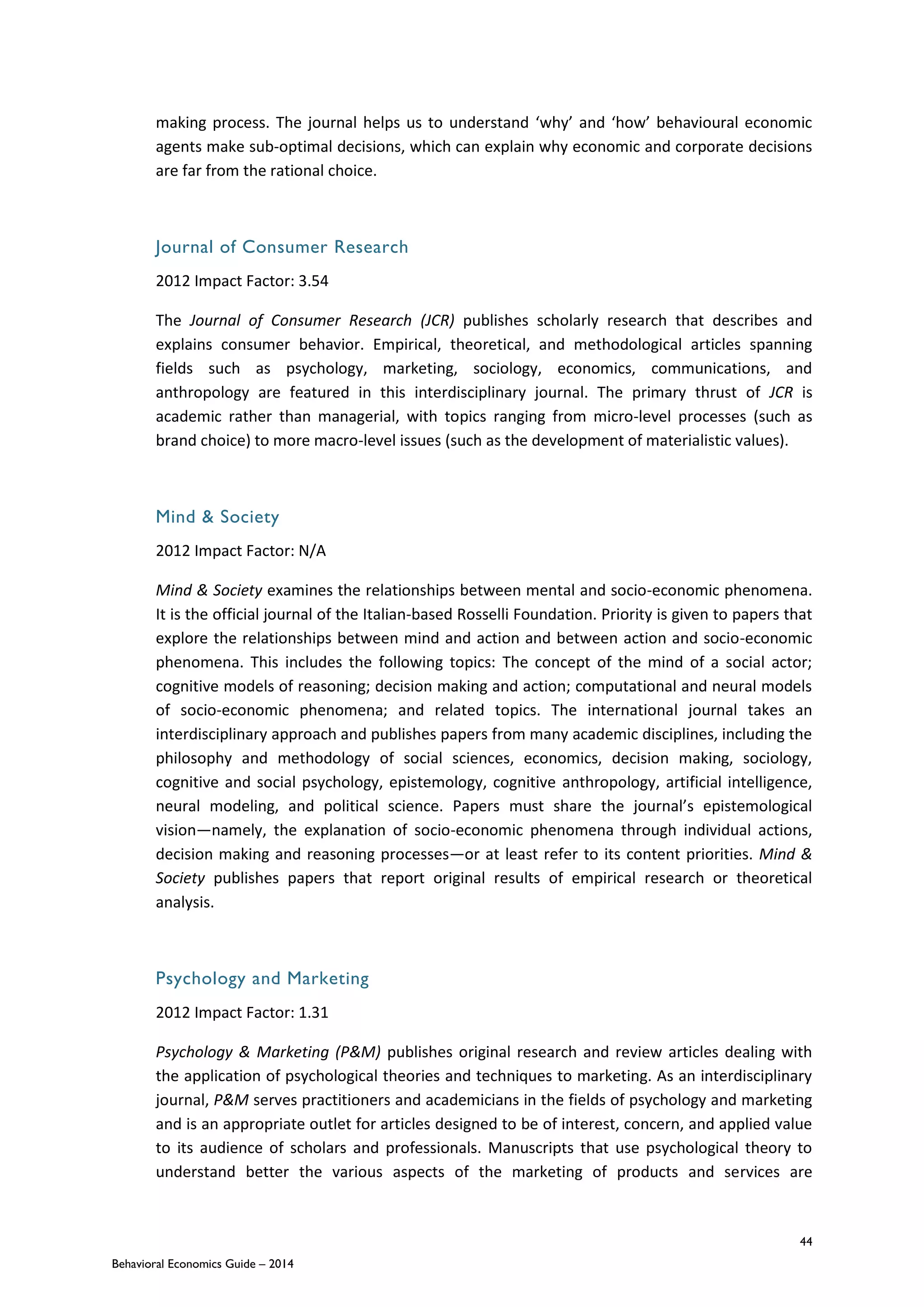
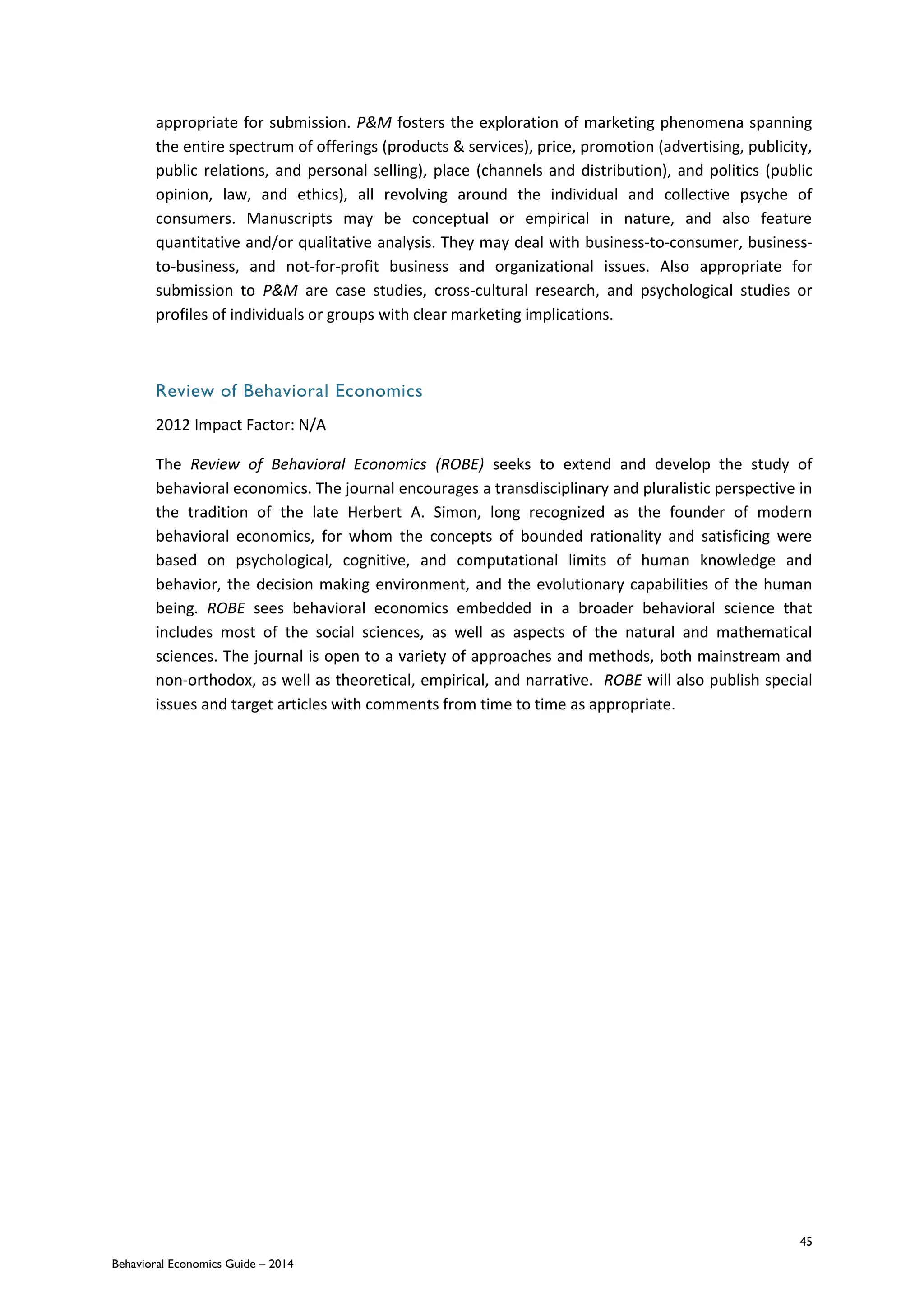
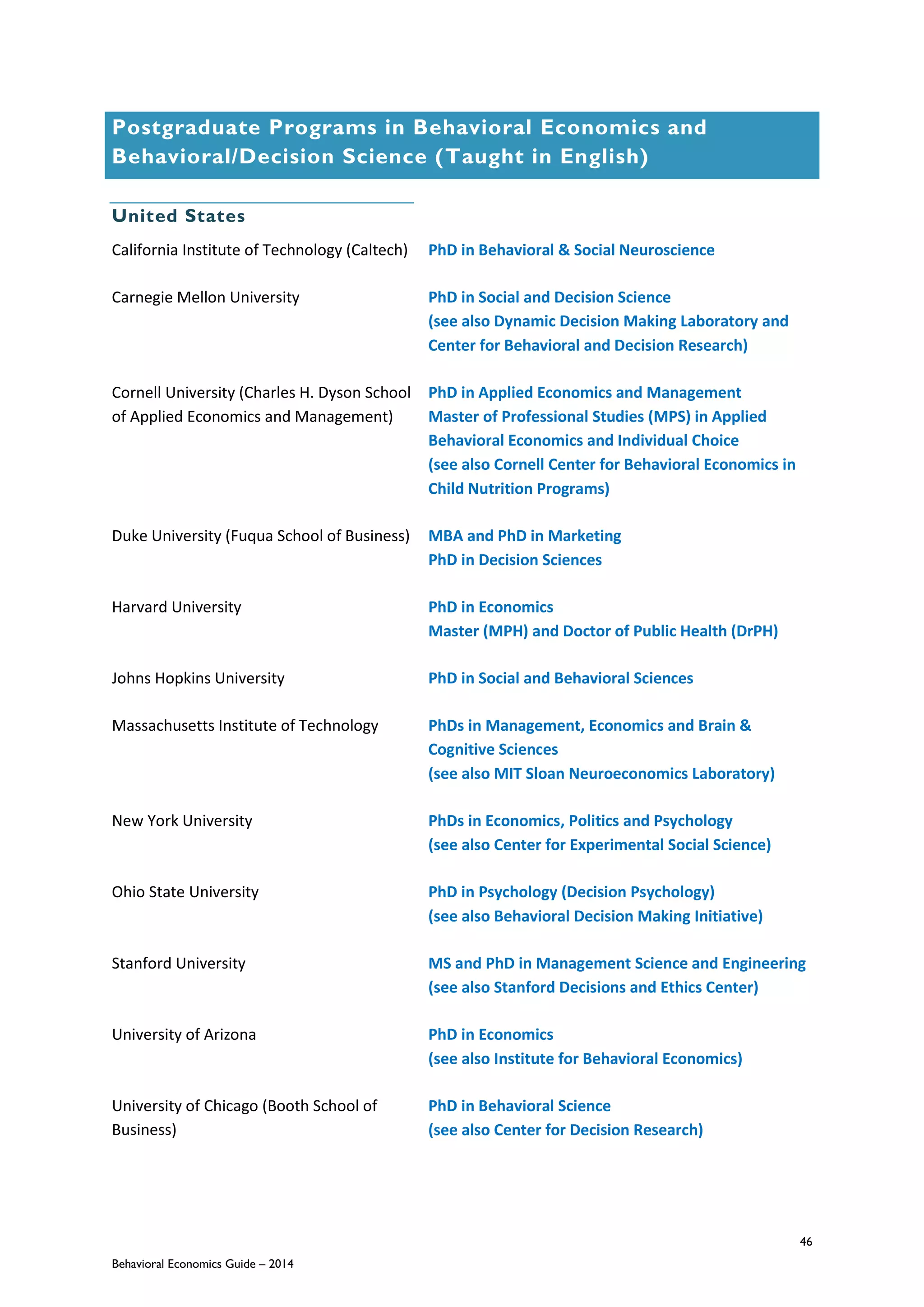

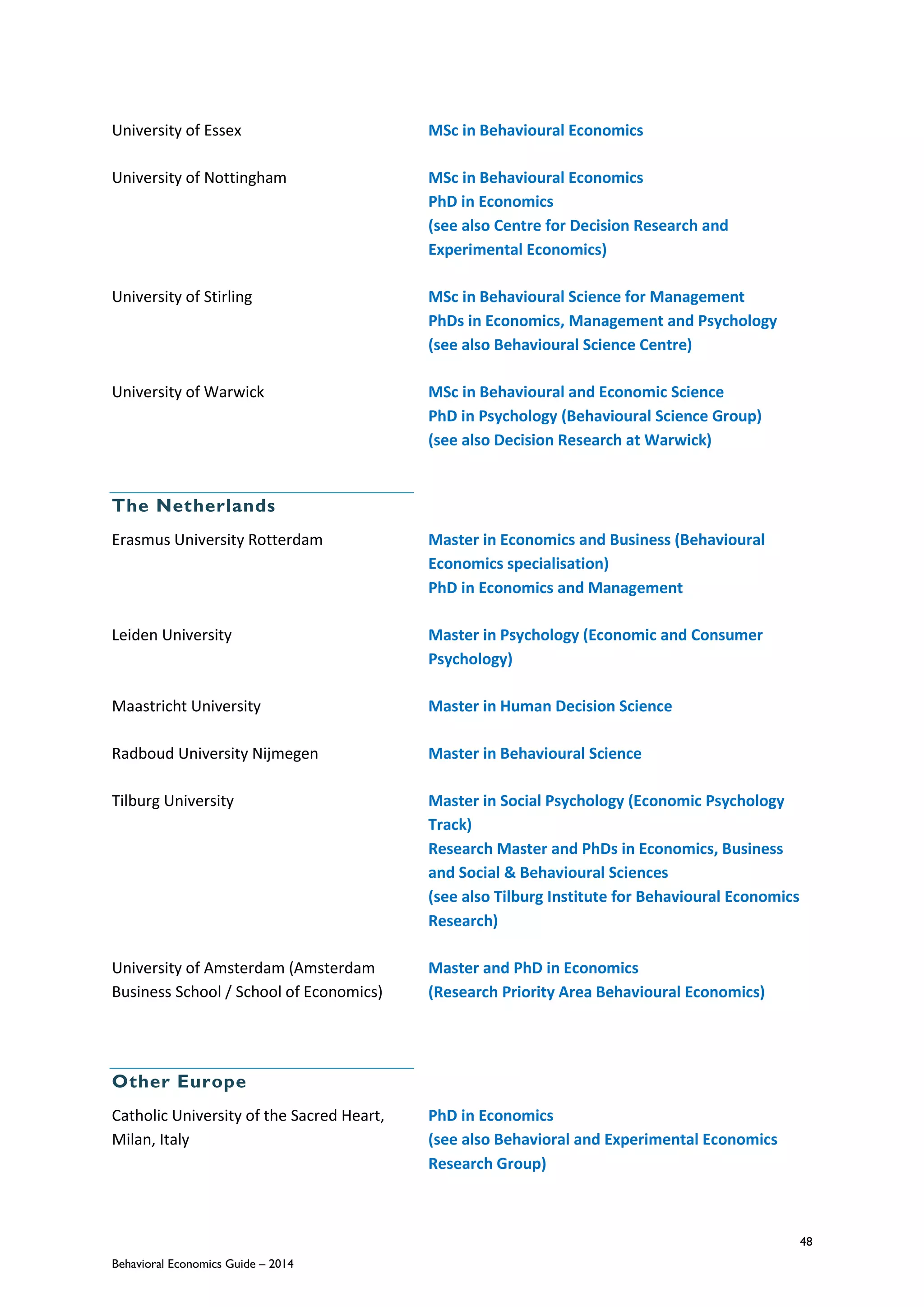
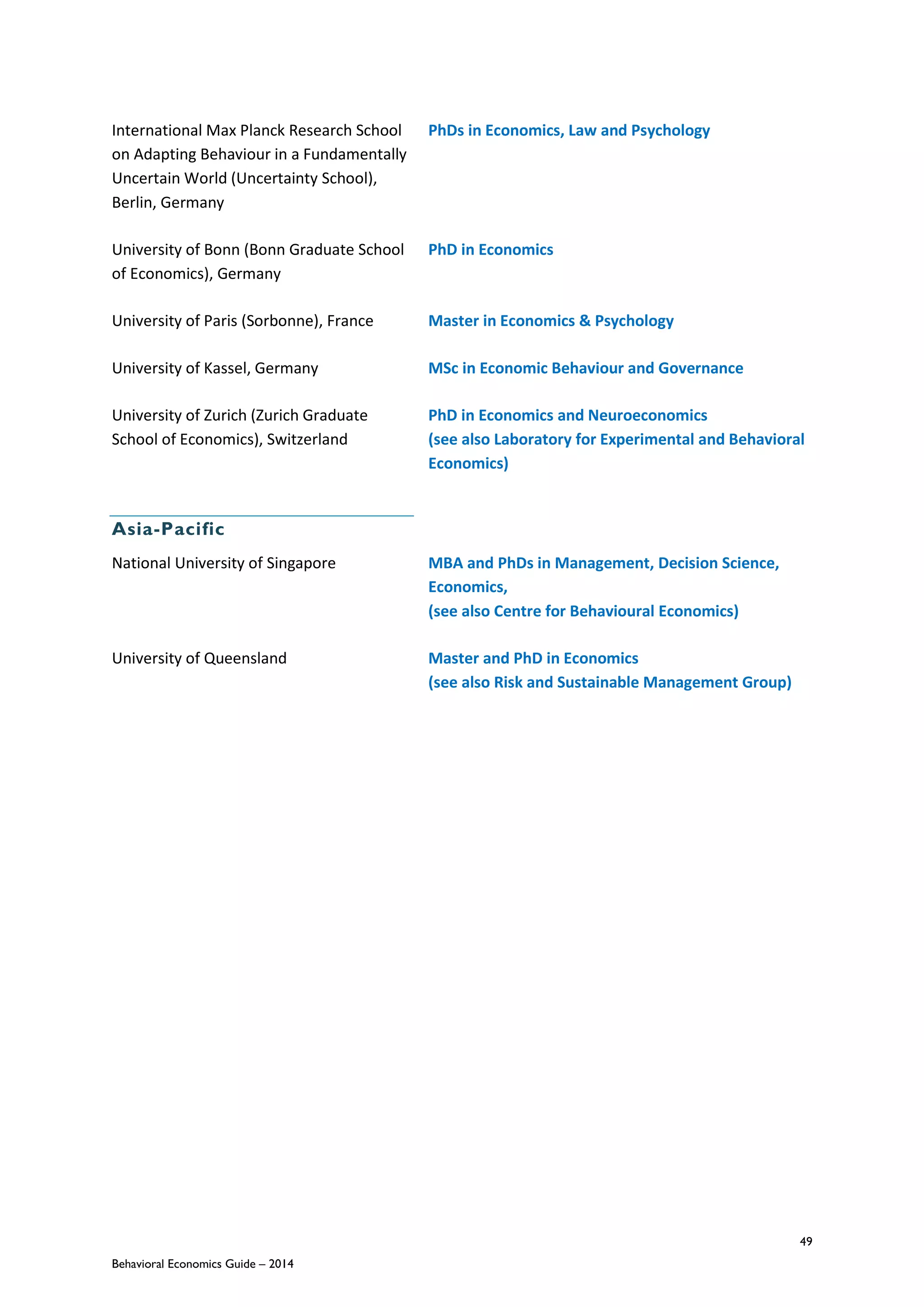
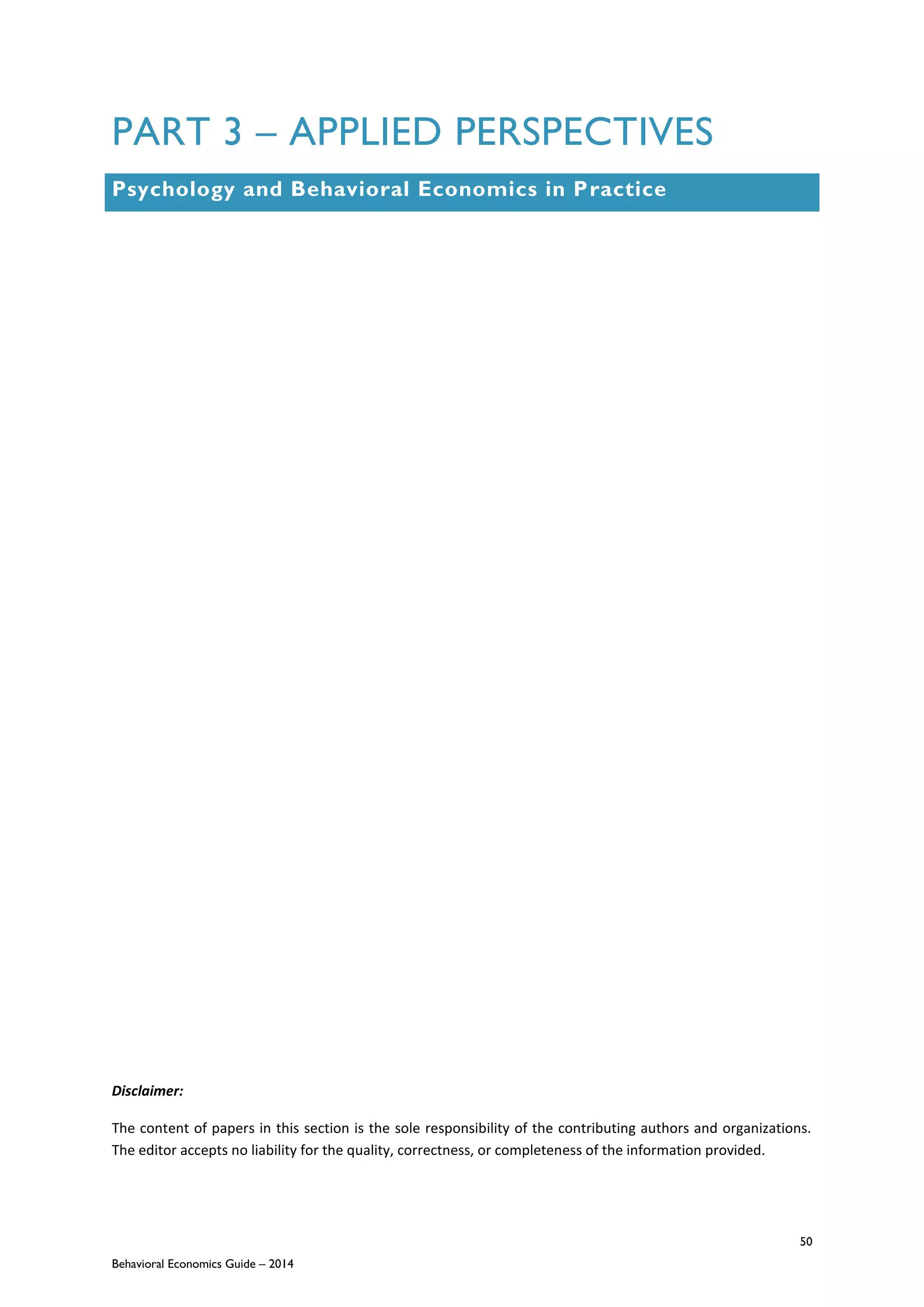
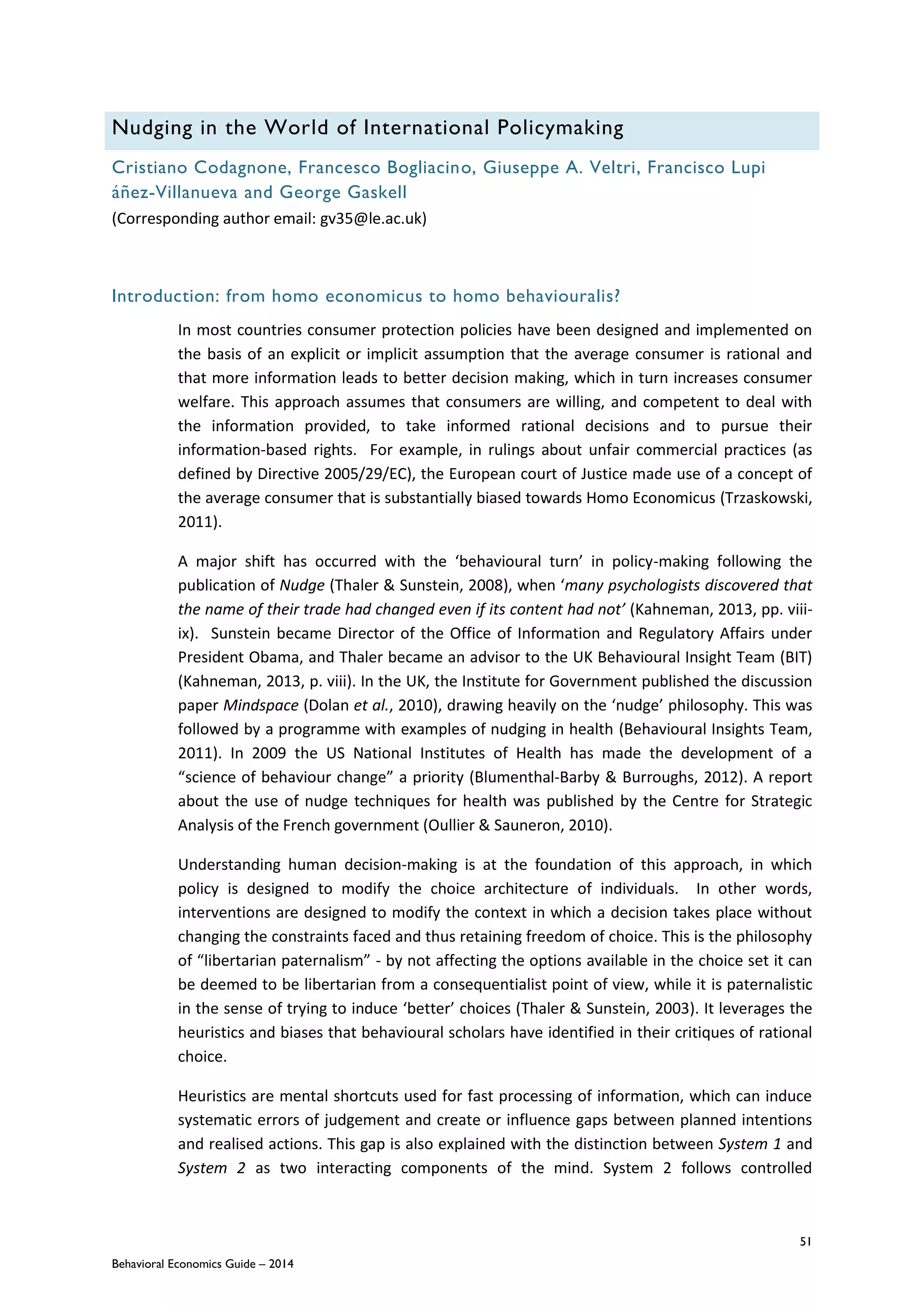

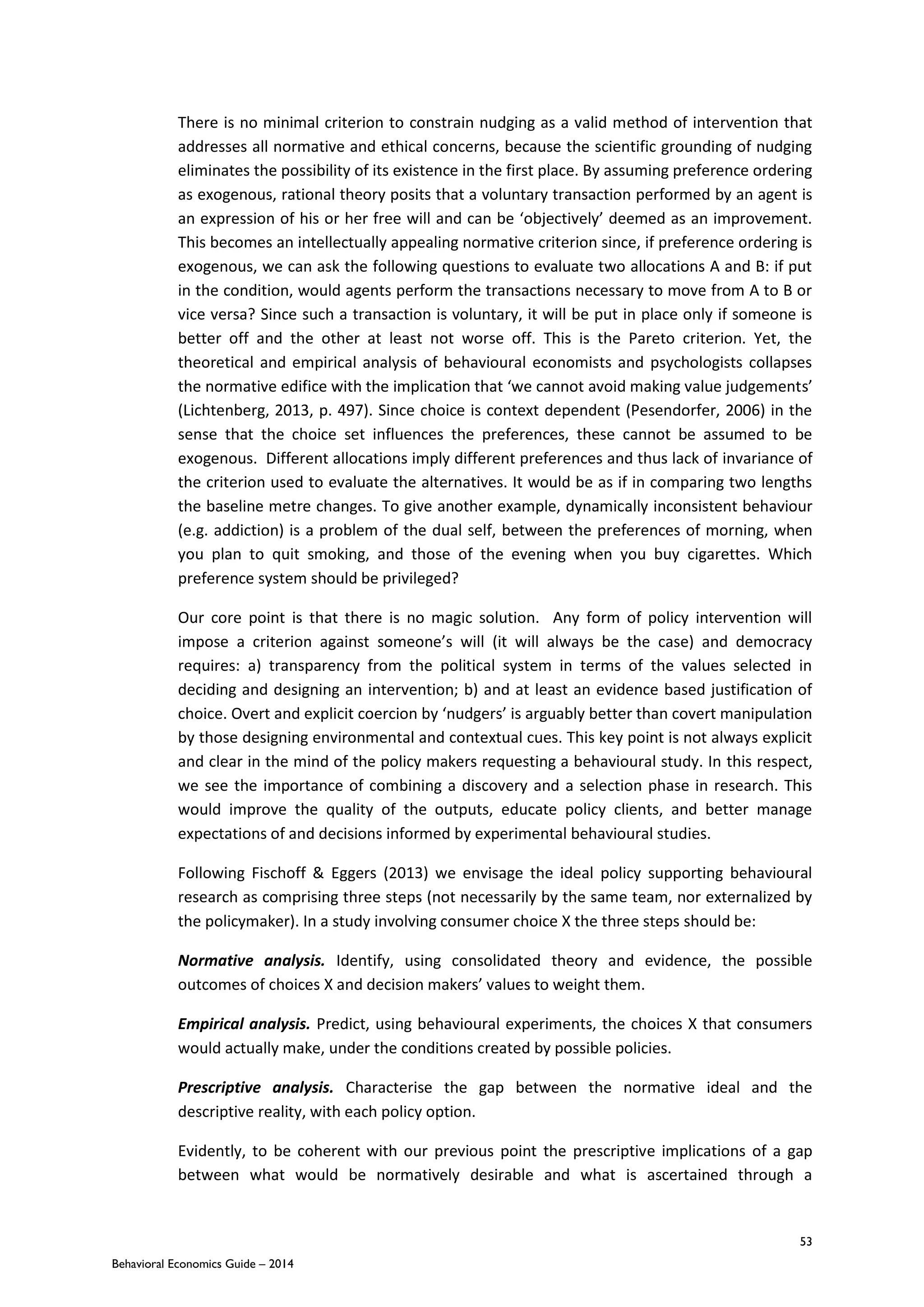
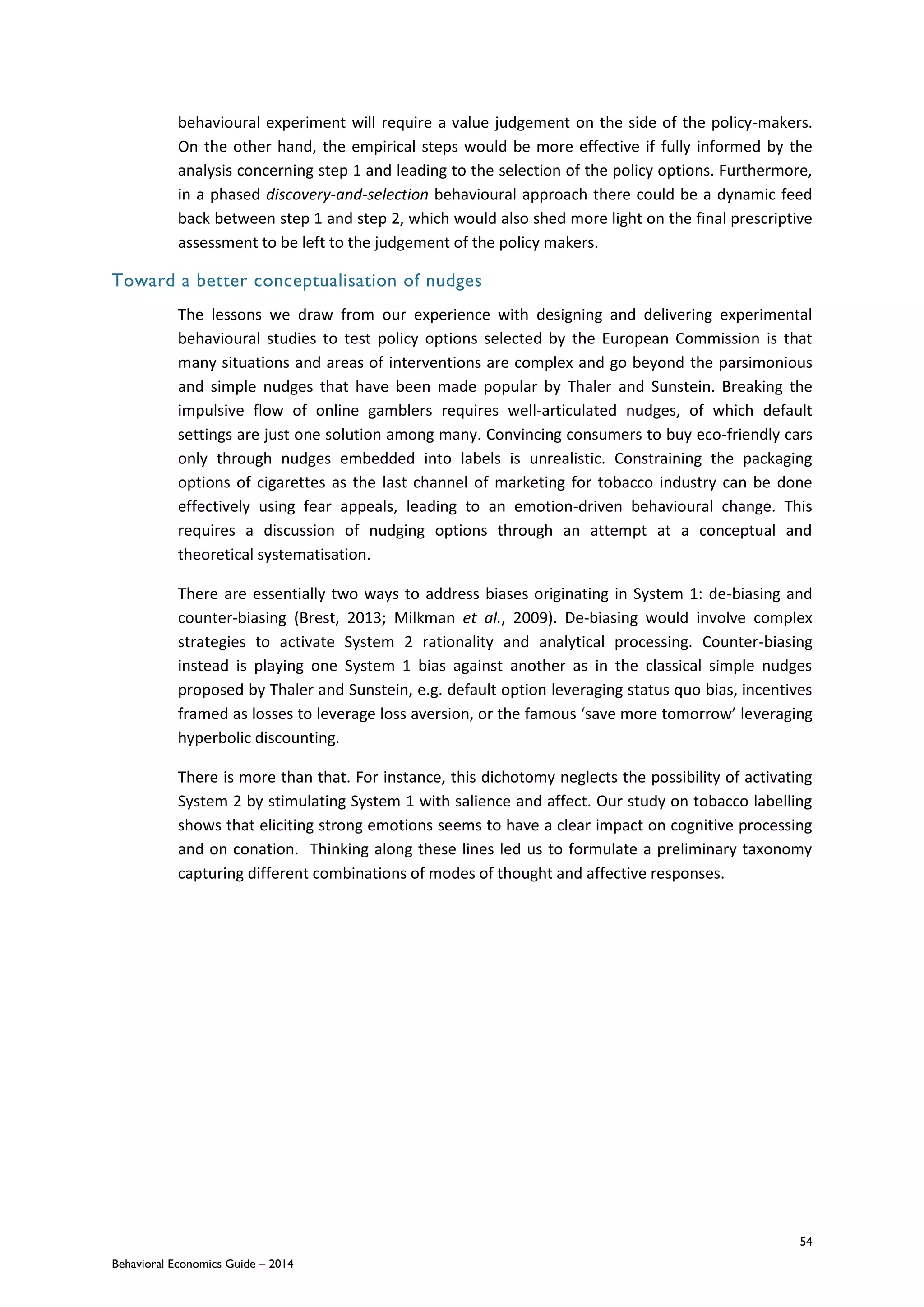
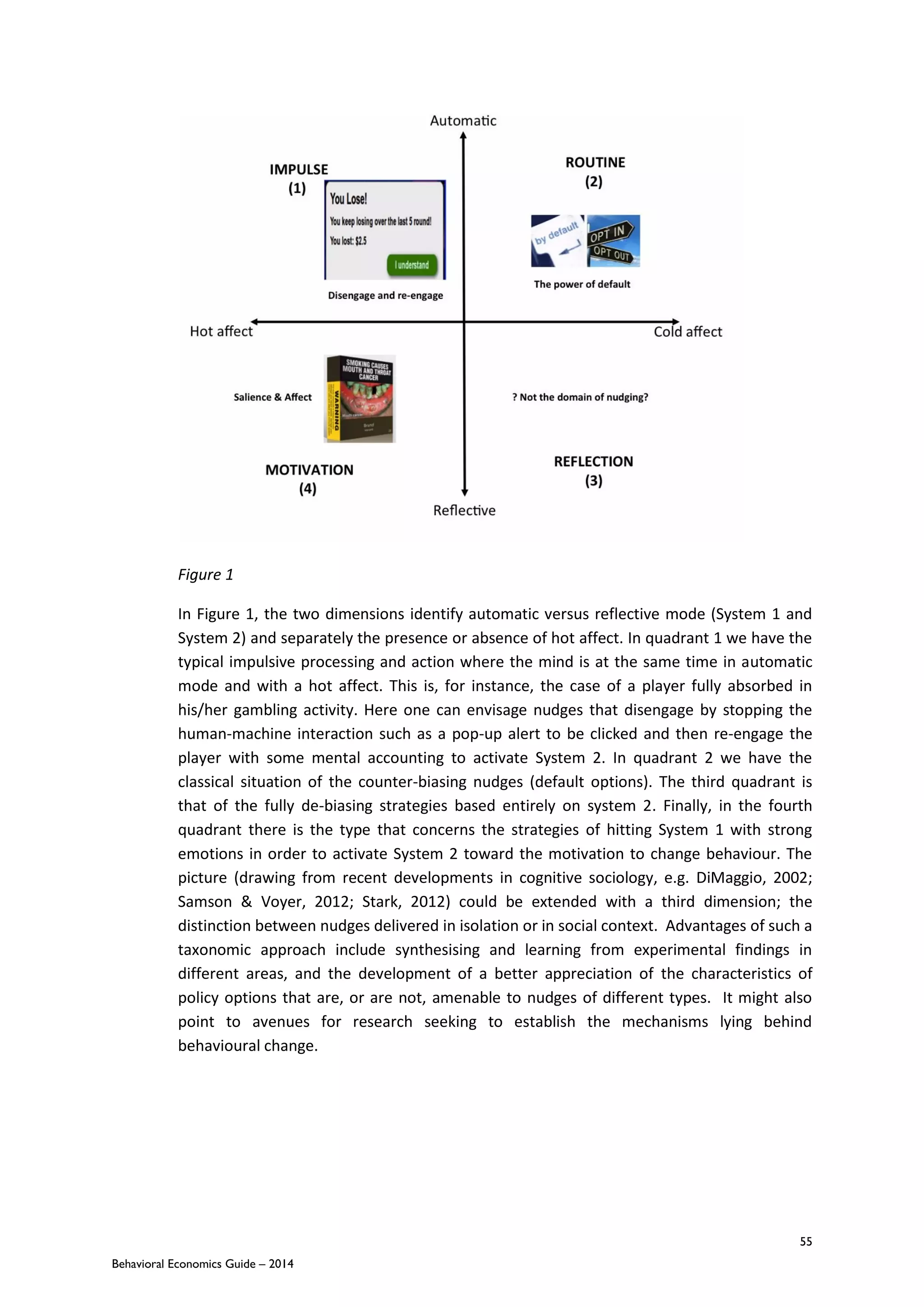
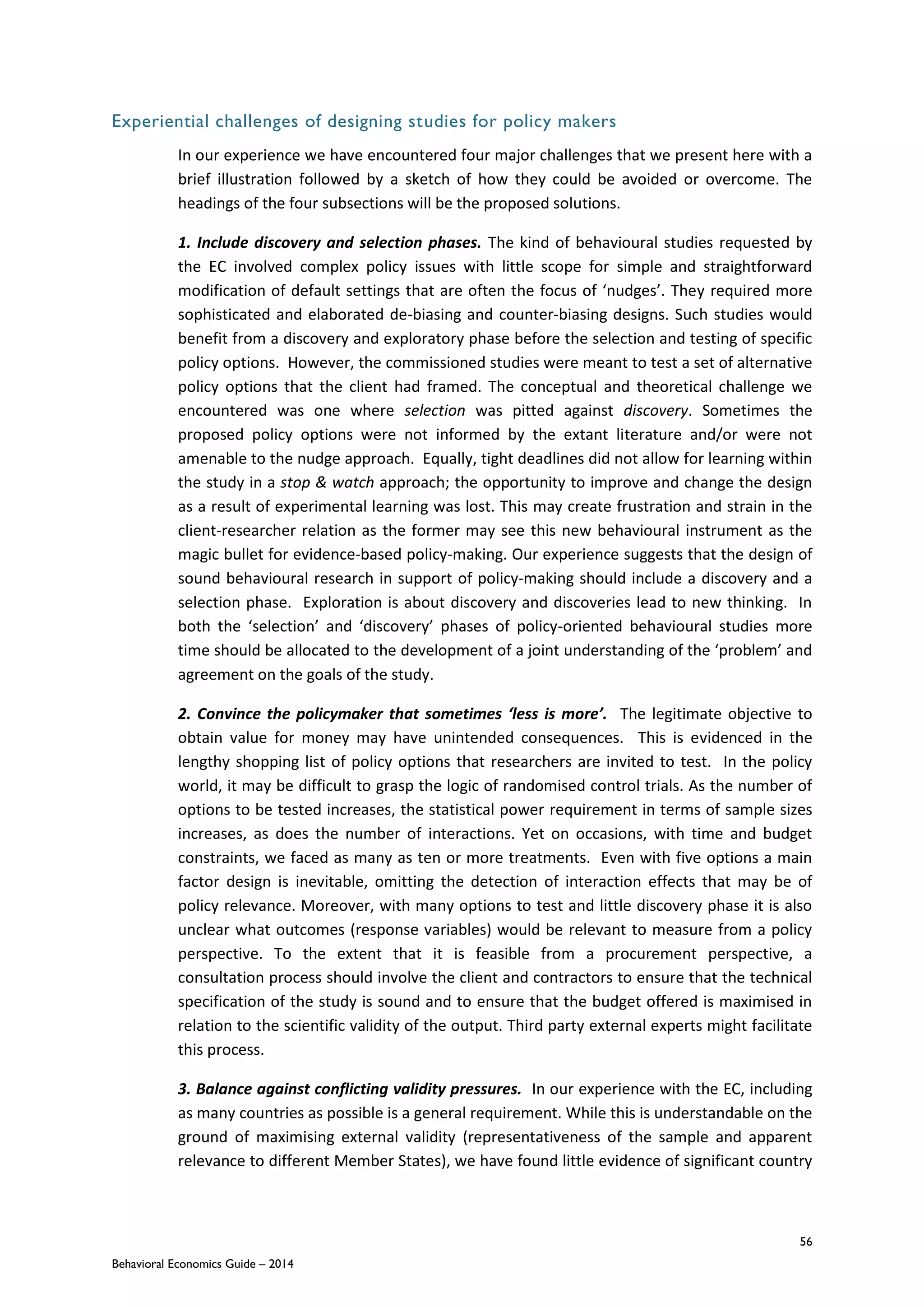

![58
Behavioral Economics Guide – 2014
Oullier, O., & Sauneron, S. (2010). Improving public health prevention with behavioural,
cognitive, and neuroscience. Paris: Centre d'analyse stratégique.
Pesendorfer W. Behavioral economics comes of age: A review essay on advances in
behavioral economics. Journal of Economic Literature 2006;44(3):712-21.
Samson, A., & Voyer, B. (2012). Two minds, three ways: Dual system and dual process
models in consumer psychology. AMS Review, 2(2-4), 48-71.
Shafir, E. (Ed.). (2013). The behavioural foundations of public policy. Princeton, NJ:
Princeton University Press.
Slovic, P. (1995). The construction of preferences. American Psychologist, 50, 364-371.
Stark, M. (2012). Reconciling bioethics with health care strategies born of behavioral
economics and psychology. [Comment]. The American Journal of Bioethics : AJOB,
12(2), 28-30. doi: 10.1080/15265161.2011.634491
Strack, F., & Deutsch, R. (2004). Reflective and impulsive determinants of social behavior.
Personality and Social Psychology Review, 8(3), 220-247.
Strack, F., Werth‚L., & Deutsch, R. (2006). Reflective and impulsive determinants of
consumer behavior. Journal of Consumer Psychology, 16(3), 205-216.
Thaler, R. (1980). Toward a positive theory of consumer choice. Journal of Economic
Behavior and Organization, 1, 36-60.
Thaler, R., & Sunstein, C. (2008). Nudge : Improving decisions about health, wealth, and
happiness. New Haven: Yale University Press.
Thaler, R. H., & Sunstein, C. R. (2003). Libertarian paternalism.
[10.1257/000282803321947001]. American Economic Review, 93(2), 175-179.
Thompson, V. (2009). Dual-process theories: A metacognitive perspective. In J. Evans & K.
Frankish (Eds.), In two minds: dual processes and beyond (pp. 171-195). Oxford: Oxford
University Press.
Trzaskowski, J. (2011). Behavioural economics, neuroscience, and the Unfair Commercial
Practises Directive. Journal of Consumer Policy, 34(3), 377-392. doi: 10.1007/s10603-
011-9169-2
Tversky, A., & Kahneman, D. (1974). Judgment under uncertainty: Heuristics and biases.
Science 185, 1124–1131.](https://image.slidesharecdn.com/beguide2014-140726231619-phpapp02/75/THE-BEHAVIORAL-ECONOMICS-GUIDE-2014-76-2048.jpg)
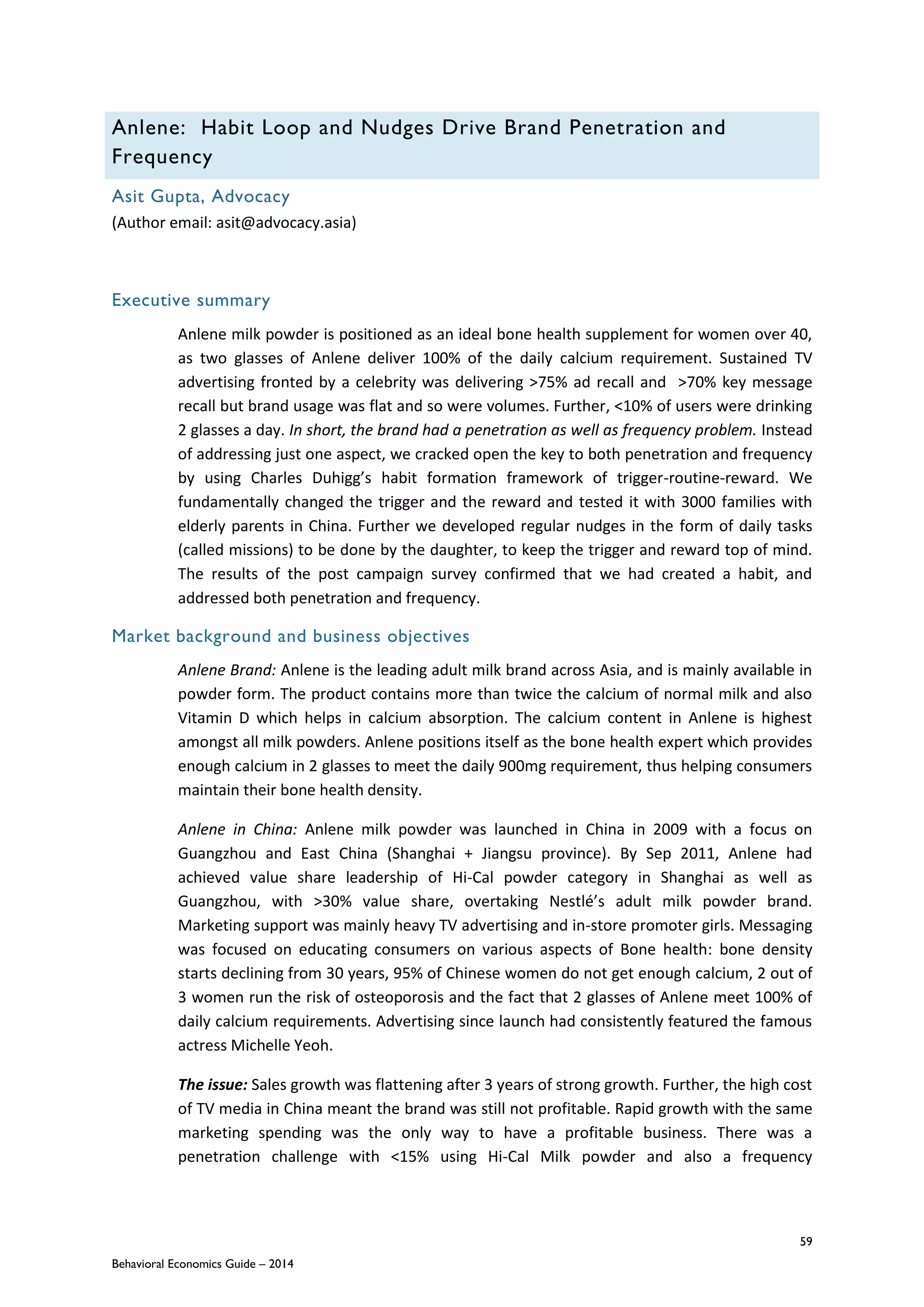
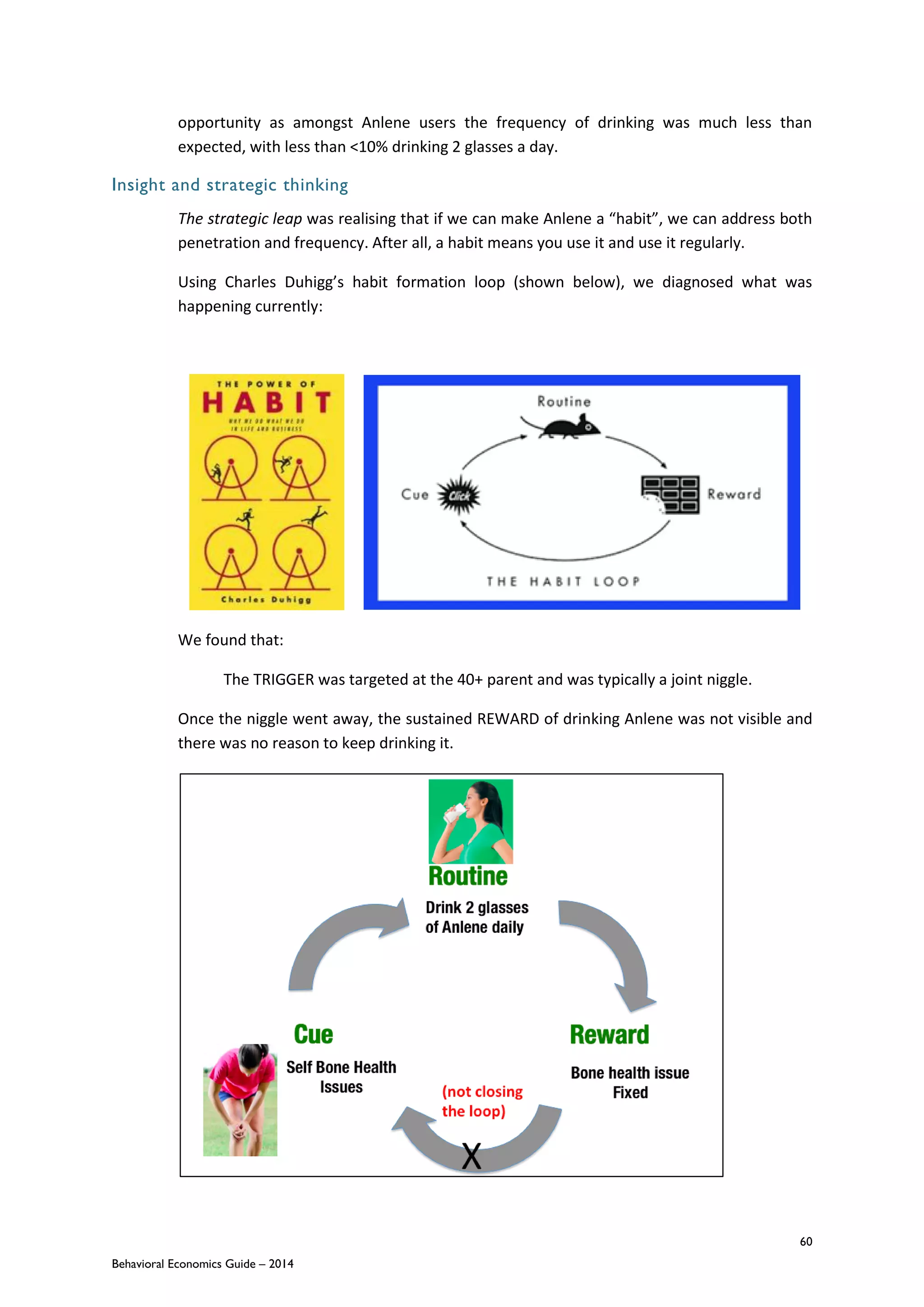
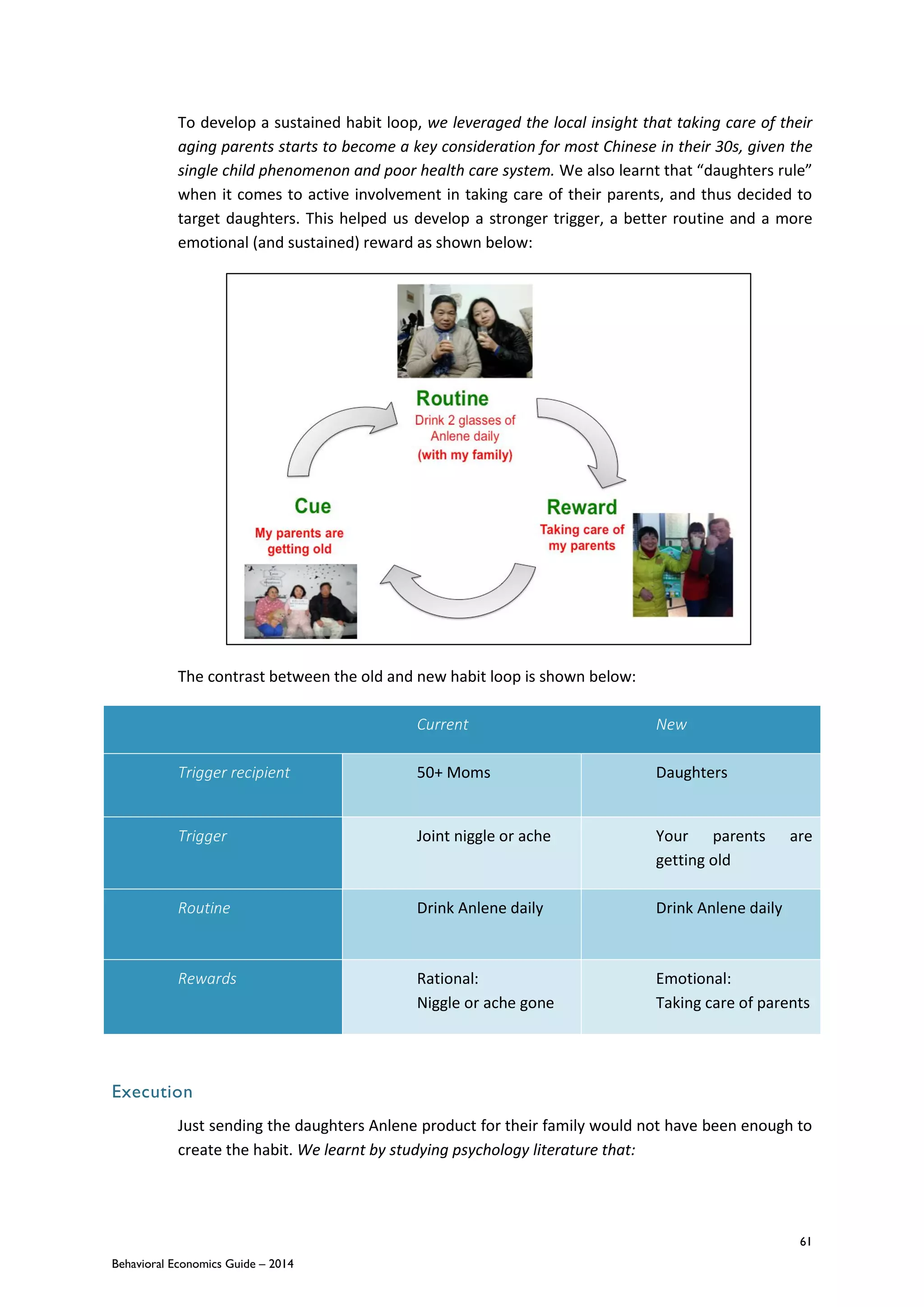
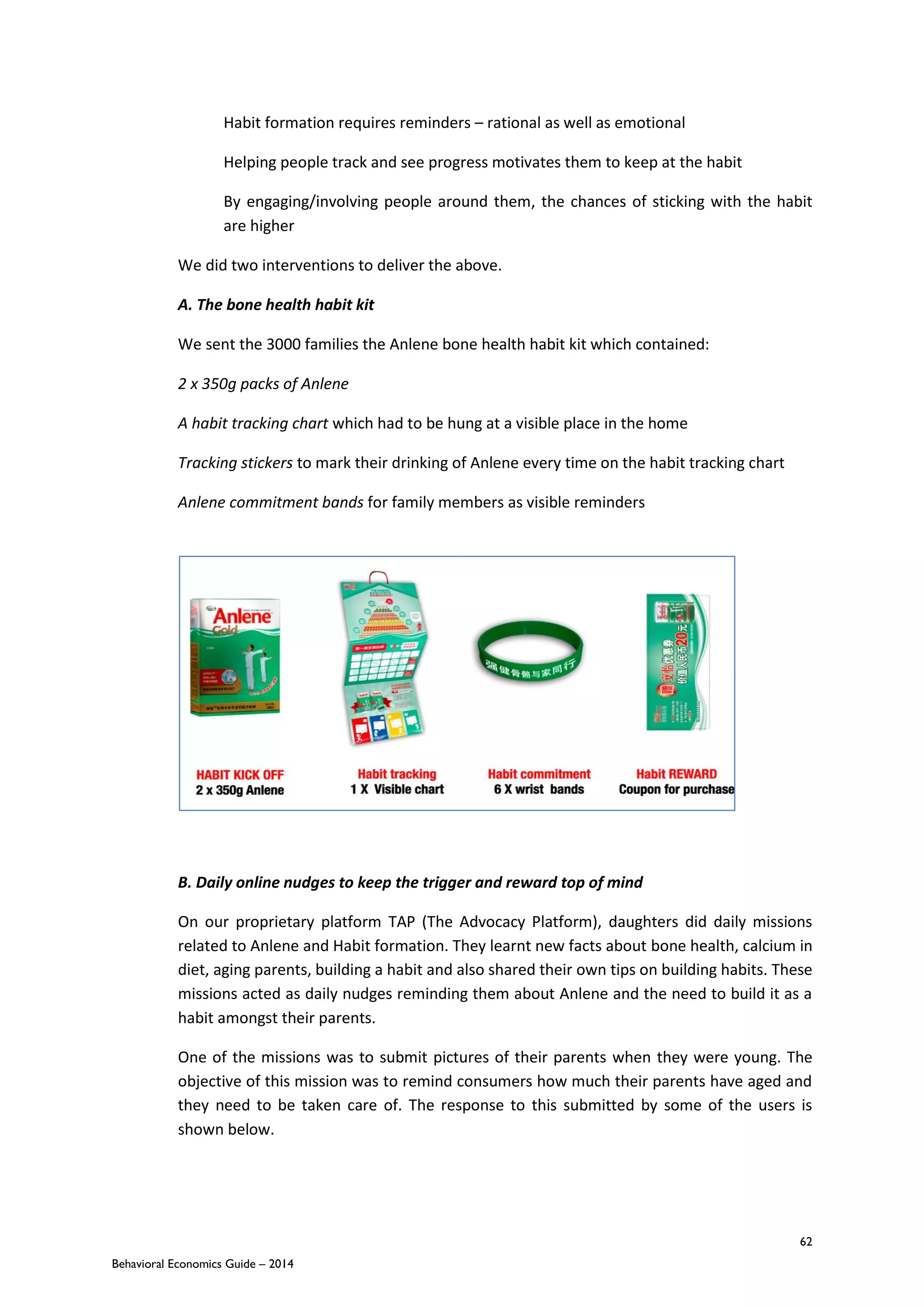
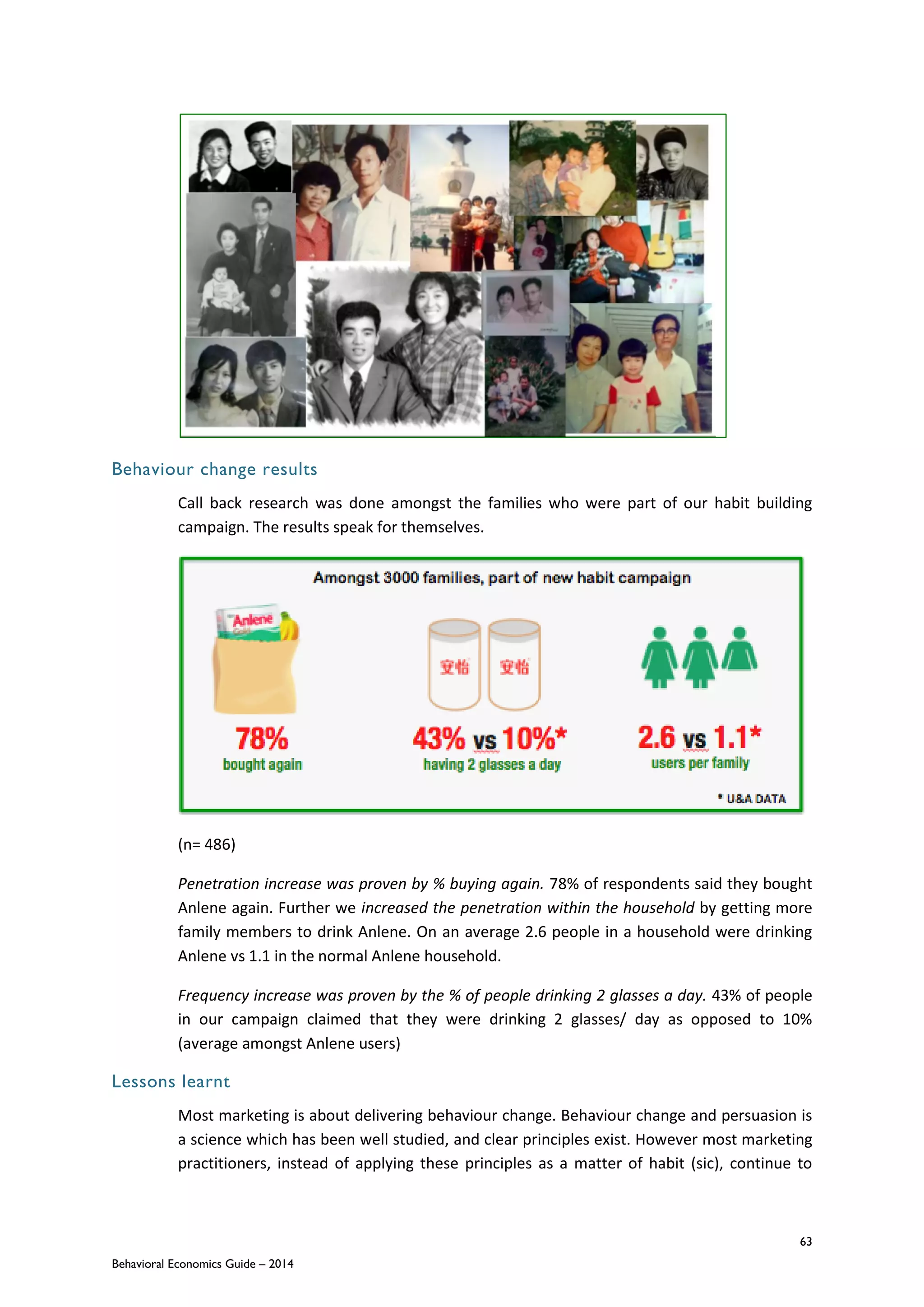
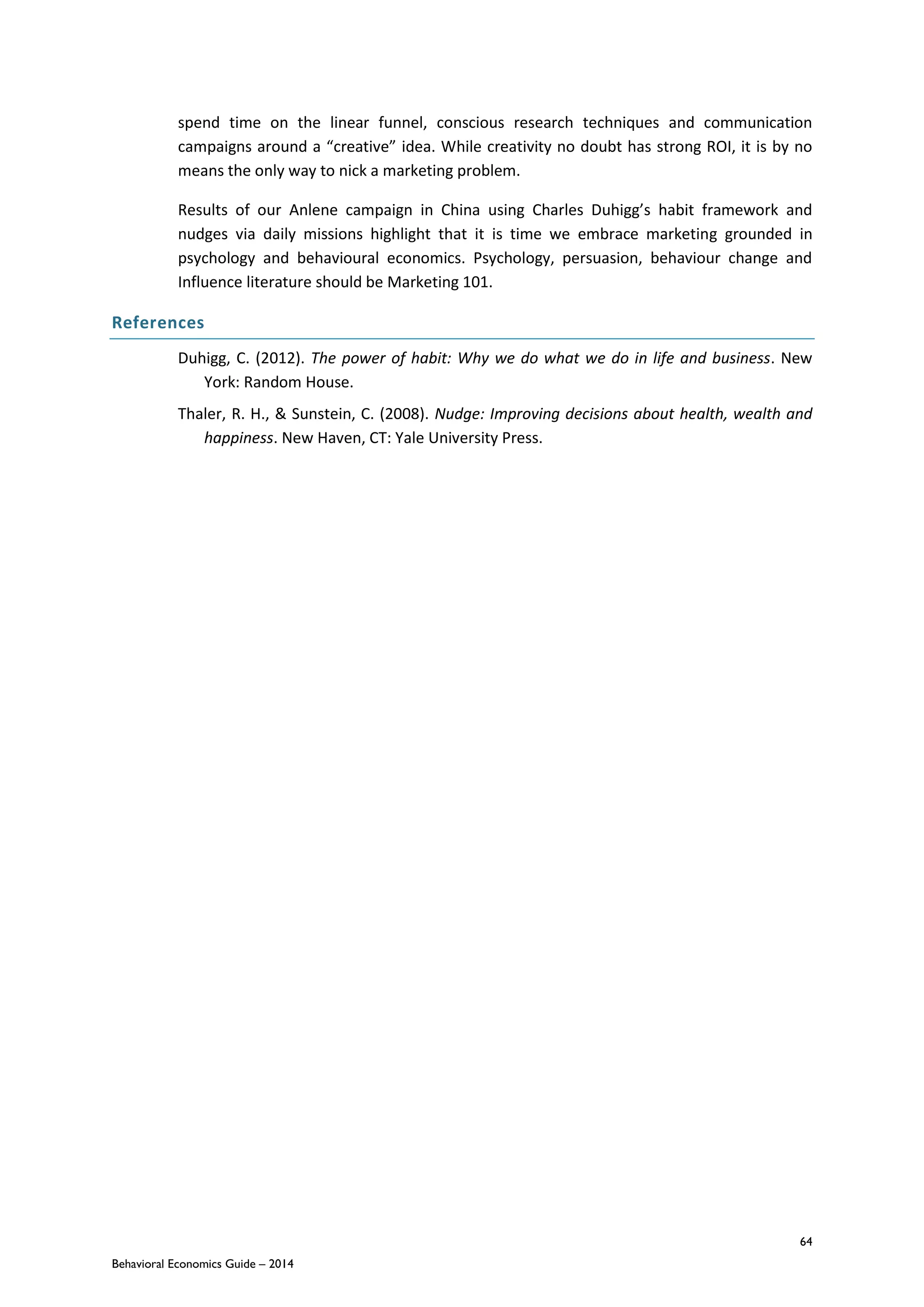

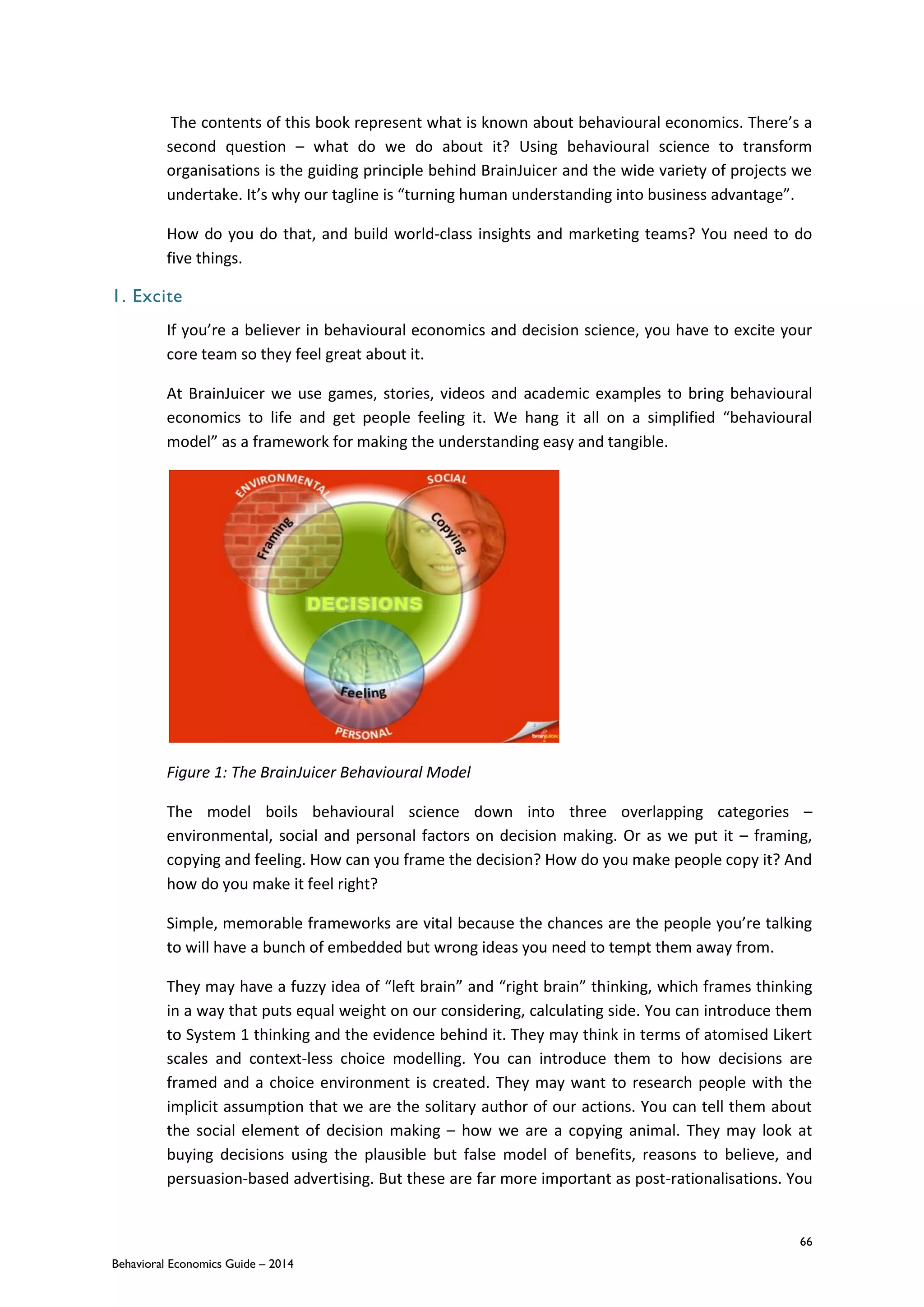
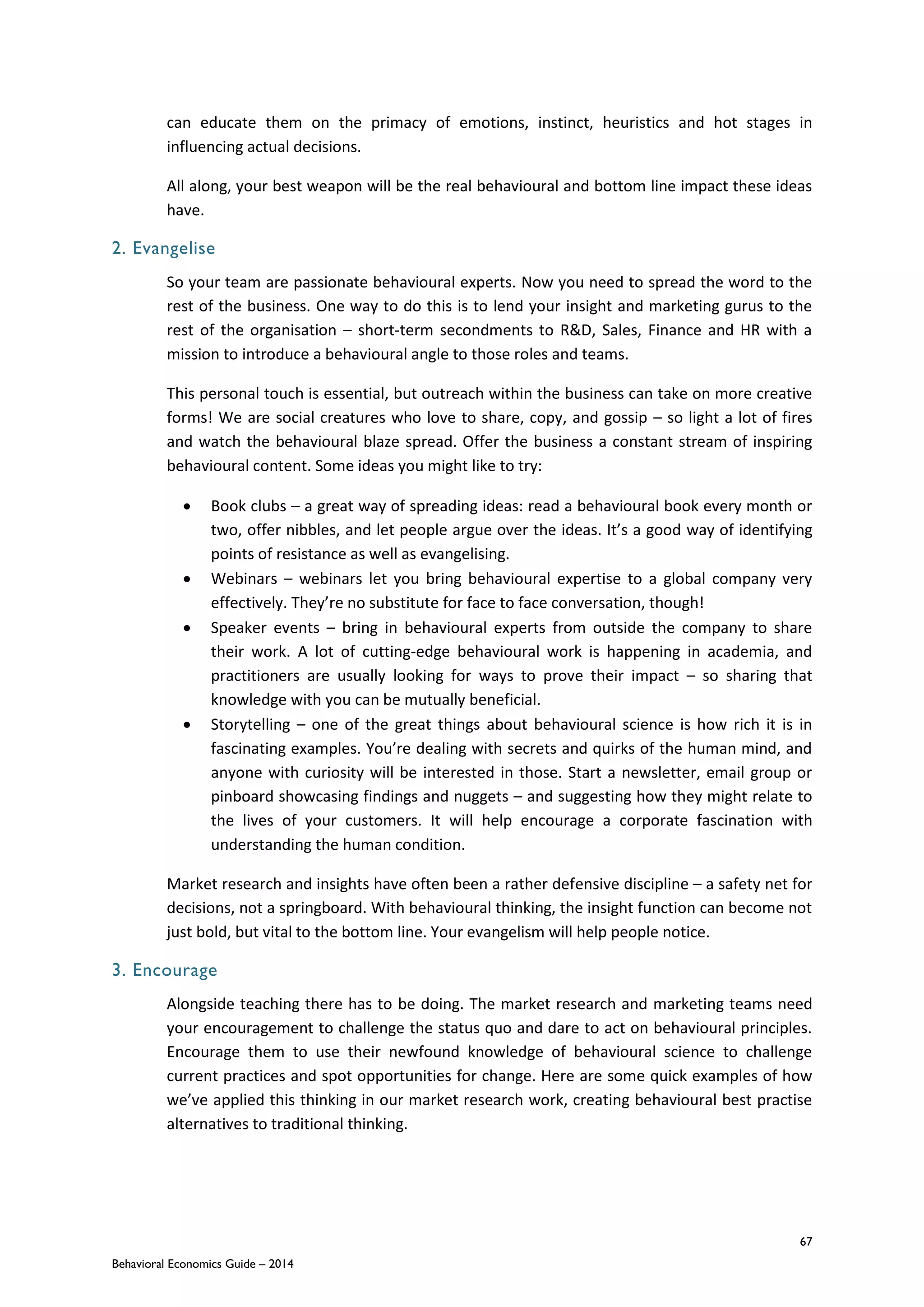
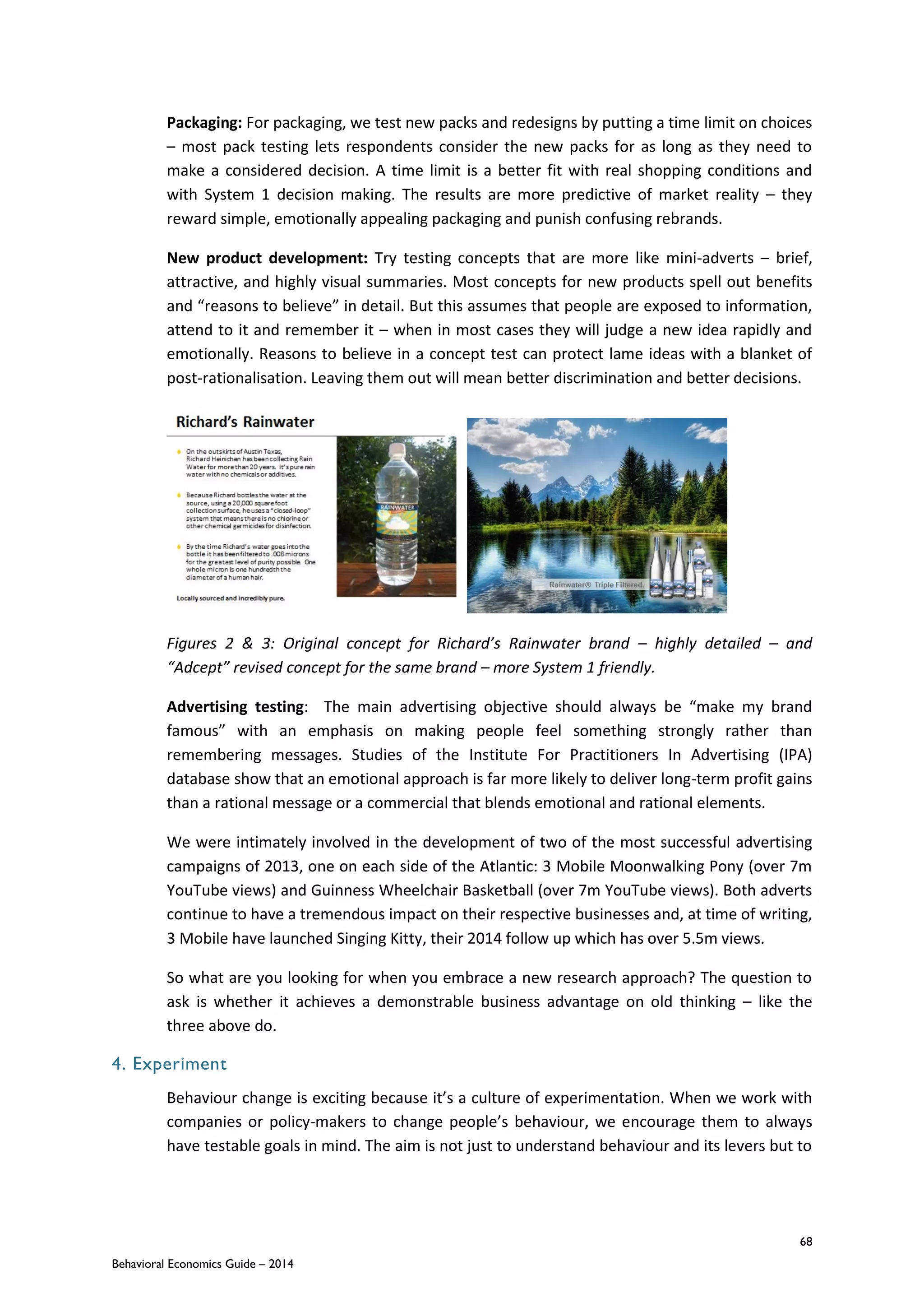
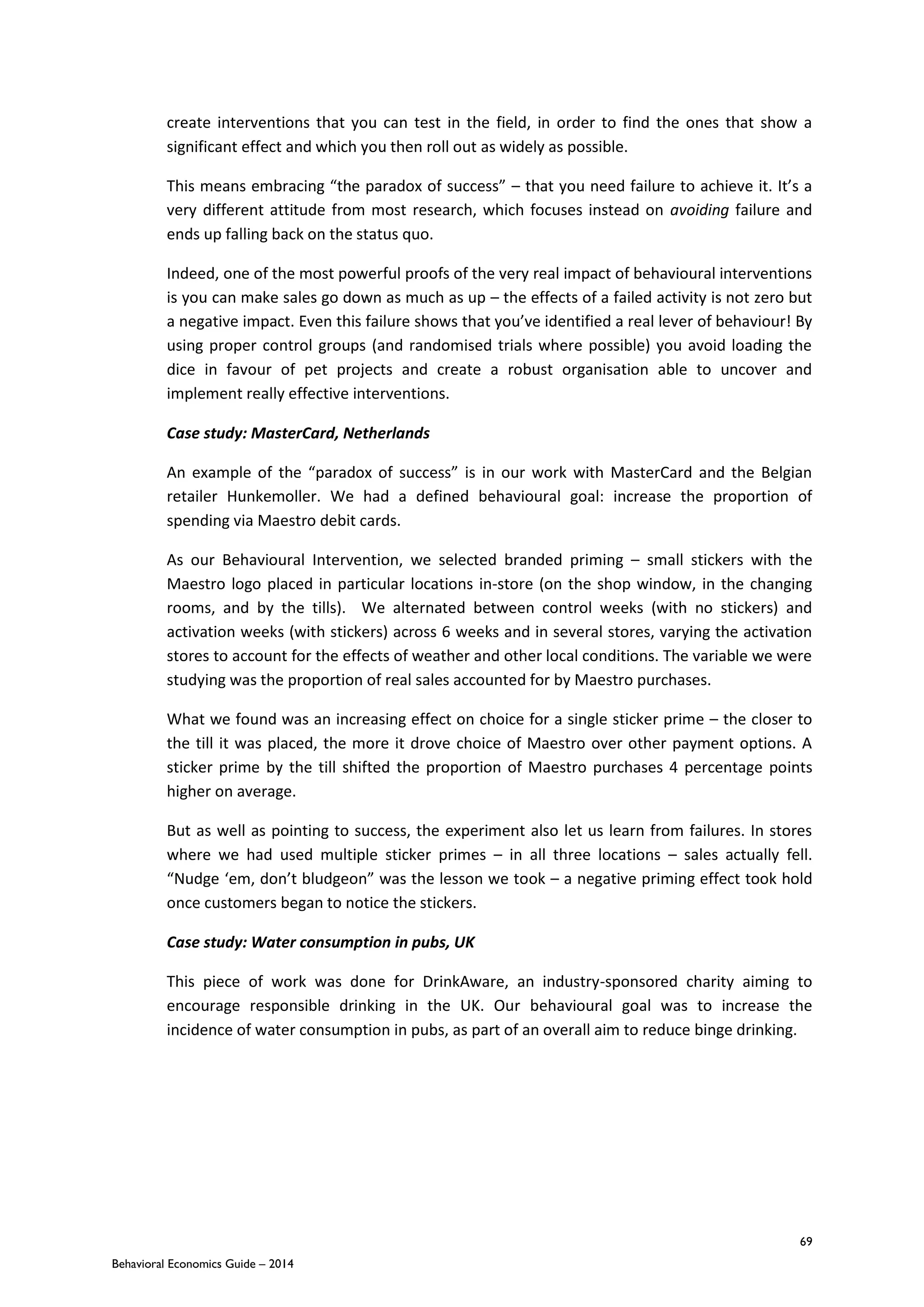
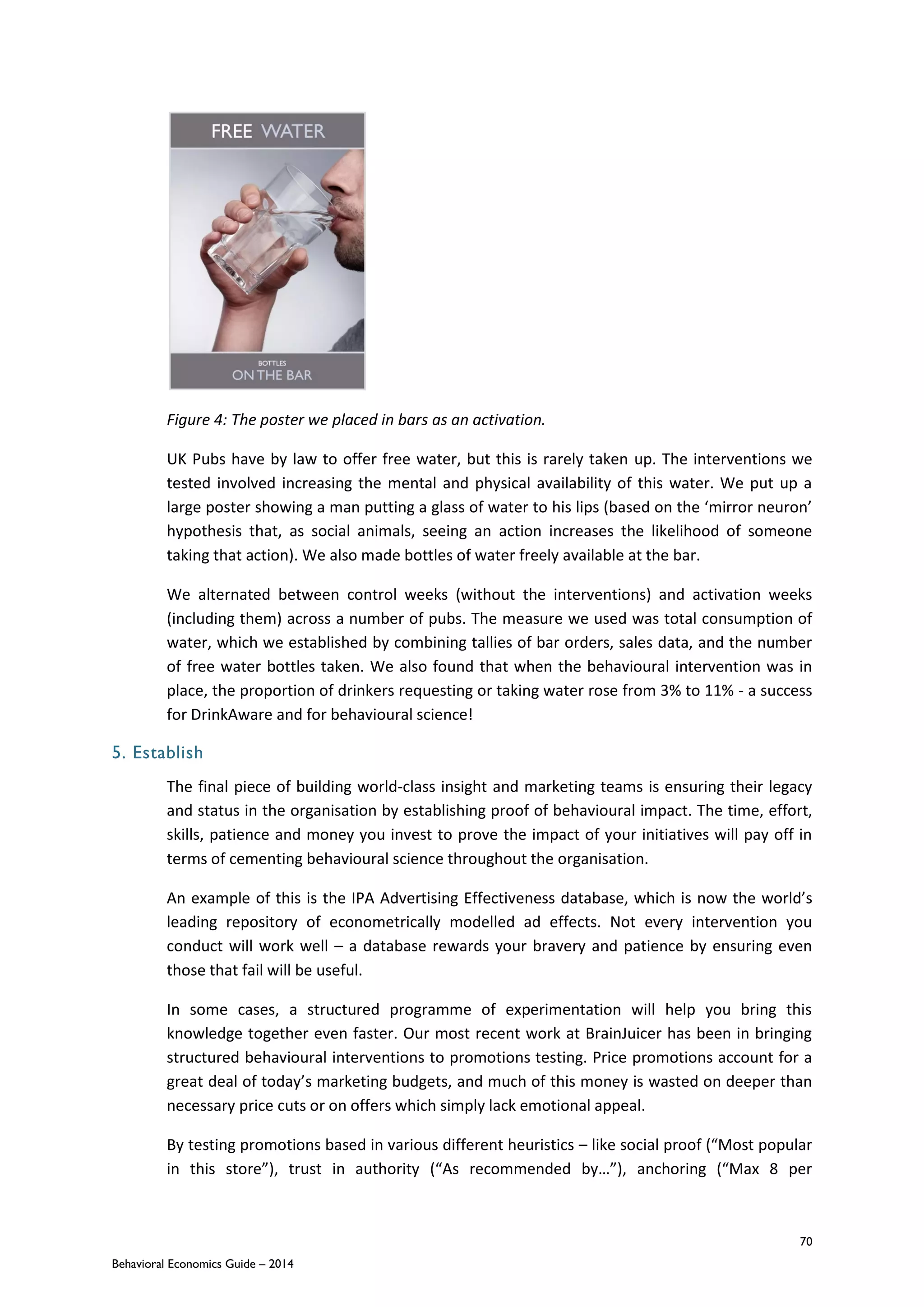
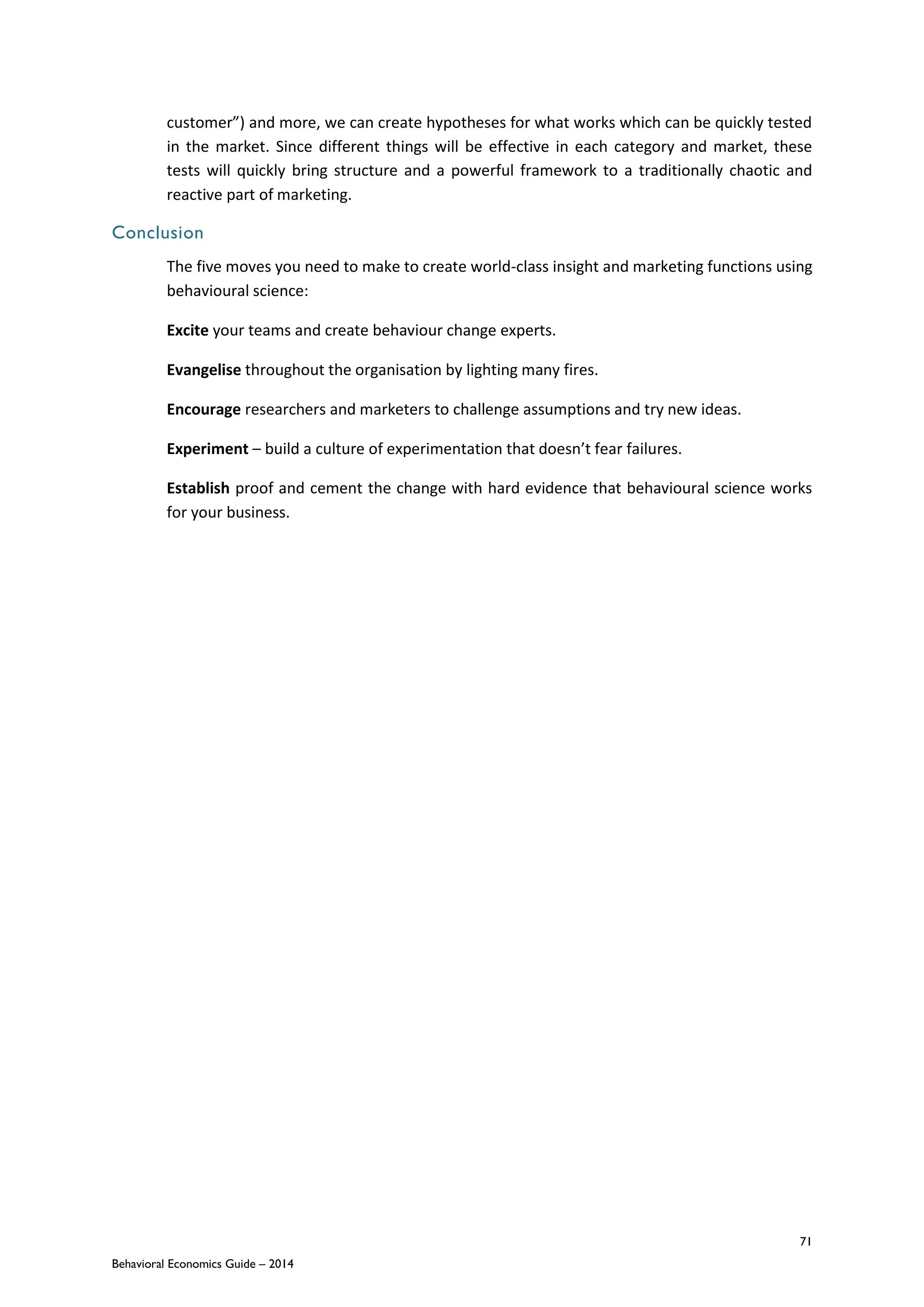
![72
Behavioral Economics Guide – 2014
The Power of Rank: Behavioural Insights into Product Pricing
Henry Stott, Decision Technology
(Author email: enquiries@dectech.co.uk)
Introduction
It’s one thing to acknowledge that brands need to pick the right price for a product. It’s quite
another to quell the bickering that then ensues. The finance department? They have an
econometrician who wants to put the prices up. The people in sales did some market
research that says the opposite. What to do? We will describe here how a strategy drawn
from both approaches but different to each can help to resolve such debates. We
demonstrate, too, influential pricing effects that typically pass unnoticed when using
traditional methods. Notably, we discuss how buyers are more ordinal than cardinal. That is
to say, they care more about how price ranks against competitors, and against other
reference points, than they do about the absolute price itself. An intuitive and innocuous
insight? Certainly. Yet it has profound implications for how to peg prices, design websites,
pitch promotions and so on.
Figure 1: Salary judgements
Small compensation
Take wages. To the American satirist H. L. Mencken1, “a wealthy man is one who earns $100
a year more than his wife’s sister’s husband.” What you earn matters less than whether it
trumps a crucial threshold.
1 From Mencken (2007 [1920]). Mencken was an American essayist referred to as the Sage of Baltimore. Some claim for a city that
spawned both Philip Glass and Oprah Winfrey.](https://image.slidesharecdn.com/beguide2014-140726231619-phpapp02/75/THE-BEHAVIORAL-ECONOMICS-GUIDE-2014-90-2048.jpg)
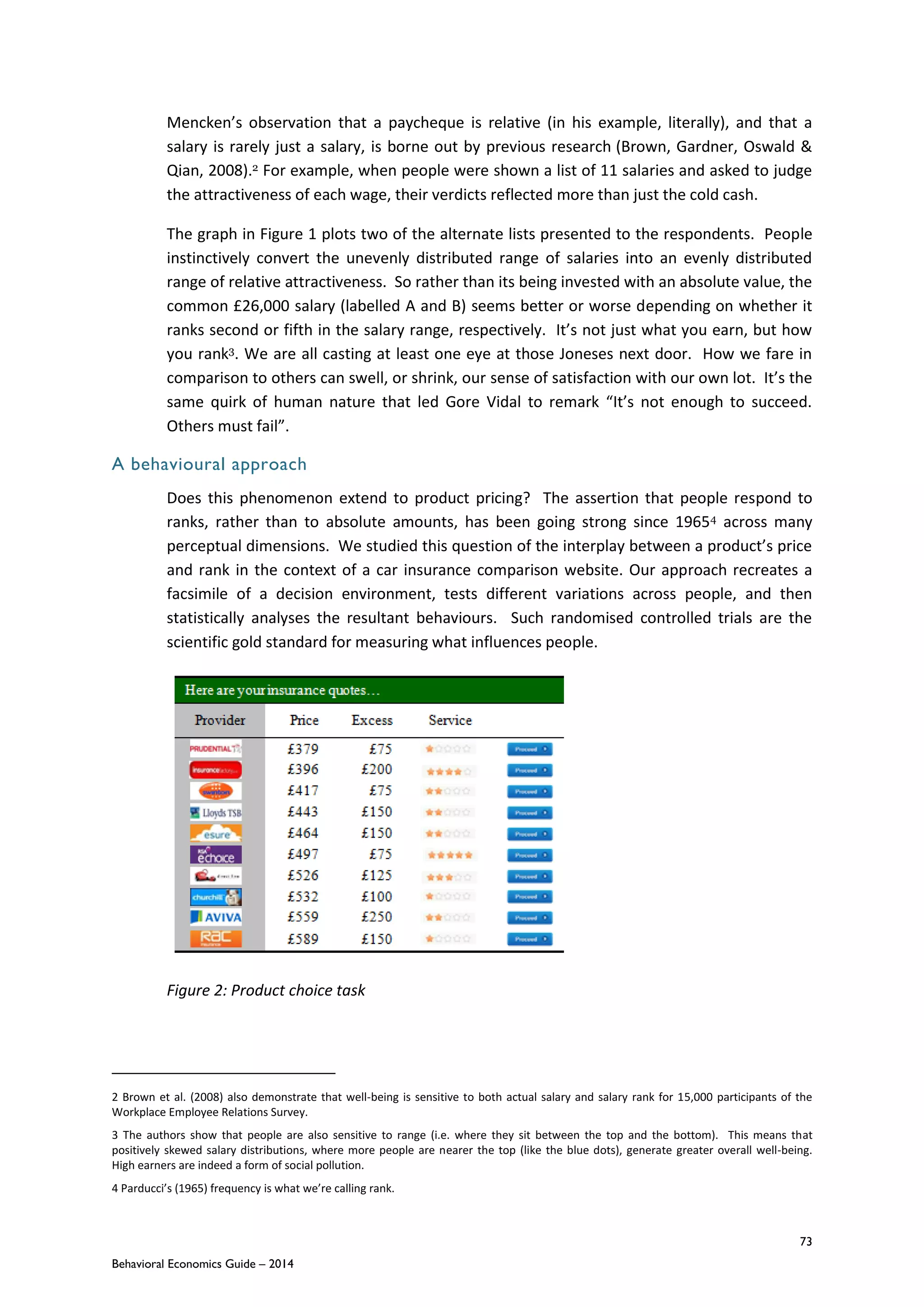
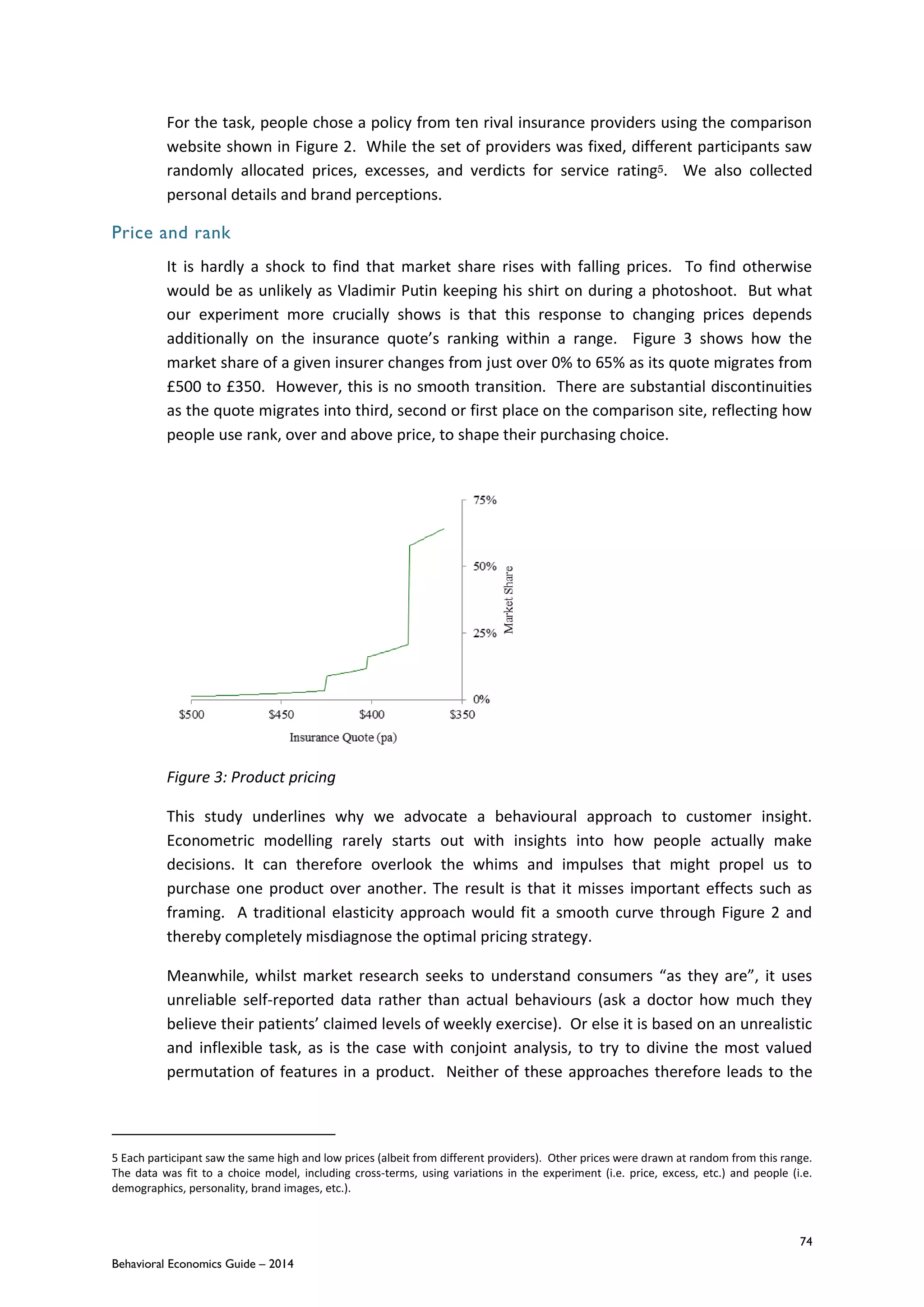
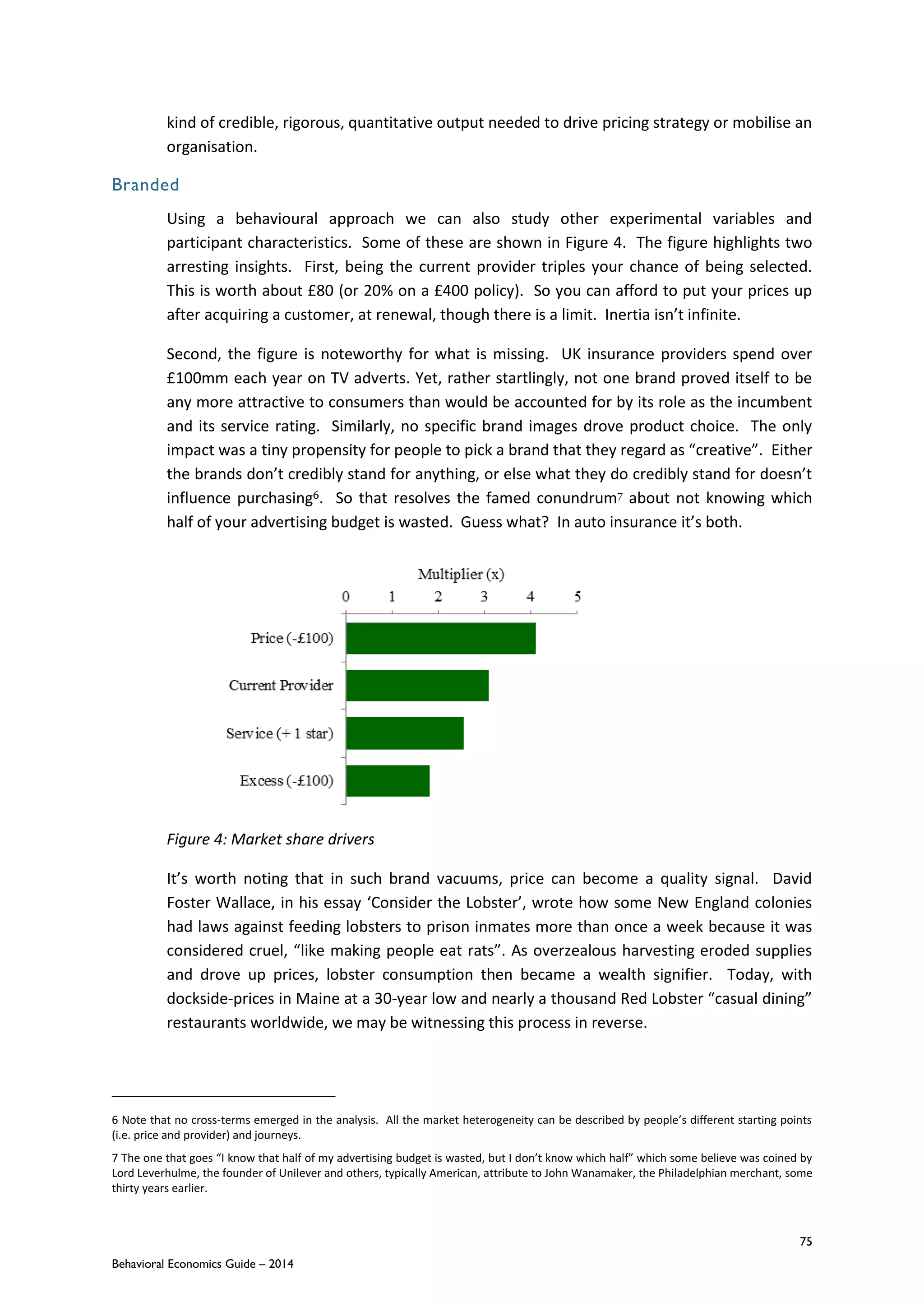
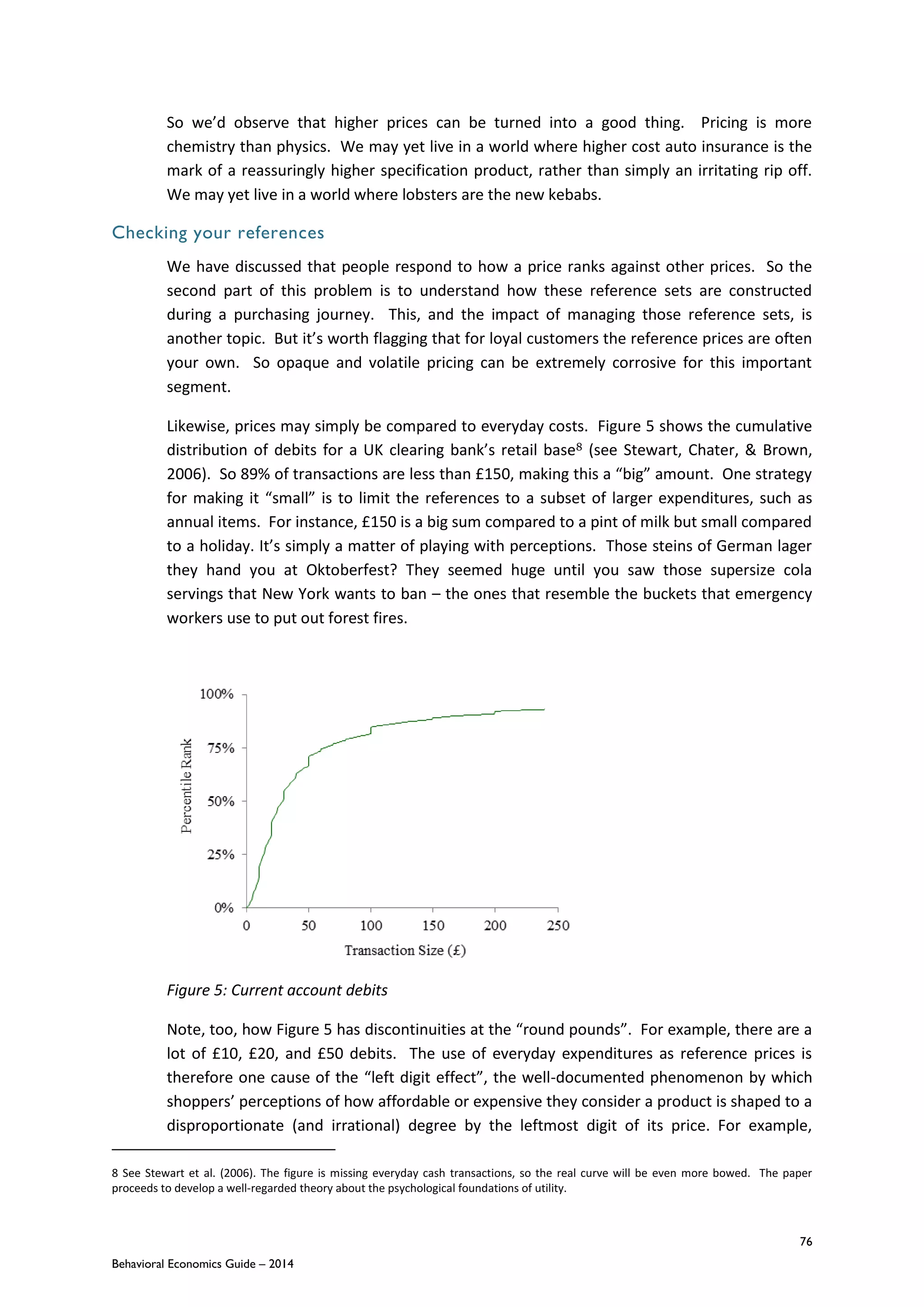
![77
Behavioral Economics Guide – 2014
cutting a £10 price to £9.99 yields a drop in rank on Figure 5 from 19th
to 13th
percentile
whereas going from £10.01 to £10 achieves no such shift9.
Summary
The research shows very clearly that brands need to fundamentally re-think their approach
to pricing:
References: Insight teams need to understand where customers are going for price
information and what references they bring to a decision.
Touchpoints: Sales teams need to review how they can influence that process by changing
web design, renewal letters, call centre scripts, and so forth.
Pricing: Pricing teams need to overhaul their modelling to address the fundamental non-
linearity and instability of customer price elasticity.
The behavioural approach we’ve described represents an important tool for addressing this
last issue because it plugs a gap. It offers a facsimile of the decision environment so
companies can explore the impact of changing prices, promotions, bundling, product design,
brand, sales process and so forth. Moreover, it’s cheaper, quicker and more diagnostic than
field testing or sales modelling, enabling companies to pre-test a wider range of alternatives
on a tighter development cycle. It offers, too, a safe environment in which to study and
refine higher risk strategies, ring-fenced away from the brand. Finally, it may well be the
only way to get sales and finance into the same room without all that unpleasantness.
References
Brown, G. D. A., Gardner, J., Oswald, A. & Qian, J. (2008). Does Wage Rank Affect Employees’
Well-being? Industrial Relations, 47(3), 355-389.
Mencken, H. L. (2007 [1920]). A Book of Burlesques. Whitefish, MT: Kessinger Publishing.
Monroe, K. B. (2003). Pricing: Making Profitable Decisions. New York: McGraw-Hill.
Parducci, A. (1965). Category Judgement: A Range-Frequency Theory. Psychological Review,
72(Nov), 407-418.
Stewart, N., Chater, N. & Brown, G. D. A. (2006). Decision by Sampling. Cognitive Psychology,
53(1), 1-26.
9 For a review of the left digit effect and prices ending “9” see Monroe (2003).](https://image.slidesharecdn.com/beguide2014-140726231619-phpapp02/75/THE-BEHAVIORAL-ECONOMICS-GUIDE-2014-95-2048.jpg)
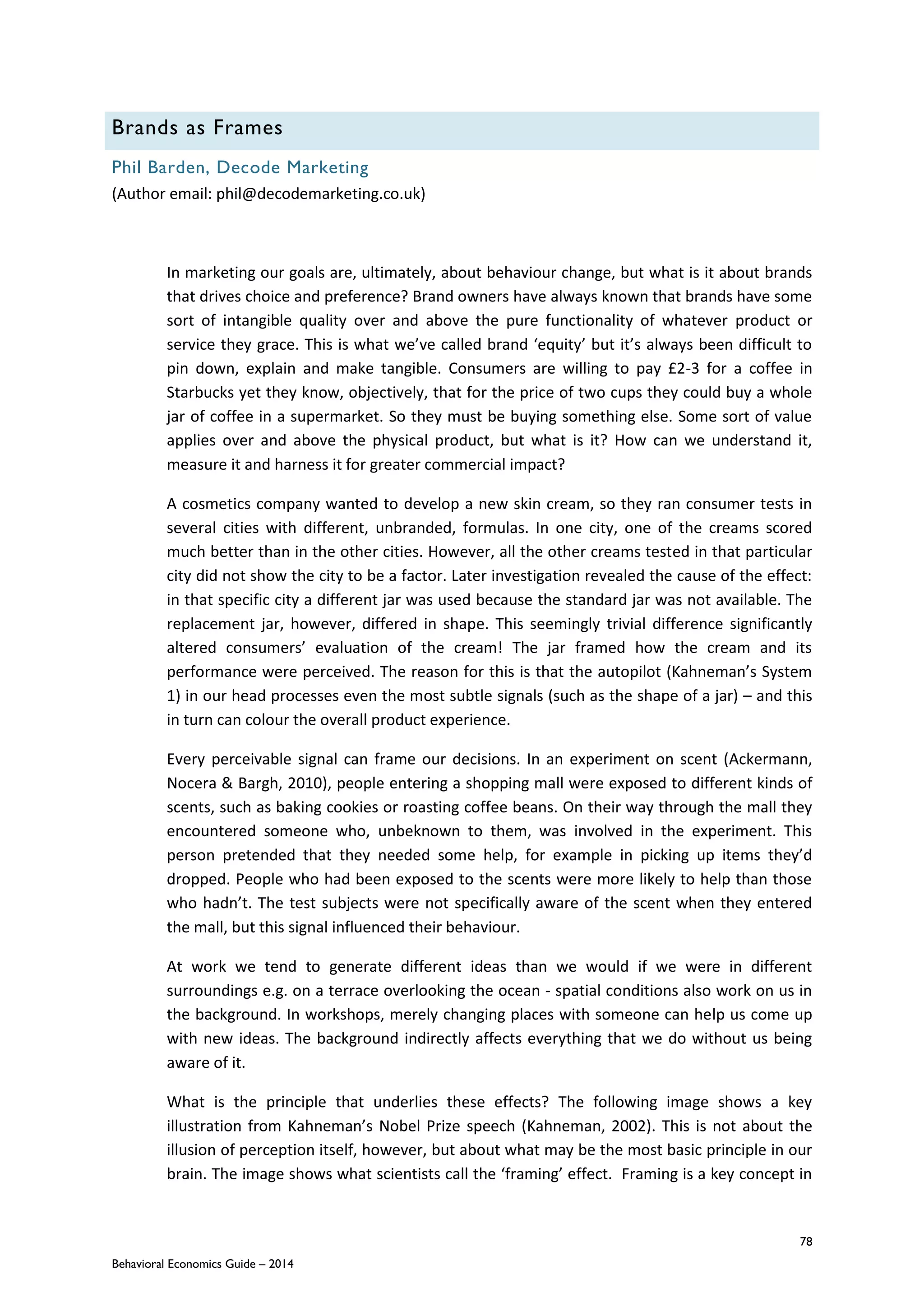

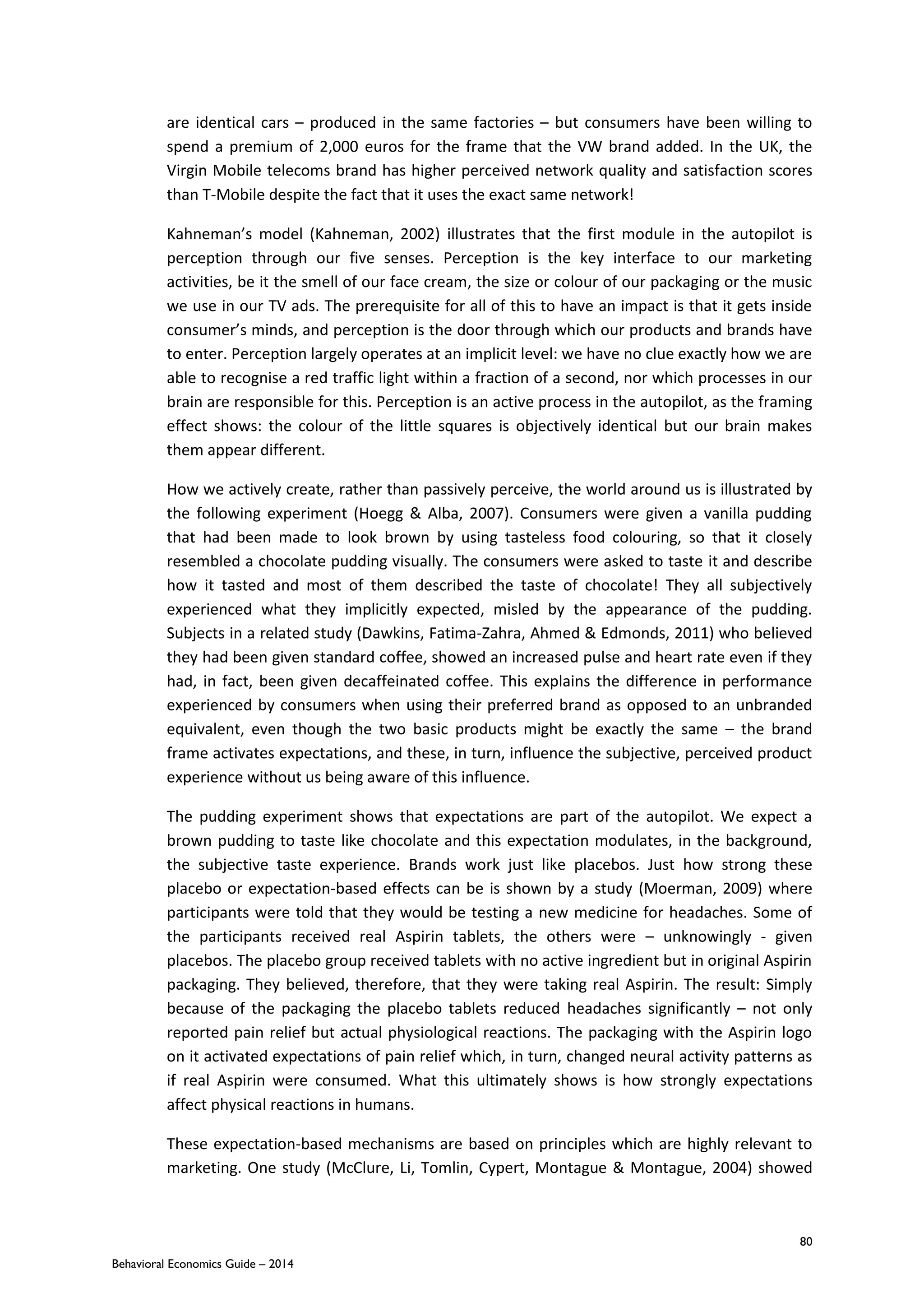
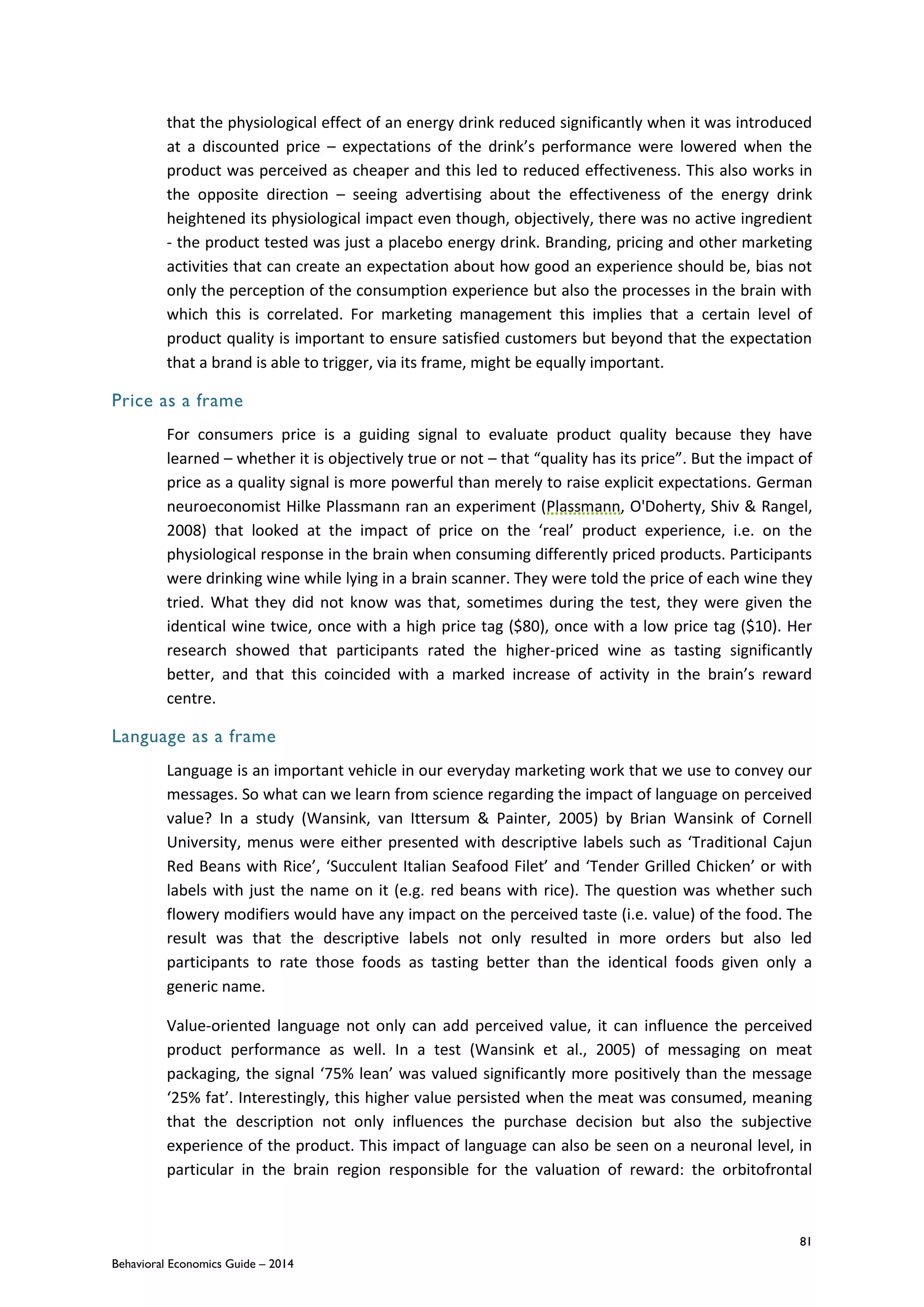
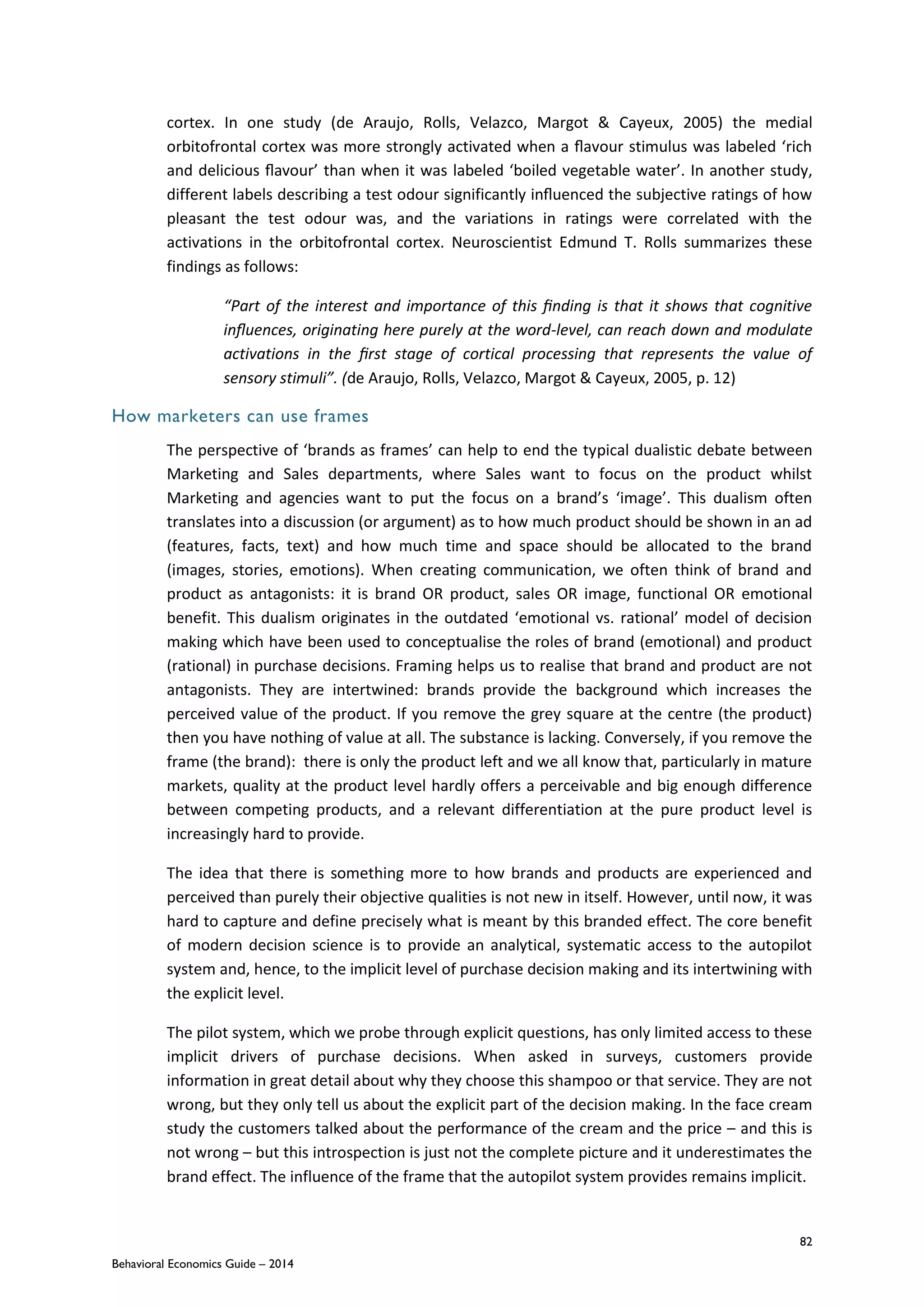
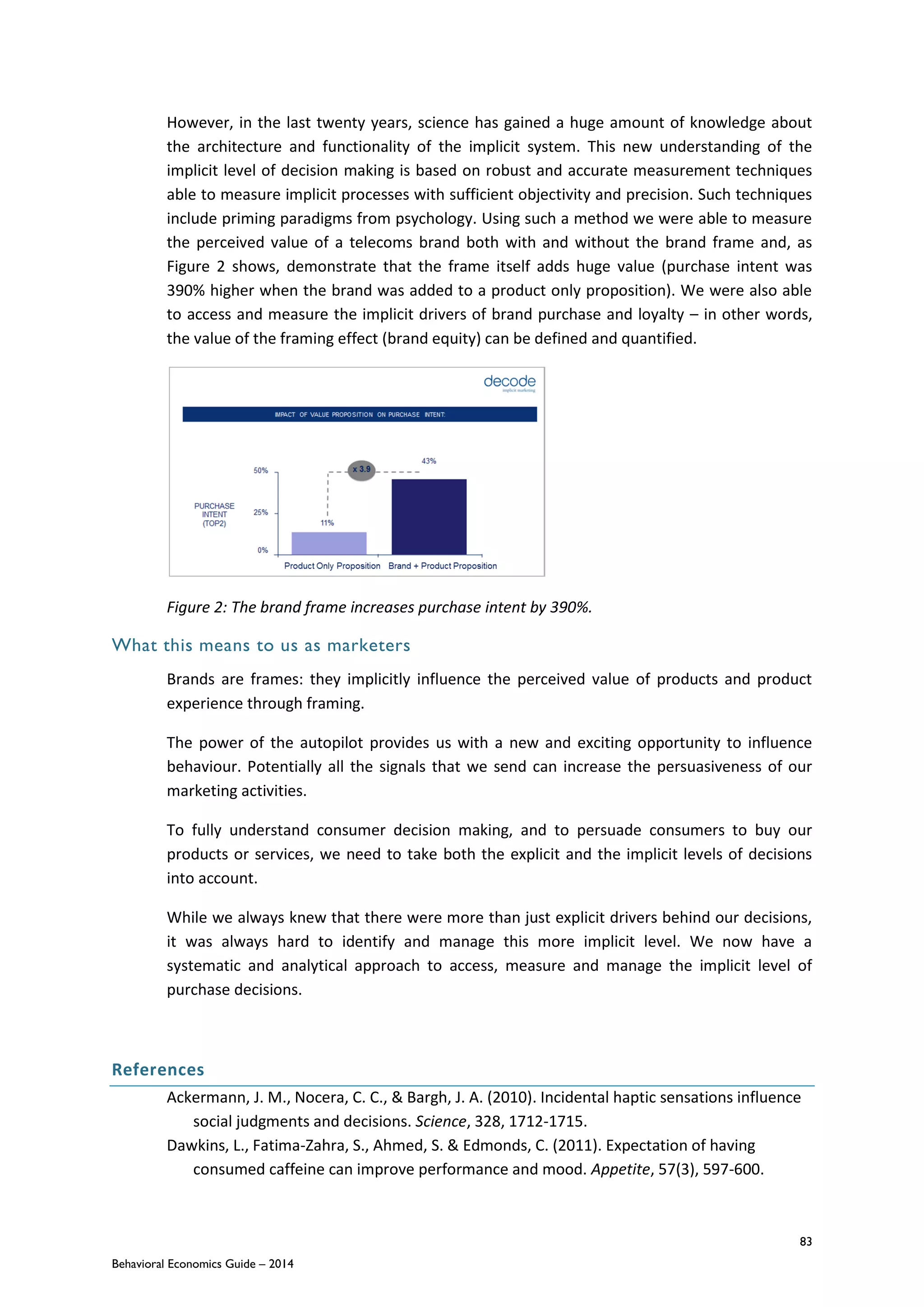
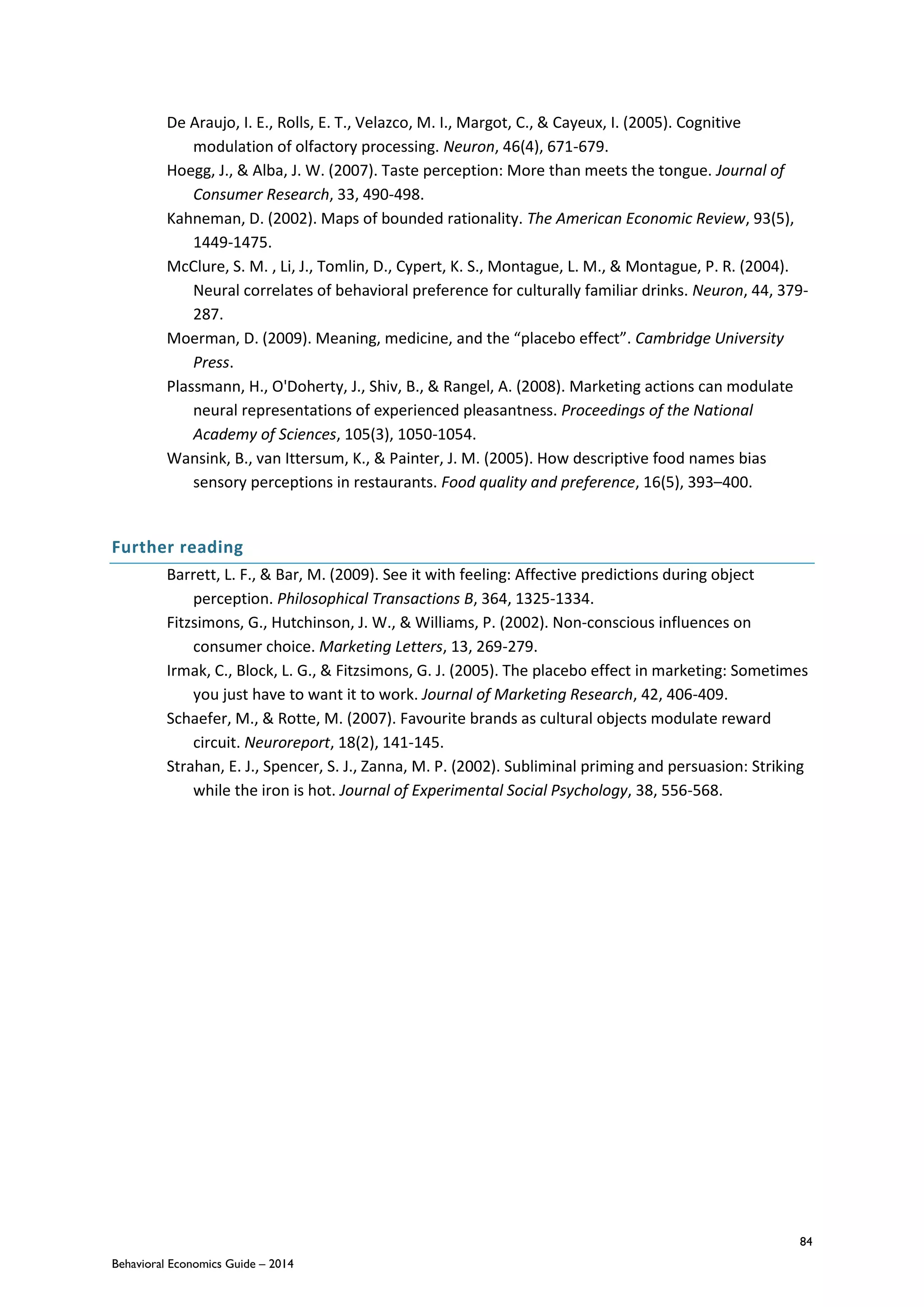
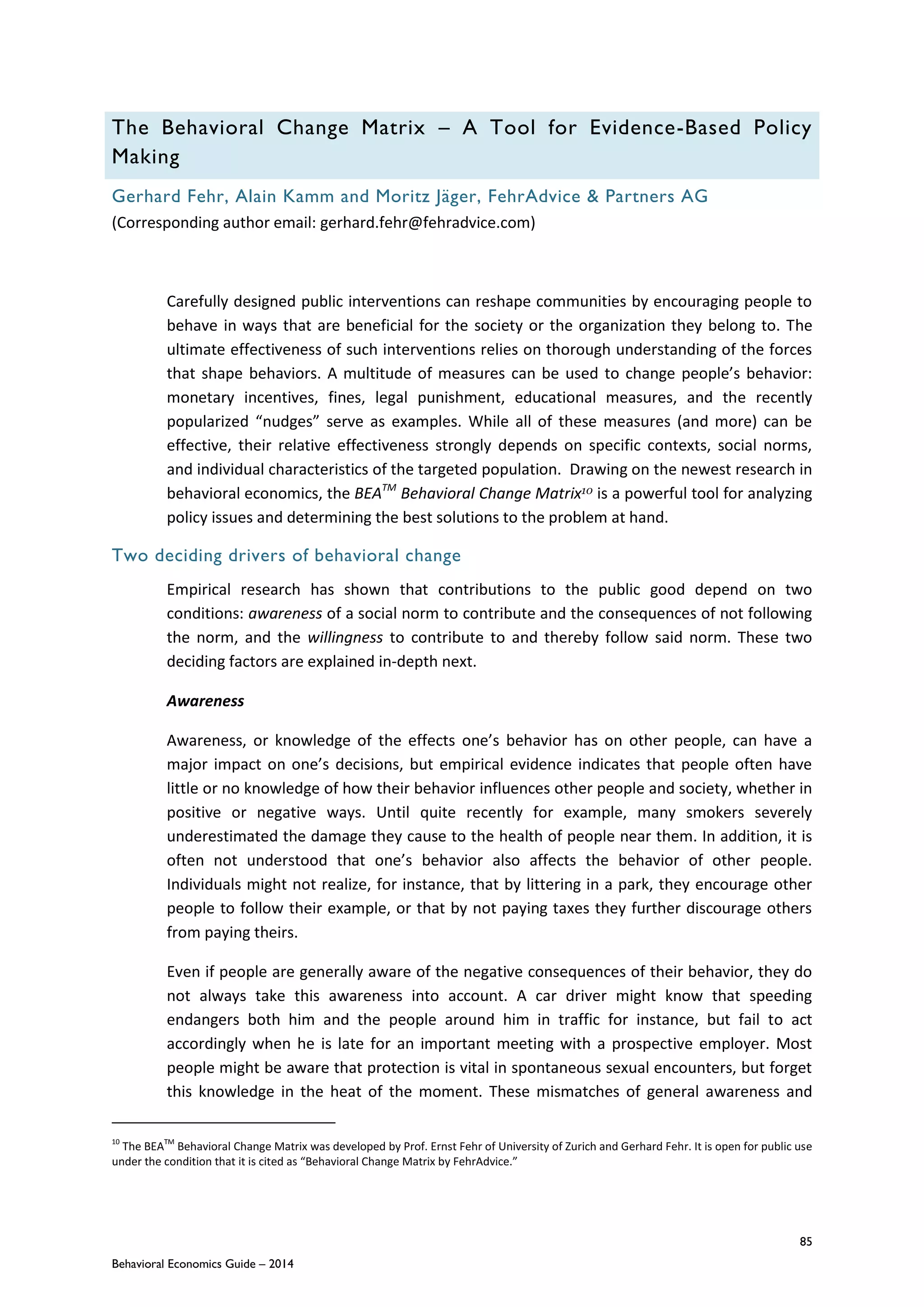
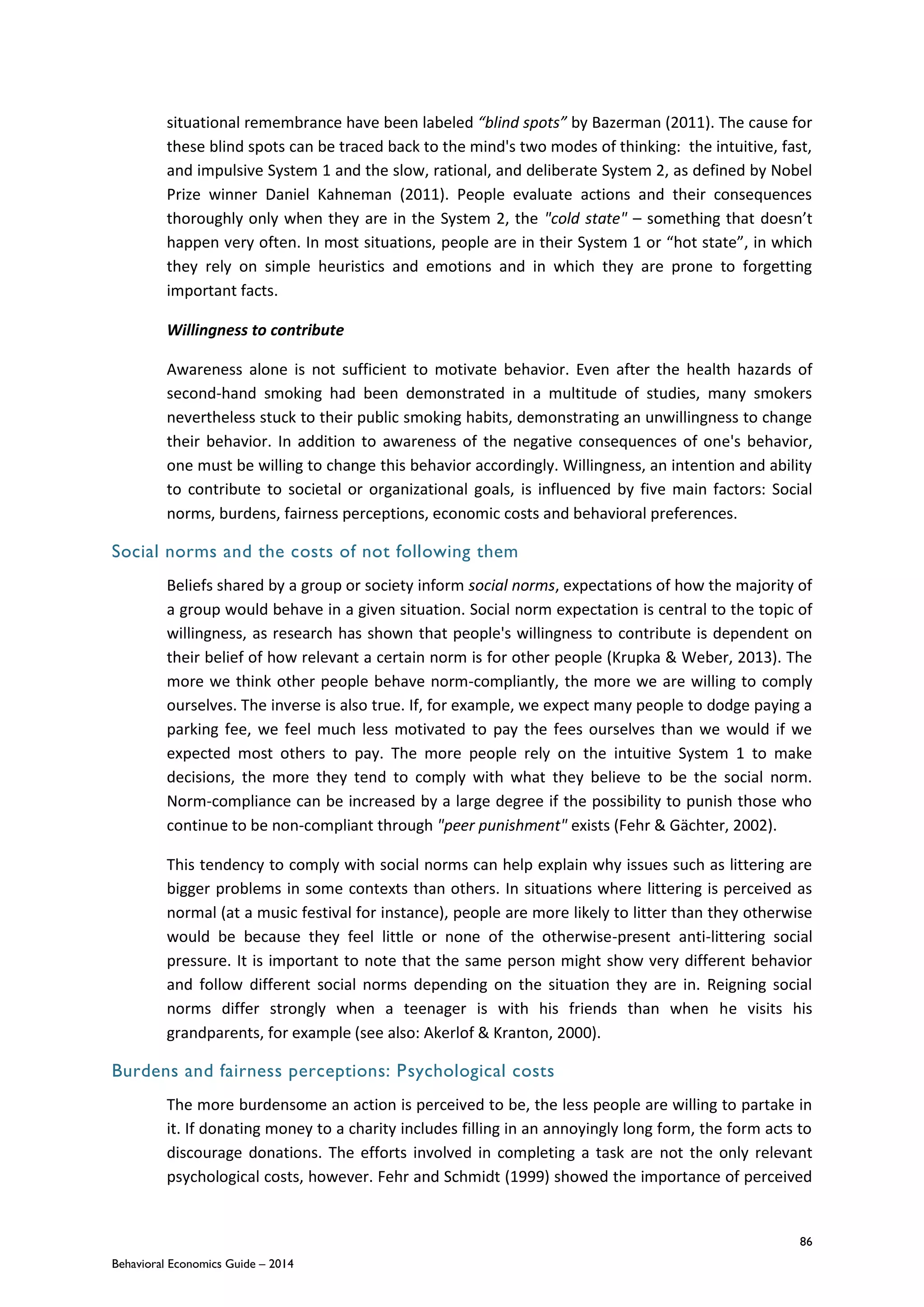
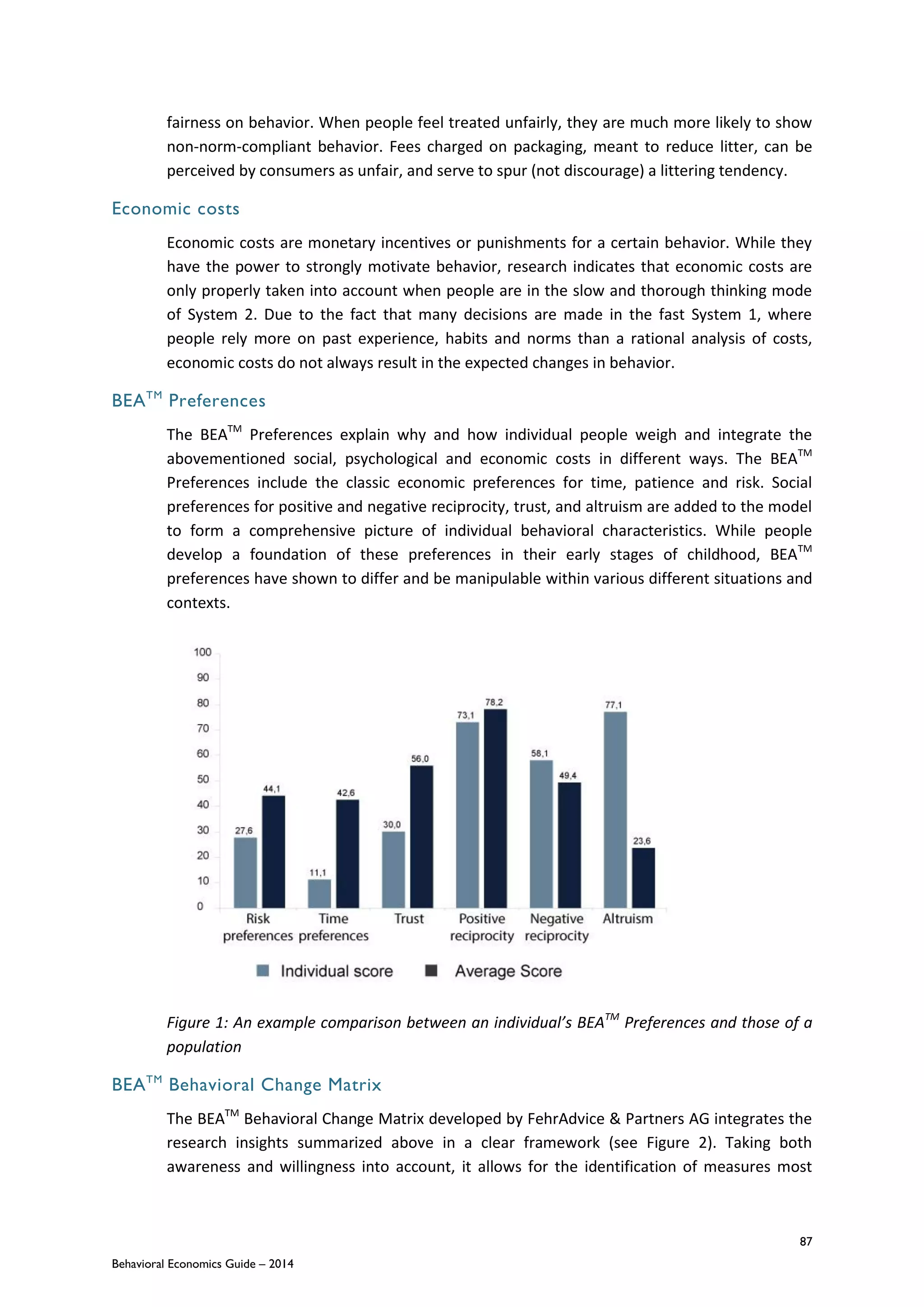


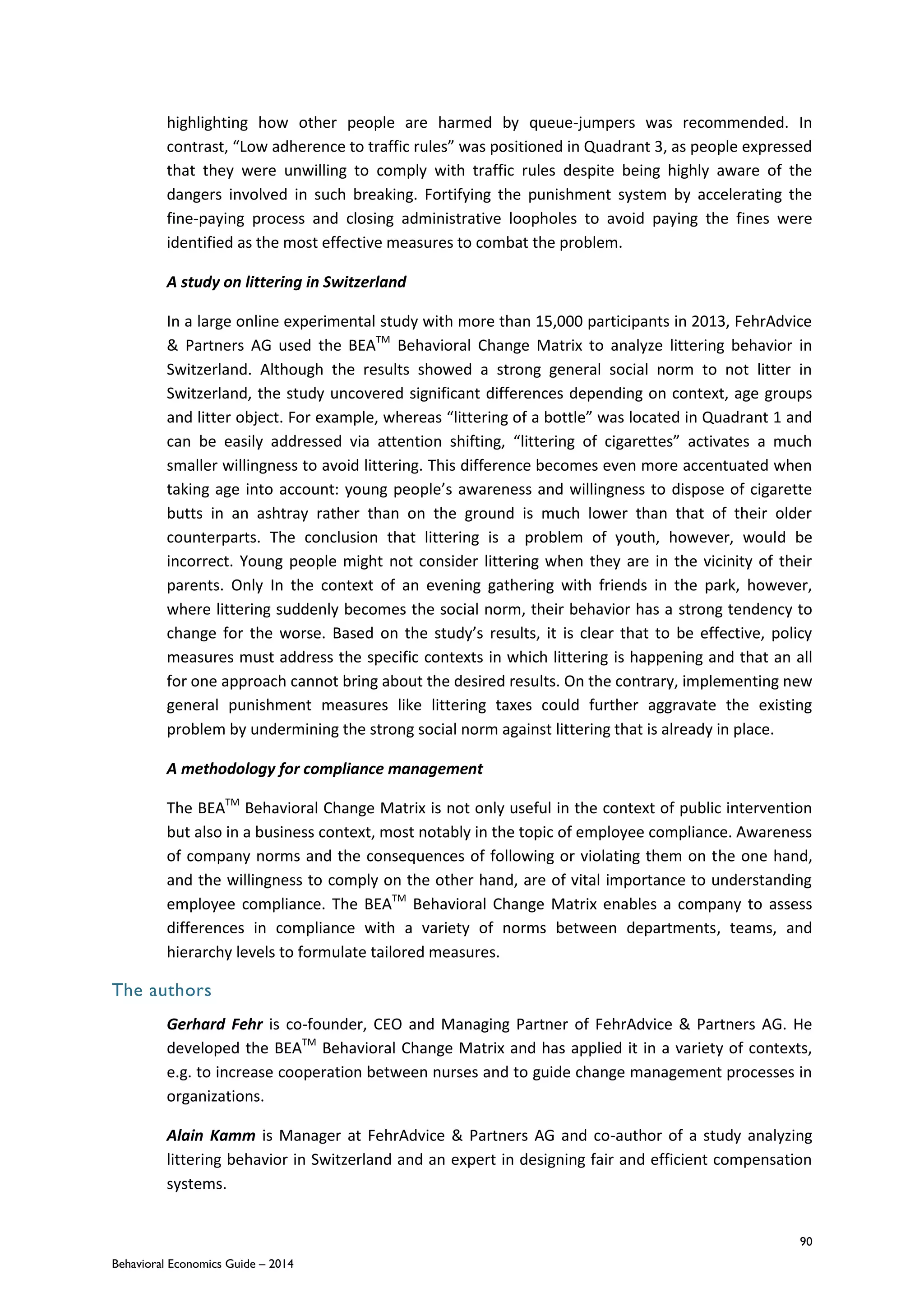
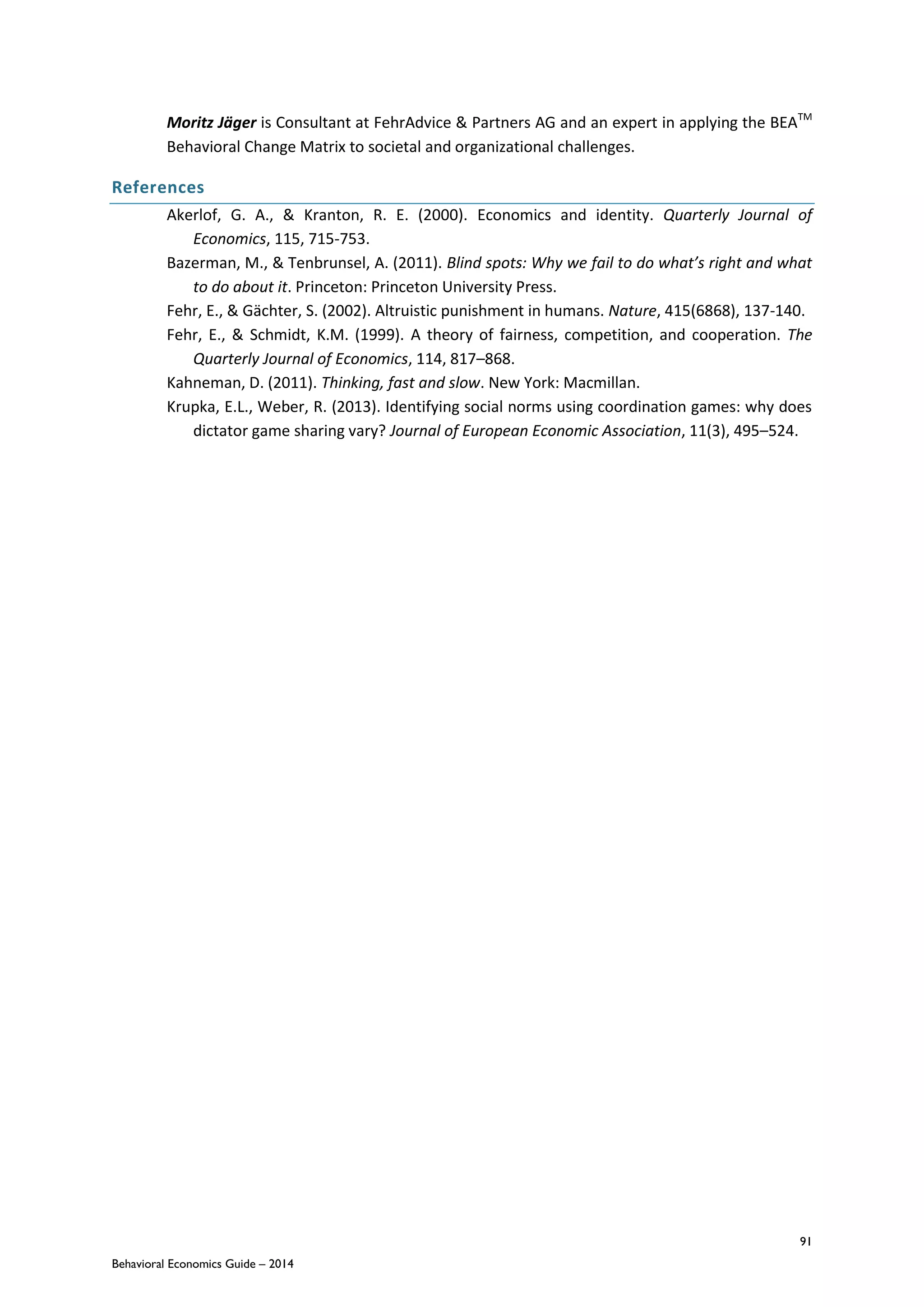
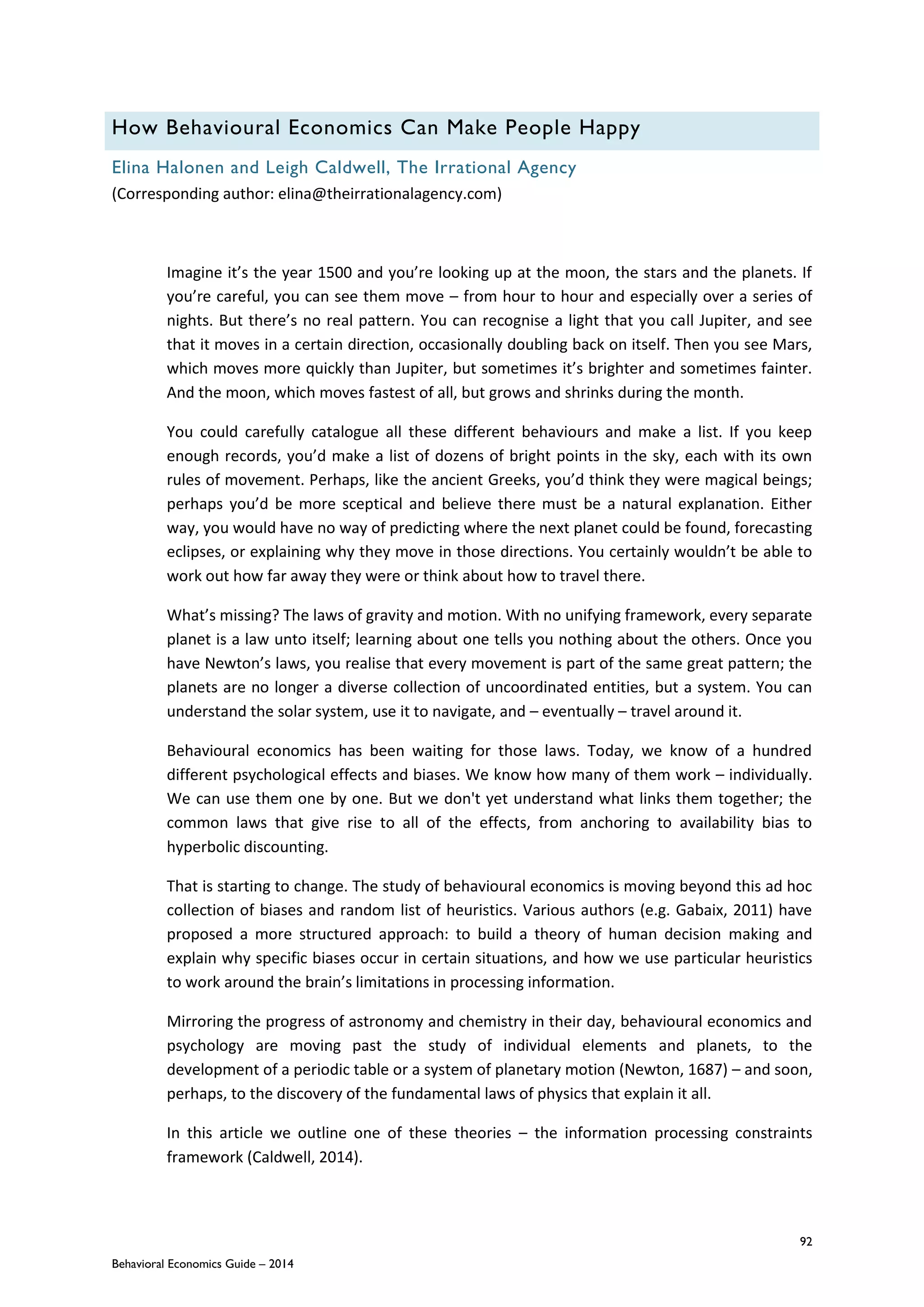


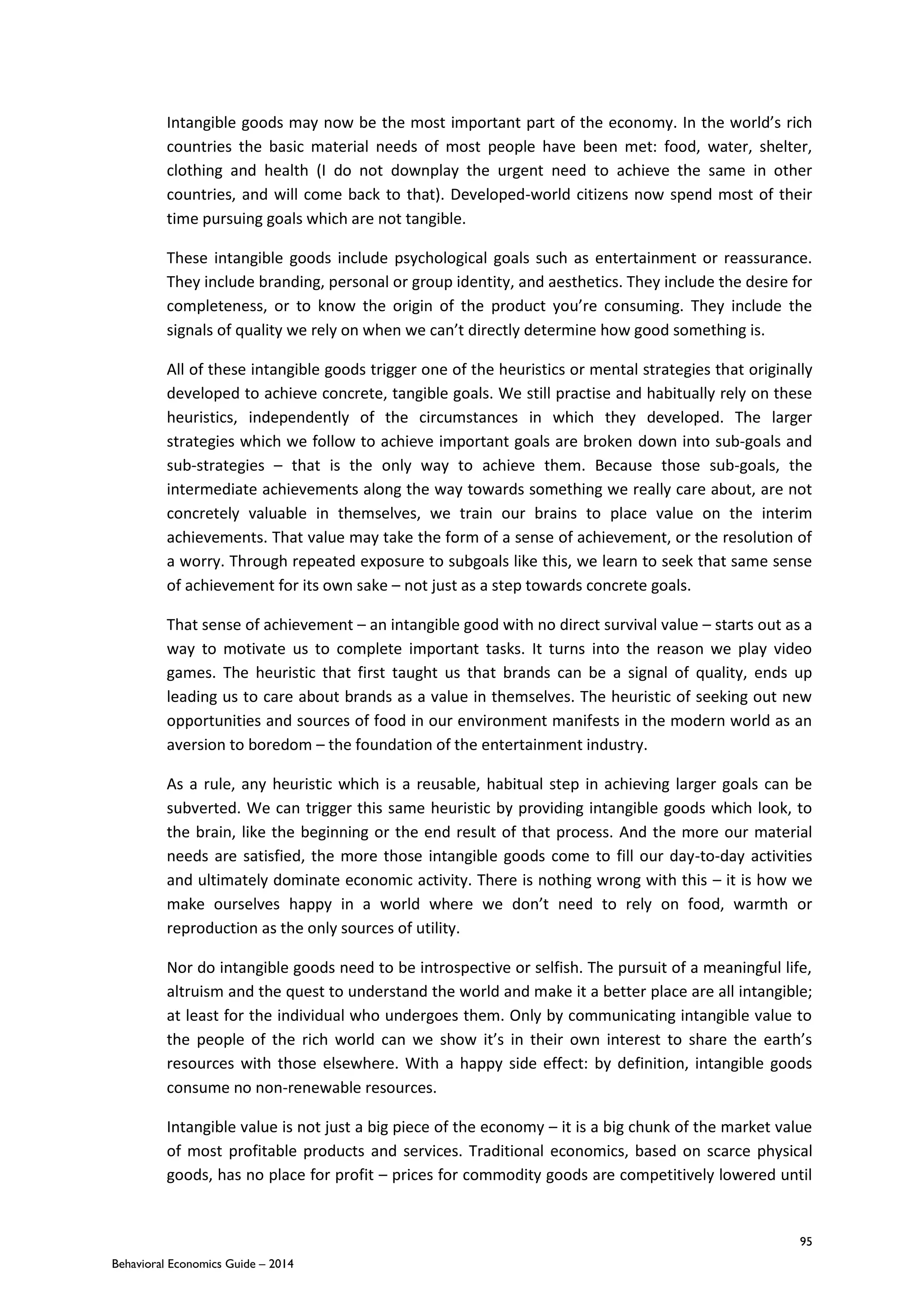
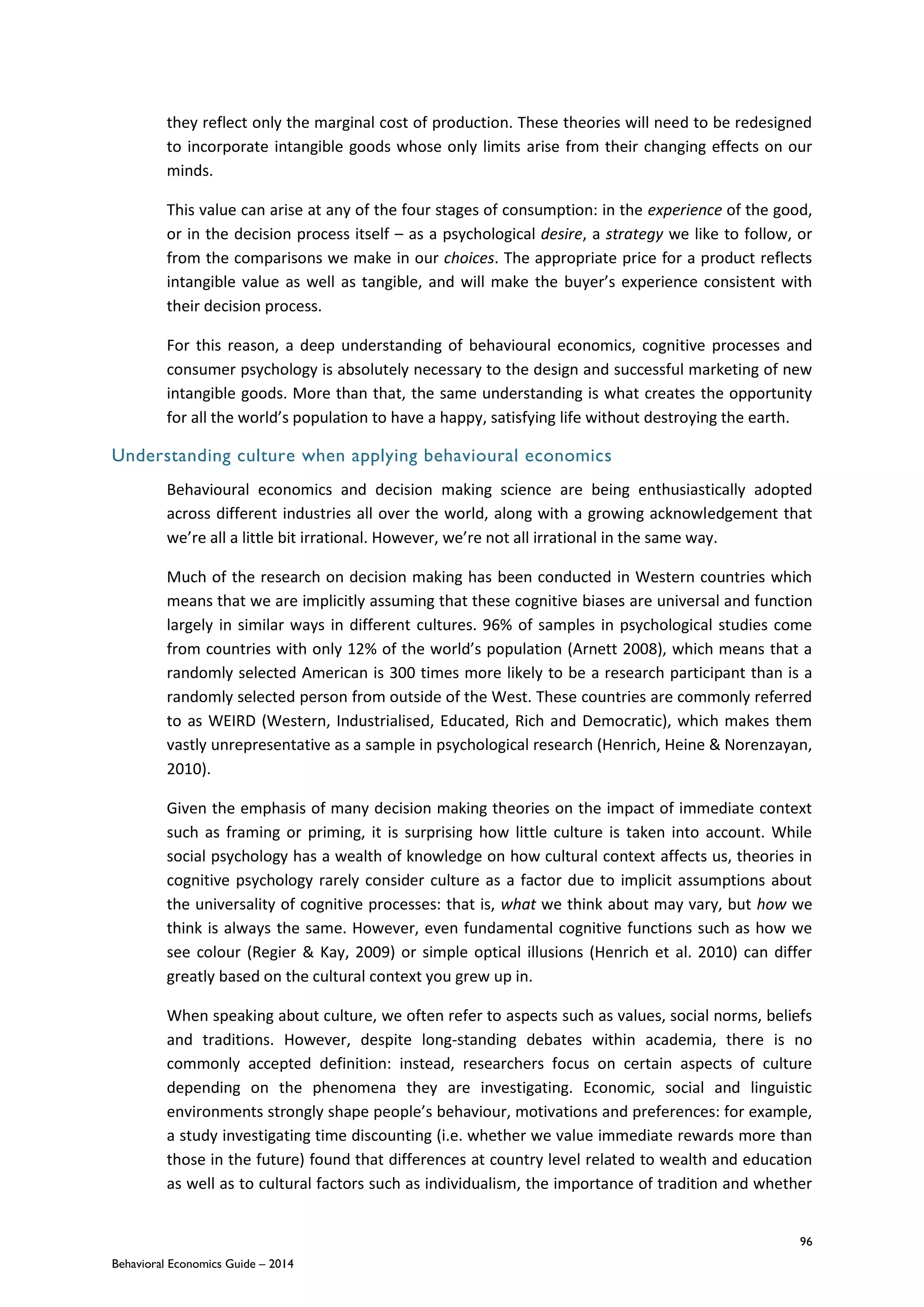

![98
Behavioral Economics Guide – 2014
how we choose which can lead to seemingly irrational behaviour (Read & Loewenstein,
1995). However, the majority of research on this effect has been conducted in Western
countries, especially the US, where personal choice is one of the key cultural values.
When choice is an act of self-expression, it becomes hugely important for the individual, and
the psychological impact of either lack of choice or failed choice is larger, leading to
strategies such as variety-seeking. In collectivistic cultures choice is often an interpersonal
task, so making a choice that portrays oneself in the most positive light is not as big a
concern. Subsequently, research has shown the diversification bias to be weaker in these
cultural contexts (Kim & Drolet, 2003).
Self-concepts also affect the strength of another well-known behavioural economics
concept: the endowment effect, where simply owning an object enhances its perceived
worth, and owners value objects substantially (and irrationally) more than potential buyers
do. Because owning an object activates an association between it and the self, the Western
focus on self-enhancement means this association automatically boosts the object’s value.
Therefore, the strength of the endowment effect is influenced by the degree to which self-
enhancement is culturally valued, with recent research suggesting that the effect is indeed
stronger in a Western context (Maddux et al. 2010). In practice this means that sales tactics
such as free trial or “bait and switch” may be less effective in non-Western contexts with
weaker endowment effect combined with weaker cognitive dissonance.
Understanding the potential cultural influences on thought is crucial for everyone
attempting to accurately describe and predict consumers’ decision making. Insights from
behavioural economics might well be applicable in different cultures, but we need to have
highly nuanced sense of the specific characteristics of each cultural context and its impact on
consumer decision making to ensure effective applications. As Dan Ariely notes (Ariely,
2013), the biggest challenge for behavioural economics in the next 10 years is understanding
the generality of the findings so far and to what extent the effects discovered carry over in
different contexts. As we gradually abandon the error of rationality, we should not entrench
a new mistake: universality.
This section includes some abridged material from ‘Globally irrational or locally rational?’
(2013) in Research World.
References
Ariely, D. (2013, August 17). Research Heroes: Dan Ariely. [InDecision]. Retrieved from
http://indecisionblog.com/2013/08/17/research-heroes-dan-ariely/
Ariely, D., Loewenstein, G. & Prelec, D. (2006). Tom Sawyer and the construction of value.
Journal of Economic Behavior and Organization, 60(1), pp. 1-10.
Fehr, E. & Gächter, S. (2000). Cooperation and punishment in public goods experiments. The
American Economic Review, 90(4), pp. 980-994.
Arnett, J. (2008). The neglected 95%: Why American psychology needs to become less
American. American Psychologist, 63(7), 602-614.](https://image.slidesharecdn.com/beguide2014-140726231619-phpapp02/75/THE-BEHAVIORAL-ECONOMICS-GUIDE-2014-116-2048.jpg)
